In the eight years we have been here, the landscape has never bleached to this degree. In the most part our West Country moisture has kept the fields green, but the heat and month or more without rain has had its influence. A blond horizon backdrops the garden where the Tump hasn’t re-grown after the hay cut, and the high fields around us throw a September light which, at the beginning of August, has been disorientating.
Past summers have only required me to water once or twice during the season, but this year the new planting has needed it more often and I have worked the beds with a fortnightly drench to encourage the roots down by soaking each pass deeply. The watering has done nothing for the fissures which have opened up in the beds. Some are wide enough to put your hand down to the wrist and have got me thinking that, if I had the time, this would be a perfect way of working a summer injection of humus deep into the ground, if I could feed it into the cracks. It would plug the gaps that sometimes run straight through root balls and help to protect roots which must be feeling the drought more directly for this exposure. Deep in the beds, where the planting is already closed over, they worry me less, but in the new planting where the local microclimate provided by companionship is not quite there, I am seeing the damage.
Those plants that are adapted to a hot, dry summer have shown their roots in simply not flinching and the thistles have been notable. Miss Willmott’s Ghost, the biennial Eryngium giganteum, is luminous in the truest sense of the word. Firing starry outbursts amongst the Bupleurum falcatum the growth is platinum white in bright light. This is only the second or third generation of self-sown seedlings and, so far, the volunteers have not become a problem in the gravel garden. I have had them take over in thin ground, where they have seized a window amongst perennials that have not taken to the conditions as heartily, so we will yet see if they are going to make a takeover in the gravel by the barns. If they do, it will be where the seedlings find their way into the crowns of perennials that are slow off the mark in the spring. Like a wedge splitting a boulder, they can, and do, have their influence in their pioneering nature.
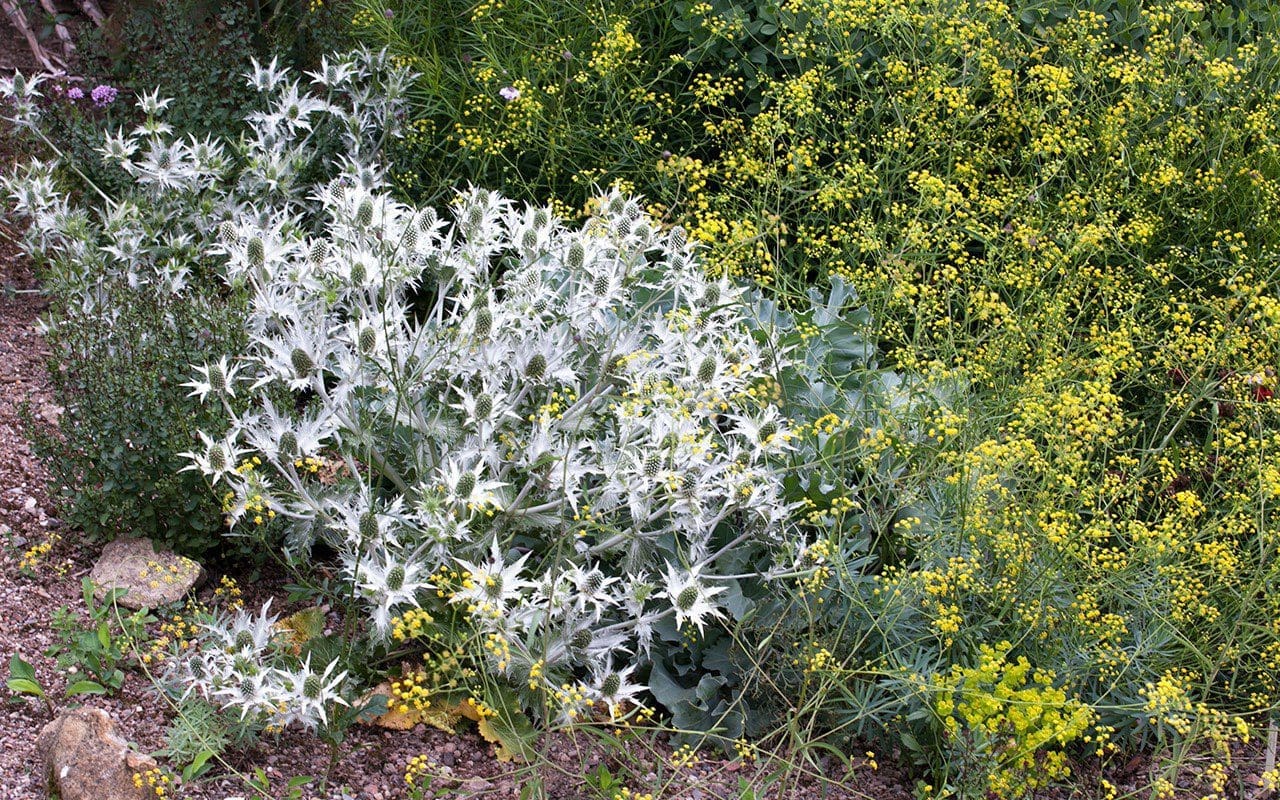 Eryngium giganteum, Bupleurum falcatum and Crambe maritima
Eryngium giganteum, Bupleurum falcatum and Crambe maritima
Look closely and the thistles are magnets for wildlife. The hum of the bees on the eryngium is audible long before you see them, and the butterflies are now working the platforms of nectar that are obviously suspended high in the artichokes. We have a variety from Paul Barney of Edulis Nursery called ‘Bere’ and those that escaped the harvest – within a week they are suddenly too tough to eat – are now in flower. Though this year they must be a foot shorter for the drought, they still rise above the trough behind them and draw the eye through the gauziness of the herb garden. They have had no water for they are adapted mediterraneans and follow the rainfall with leaves that flush in the autumn and spring.
Right now, the neon-violet buzz of flower has taken all their energy and we have cleared the lower limbs of old leaves to enjoy this moment and not be distracted by tattered yellowing growth that is obviously no longer necessary. Cynara cardunculus (Scolymus Group) (main image) is spectacular in every way, each plant needing a good square metre to reach up and out. When the flowers dim and I start to see September regrowth at the base I will fell the lot to put the energy into new leaf, rather than it going into seed production, so that we have them during the winter. A mild one will see a mound of new foliage sail through unscathed. A silvery architecture in the bare kitchen garden.
Though I could write at length about the other thistles that I have invited into the garden, the notable one that rises head and shoulders above the rest is Cirsium canum. Stand beside it and this Russian native will dwarf you, literally, the bright violet-pink flowers teetering on tall stalks just out of reach. I suspect, if I had not watered the perennial garden, that the foliage would have burned more than it has, for it is fabulously lush in the first half of the summer. Like a giant awakening, the energy in its new growth is audible in foliage that is shiny and squeaky with life when you corral it into hoops in May to prevent it from toppling. I do not know, if one was to grow it on ground that was less retentive, whether it would be lesser in every way and need less staking. I also don’t know yet if it will be a seeder. Derry Watkins of Special Plants says her plants haven’t seeded. Yet. Just in case, I cut them to the base last year after flowering having been stung previously by Cirsium tuberosum when I was looking for a thistle that would do the same job. I think I will do the same this year if they won’t leave too much of a hole in the garden around them.
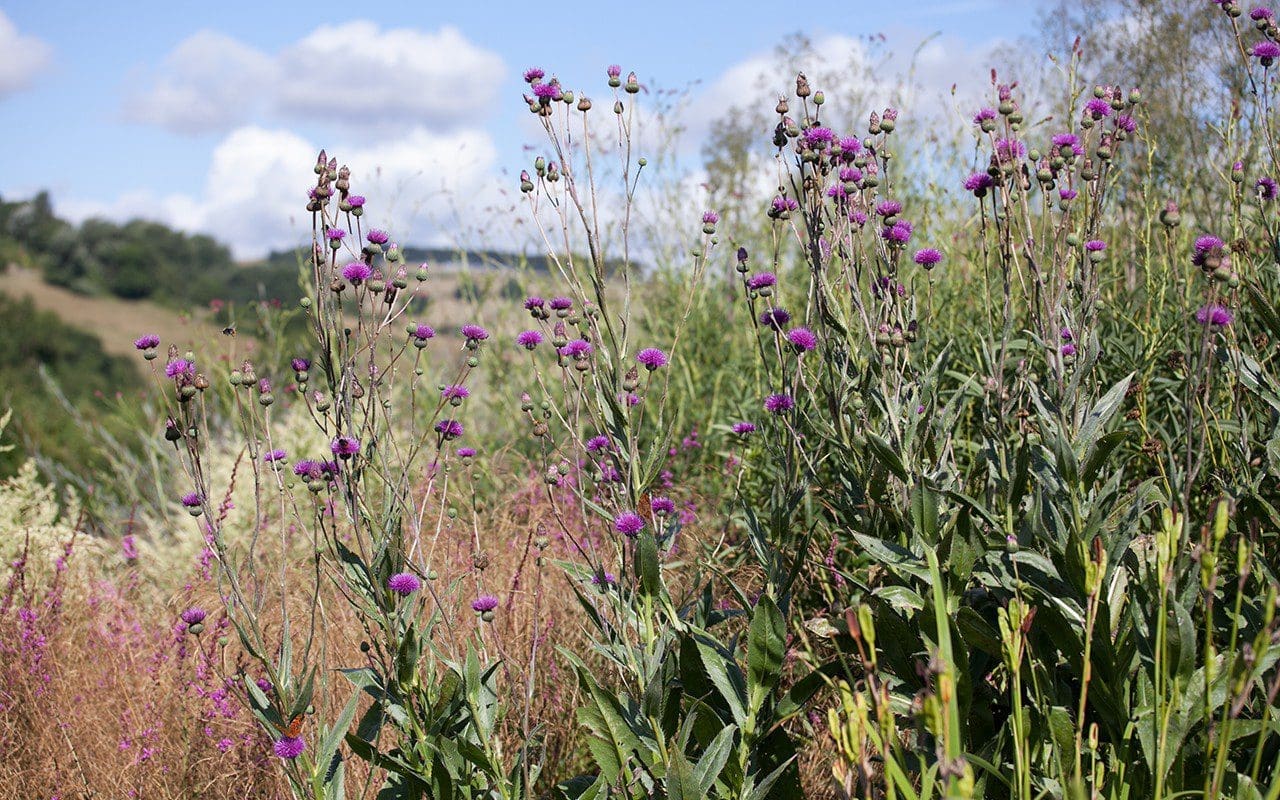 Cirsium canum
Cirsium canum
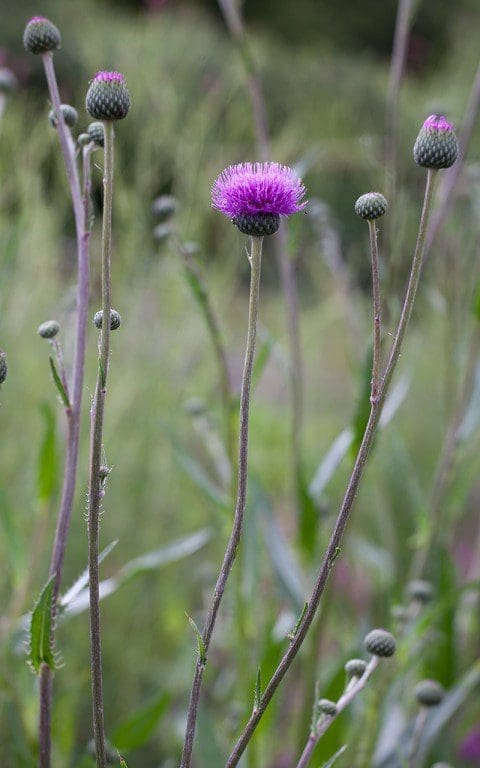 Cirsium canum
Cirsium canum
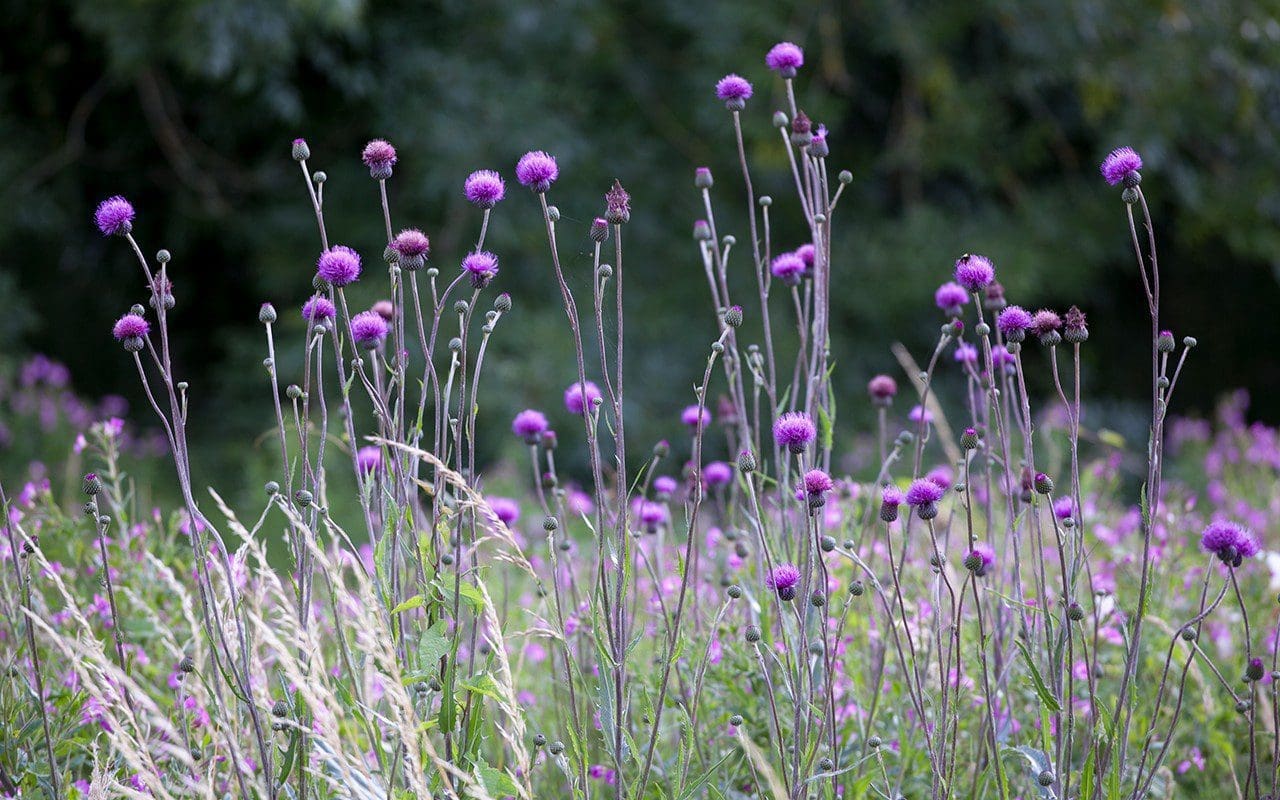 Cirsium tuberosum
Cirsium tuberosum
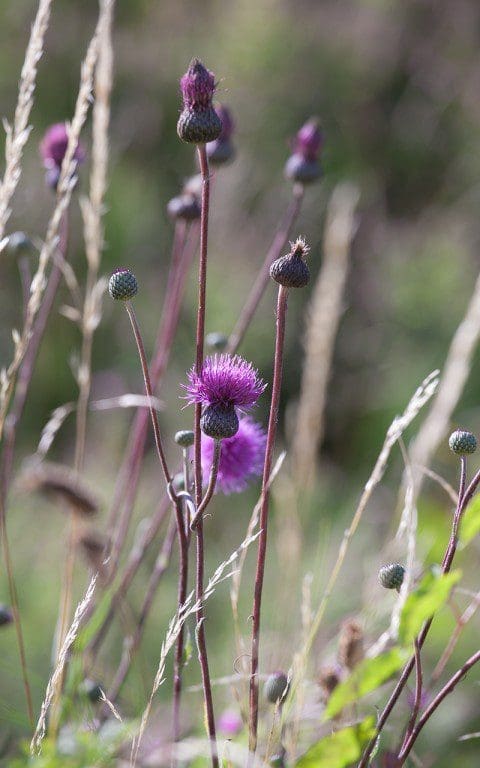 Cirsium tuberosum
Cirsium tuberosum
Though Cirsium tuberosum is similar in appearance, being more glaucous and less glossy, this Witshire native is, in my opinion, not a plant to be trusted in a garden. Given open ground and a window of opportuntity, it proved itself to be a monster in my stock beds. The wind-blown seed parachuted some distance and, though the seedlings were easy and graphically visible in their lust for life, the unseen few soon wedged their way into the crowns of perennials to send down taproots that were all but impossible to remove and top growth that rejoiced in being alive. When I was preparing the new garden, I jumped my stock plants of them into the rough grass that lines the ditch and here the competition has seen them in check and in balance. Stepping through meadowsweet and willow herb they look good in appropriate company and your eye can travel from the Russians in the garden to the natives in the ditch and be happy, so far, in the knowledge that each has found its place.
Words: Dan Pearson / Photographs: Huw Morgan
Published 4 August 2018
When we arrived here eight years ago, the fields lapped up to the yard at the front. Immediately to the west of the house a run of increasingly decrepit lean-tos made from a haphazard mix of cinder block, brick, stone and corrugated sheeting extended a semblance of domesticity along the slope. A rubble wall held back the track above and, along it, the structures made their way out towards the barns in stops and starts that charted their thrifty evolution; a scullery, an almost outside loo in a stone lean-to, then through a door into the original bathroom. Stand up washes at the sink in the winter, surely, as there was no evidence of heat. A recycled Victorian door then opened into a corrugated tin building where the coal had been stored and then finally, built onto the front of this, the piggery. Every room had a raking floor, pitching at some degrees down the slope. A seedling oak sprung from the brick floor of the coalhouse, the holes under the doors obviously big enough for squirrels or a rat, perhaps, who was planning a return visit, but never made it.
Our first project, the kitchen garden, lay beyond the reach of the lean-tos up around the barns. Several years ago we levelled the ground here in order to make the gardening easier. Two staggered troughs went in on this datum at the same time, echoing the horizontal line of beech on Freezing Hill in the distance and creating an informal gateway to the kitchen garden. By separating the kitchen garden off, when the lean-tos were demolished, we had a new garden space between the end of the house and the troughs. During building it was an area we had to traverse with caution, as it became more and more building site, with deep ruts, bonfires, rubble piles and the remains of the slope.
Although we had to knock down the lean-tos, we repaired and rebuilt the stone building that had previously been the pantry. The rubble wall now stood in splendid isolation, naked but shadowed with the ghosts of each of the buildings that had run along it. The tiles of the old bathroom, the blackened coal house and then, finally, a raggedy end up by the piggery. Word had it that ‘Mother’ had once had a vegetable garden on these slopes immediately beyond the piggery and, with the buildings gone, it was clear that this would be the space for the herb garden. A concrete pad was poured alongside the rubble wall in preparation for an open barn that would become our inside outside space and, in the summer of 2016, with the builders gone, we made a start to reclaim the ground.
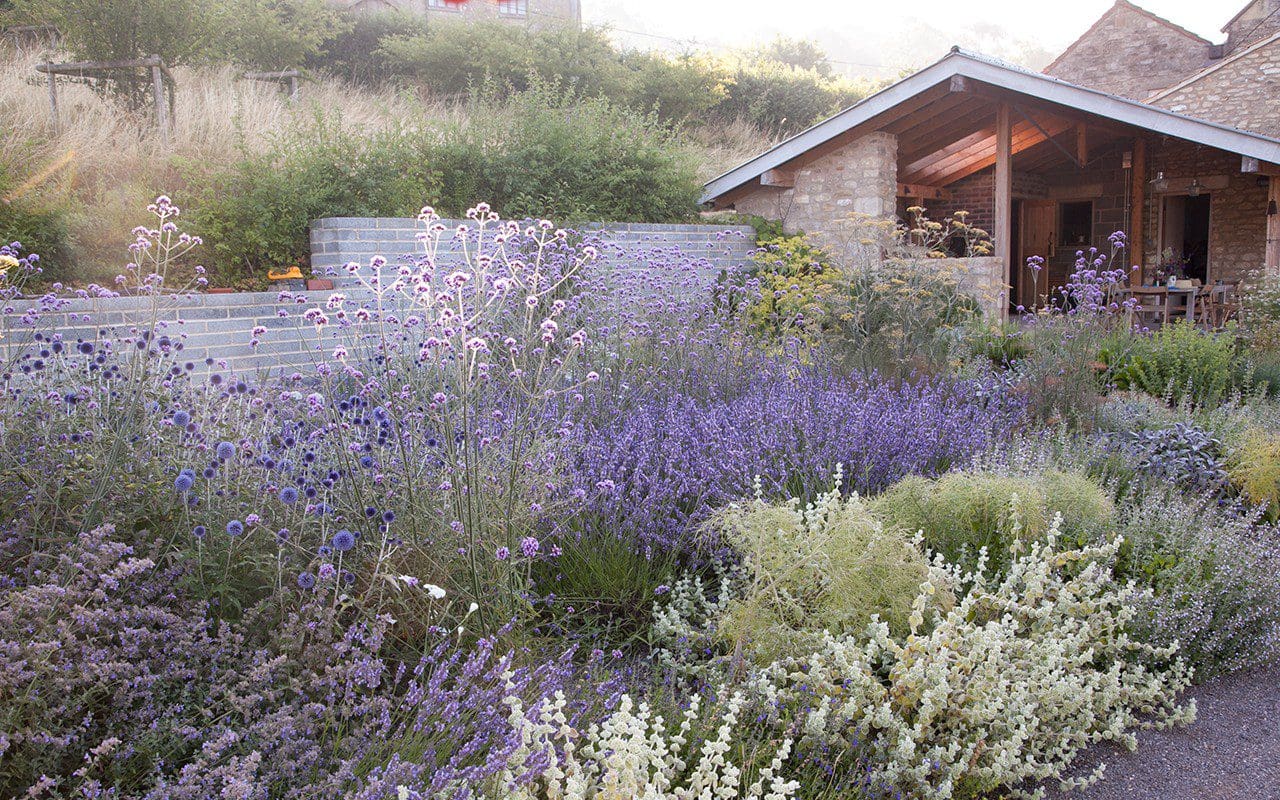
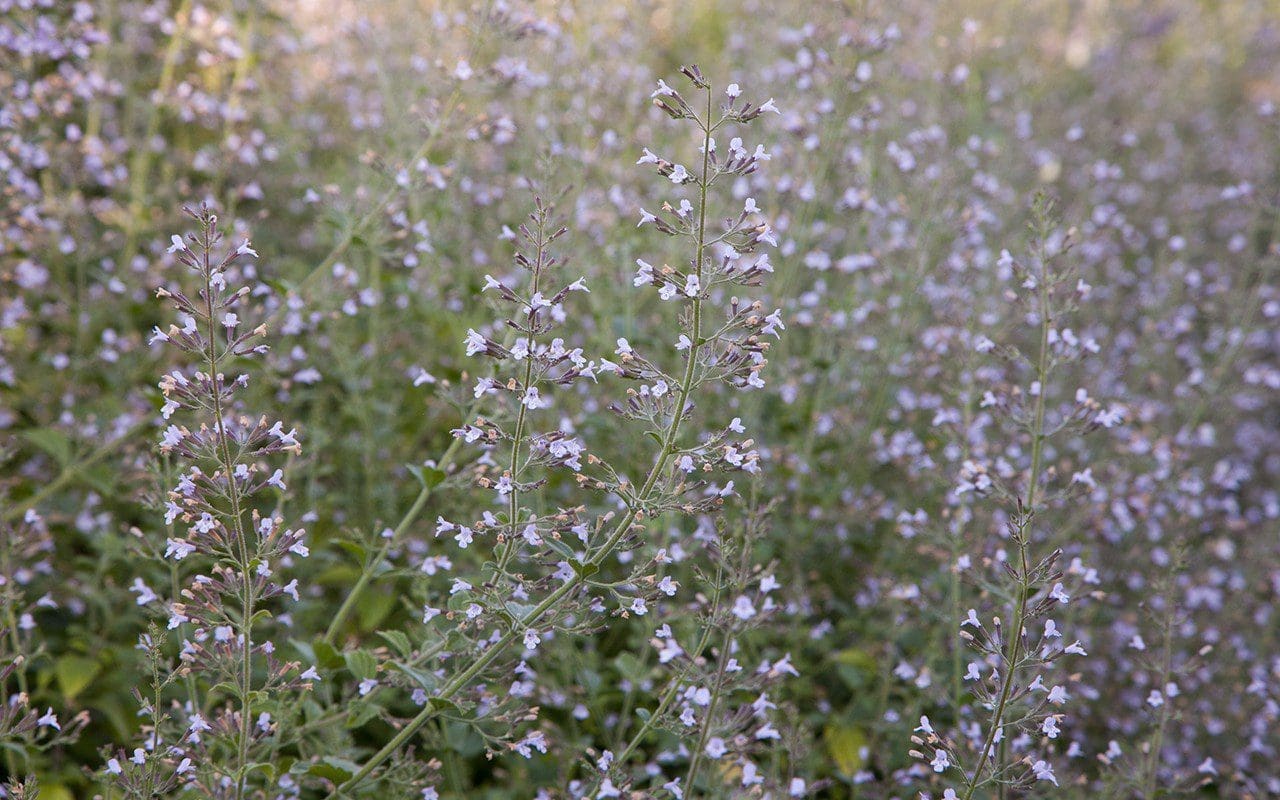 Calamintha nepeta ‘Blue Cloud’
Calamintha nepeta ‘Blue Cloud’
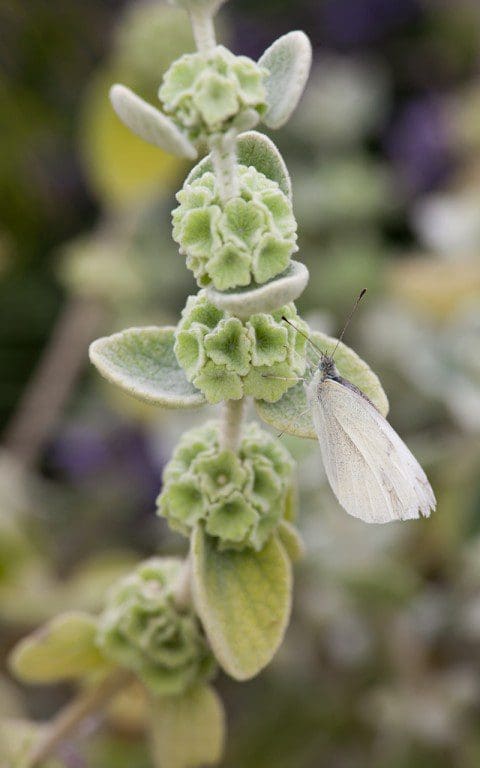 Ballota pseudodictamnus
Ballota pseudodictamnus
A cut was required to make the level between the house and the troughs, and the fill from the cut was used to extend the level out and down to form banks that rolled into the field. Where the rubble wall ran out, we extended a breezeblock wall to hold back the banks that had been held together with sheet tin and bedsteads, and the remains of a hedge that was mostly elder and bramble with a couple of sickly plums. I replaced the hedge on top of the new wall, mingling hawthorn with eglantine for its scented foliage, and with wild privet and box for evergreen. Lonicera periclymenum ‘Sweet Sue’ – a short growing form of our native honeysuckle selected by Roy Lancaster, has been added along its length. The wall faces south and heats up in the day to throw the perfume back at night. I planted wild strawberries at the base of the hedge so we have easy pickings at shoulder height on the way to the steps. The perfume from the strawberries has been incredible during this recent run of long, hot days.
A set of new cast concrete steps sit half way along the wall and flare at the top where a landing forms a viewing platform. From here you can survey the kitchen garden to the west and this new space alongside the house. The concrete pour into a shuttered wooden framework took some engineering, but the steps have weight and their gravity is needed where they sit in the space between the troughs. We grow artichokes and the rhubarb here. Plants that need room.
The herb garden was a working title that has stuck. The actual herb beds are a pair of narrow raised beds up by the open barn where we can easily pick the annual herbs that like the morning shade thrown by the building. Coriander, dill, wild rocket, coriander, chervil and parsley, but not basil which needs the all-day heat that lies beyond in the kitchen garden. Further out the perennial herb bed gets the sun and provides us with sage, rosemary, thyme, marjoram, tarragon, summer and winter savory, sorrel and the like. Mint is contained in a pair of old zinc washing dollies in the shade of the building, where it stays lusher and leafier.
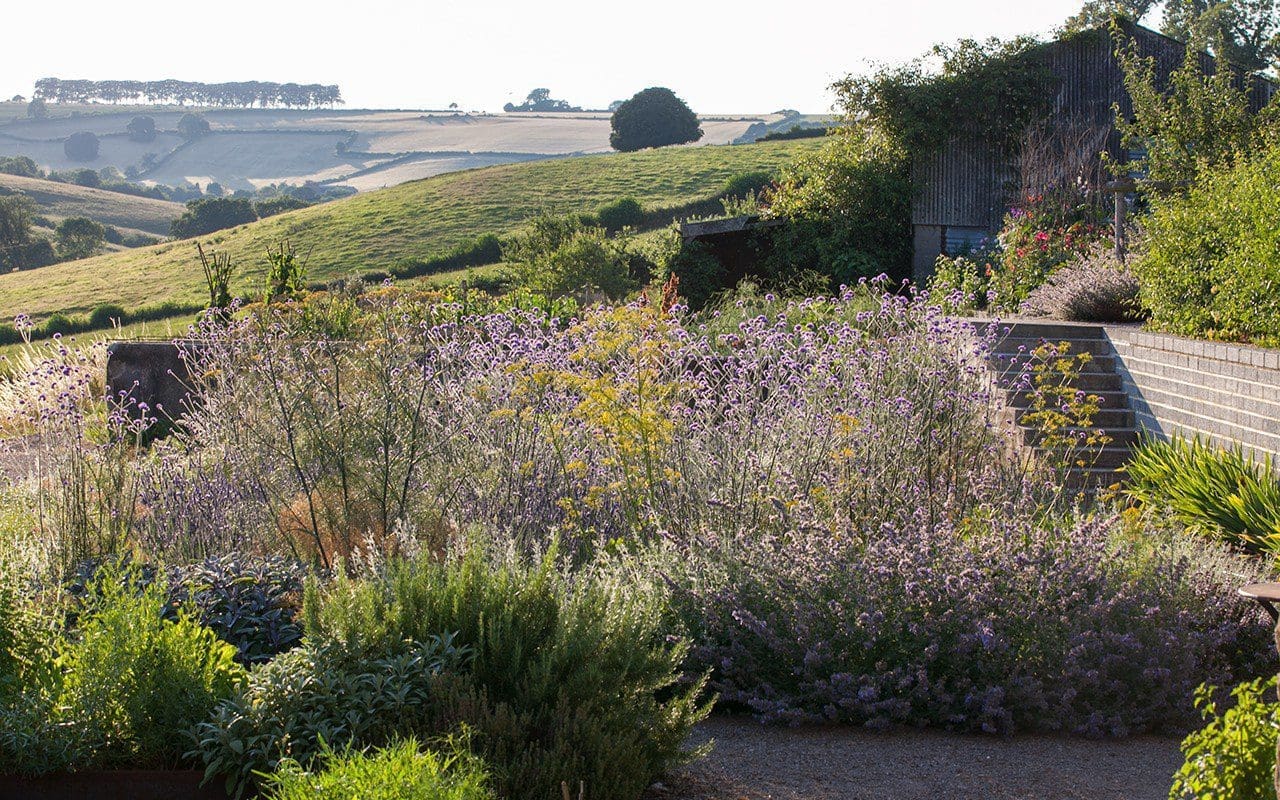
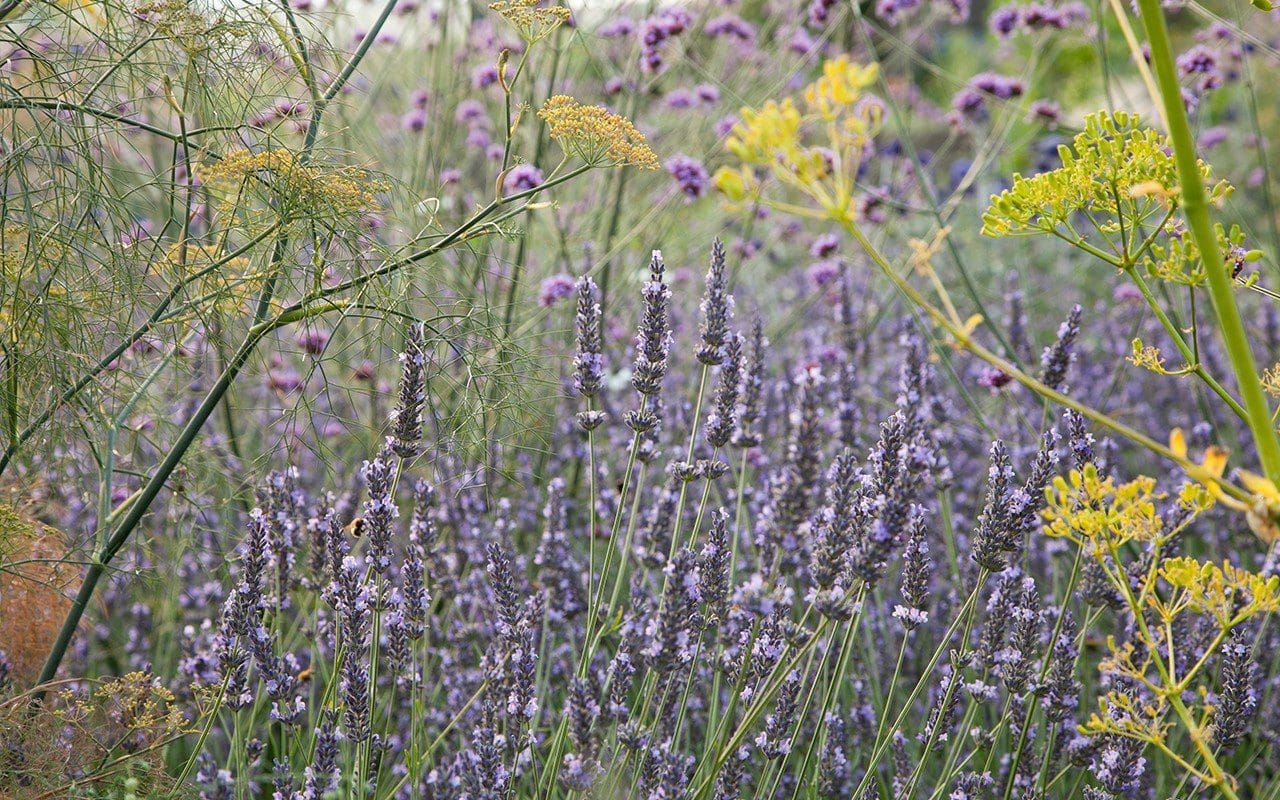 Lavandula x intermedia ‘Sussex’, bronze fennel (left) and Opopanax chrironium (right)
Lavandula x intermedia ‘Sussex’, bronze fennel (left) and Opopanax chrironium (right)
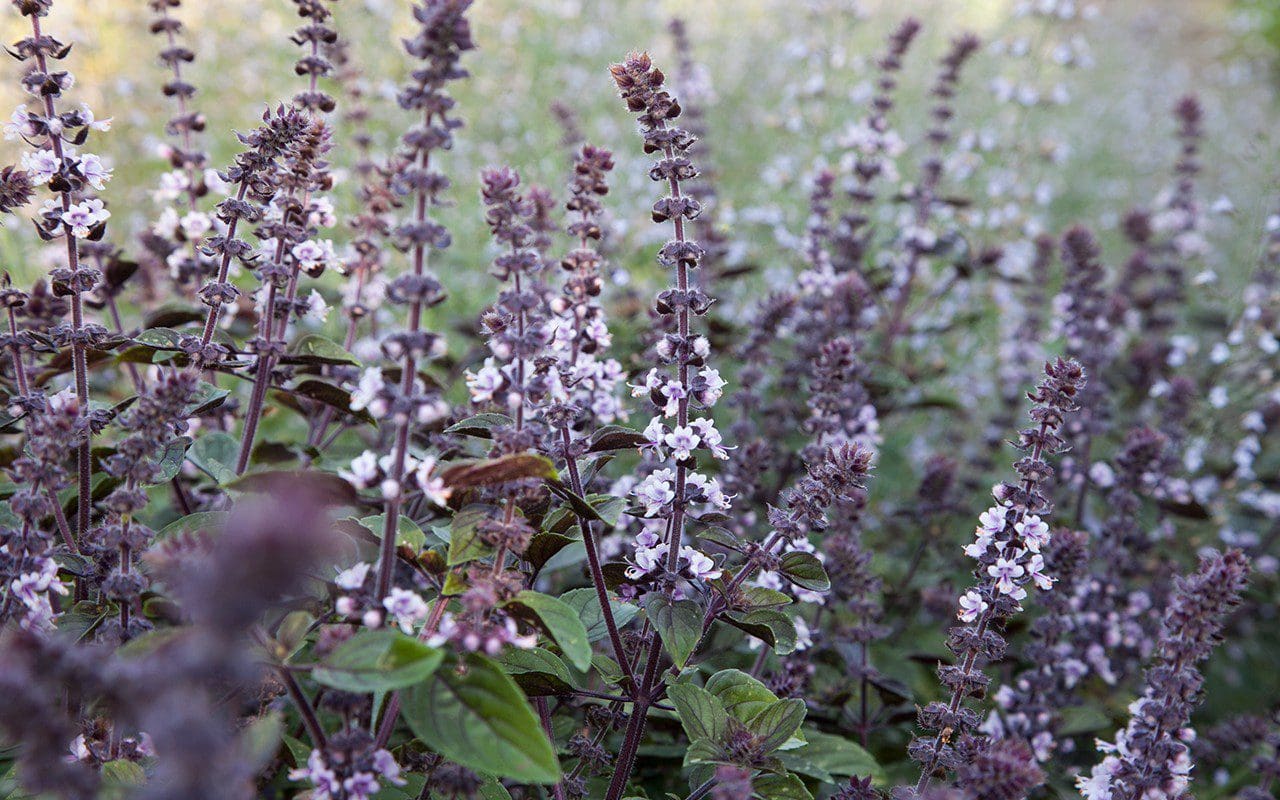 Basil ‘African Blue’
Basil ‘African Blue’
The extent of the planted area between here and the troughs had to be carefully re-soiled once the cut into the land was made into subsoil. I left it fallow the winter before last, as I wanted to see how easily it drained, since the ‘herb garden’ was where I wanted to grow my lavenders and salvias and other plants that associated well alongside them. I am pleased I did, because while the soil was settling down it drained very badly, puddling in the winter. I thought I was going to have to reconsider my palette, but couldn’t think of anywhere the lavenders would feel as right. It was only when the spring sun dried the soil out and natural fissures opened up in our clay subsoil that it started to behave as I wanted it to.
I planted last spring, late in April once the first phase of the main garden was in and mulched. The cut-leaved Ficus afghanistanica ‘Ice Crystal’ was planted close to the bottom of the steps to create a narrowing and a shaded exit point. Though not selected for fruit – they are small and sweet when they come, but require prolonged heat to ripen – I like the fineness of the dissected foliage immensely and, although I have never seen a large plant, I expect it not to take over as figs tend to when they like you. The willow-leaved bay, Laurus nobilis ‘Angustifolius’ anchors the inside corner nearest the house. With elegant, narrow foliage this bay also has a lightness about it. I will keep it loosely clipped into a dome at about shoulder height when, one day, it assumes its position.
I trialled three different lavenders in the old garden in anticipation of this planting. Lavandula x intermedia ‘Grosso’, a variety used in perfumery in France for its high production of essential oils. I liked it very much. It has good, strong colour and certainly good perfume, but the plants splayed under their weight when in full flower. The best time to harvest lavender for the oil is when the first flowers on the spike are just out, so good for perfumery, but not so good for the garden. L. x intermedia ‘Edelweiss’ came a close second with a camphor tang to the perfume and beautiful white flowers that were much loved by the bees, but they proved to be erratic here, with too many plants failing in winter making me lose confidence in committing to it. Our wet West Country weather was probably their downfall. Not L. x intermedia ‘Sussex’ which, though not as dark as ‘Grosso’, is good in every other respect. Tall, long flower spikes and a good form to the plant that, so far, has proven reliable here.
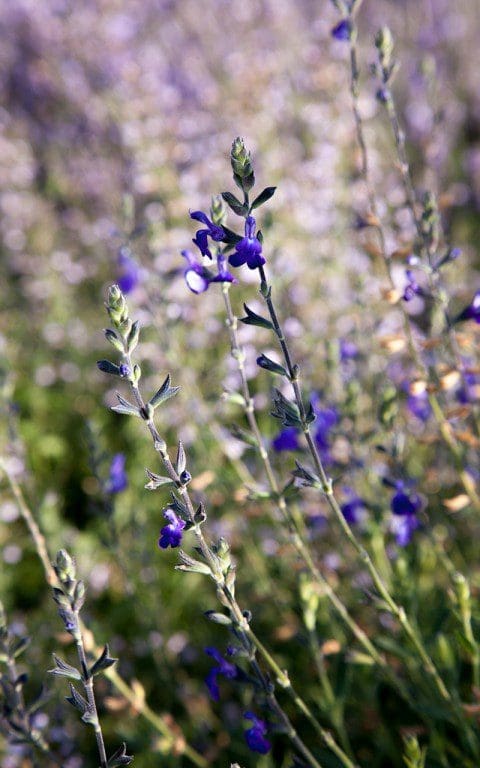 Salvia greggii ‘Blue Note’
Salvia greggii ‘Blue Note’
 Echinops ritro ‘Veitch’s Blue’
Echinops ritro ‘Veitch’s Blue’
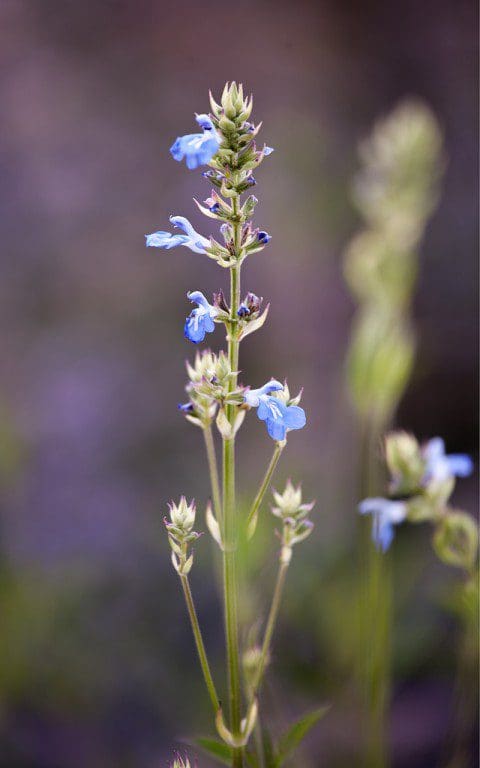 Salvia uliginosa
Salvia uliginosa
So, the lavender form the backbone of the planting, thirty plants staggering their way across the space, but with openings left for light-footed emergents; Verbena bonariensis – only here and nowhere else for fear of overuse – and bronze fennel, just five plants to keep the airiness in the planting. I’ve direct sown the acid yellow Ridolfia segetum, bone white corncockle Agrostemma githago ‘Ocean Pearl’ and white Ammi majus to lighten the palette. The sparkle is important amongst the mauves. A darker counterpoint is provided by the purple spires of Basil ‘African Blue’, pot-grown nursery plants that we plant out yearly as annuals.
Rising up in this second year are the Opopanax chironium. A herb used for the incense resin that is extracted from the dried sap, this is another of the many umbellifers gifted to me by Fergus Garrett at Great Dixter. Though they have yet to flower here, the Giant Fennel, Ferula communis, are planted towards the edges of the bed so that it doesn’t overshadow the lavender with its early growth. I hope to see them bolt skyward next year, but for the early part of the growing season their netted leaves have been wonderful.
I wanted this planting to have unity but, like the cloudscape it resembles, I also wanted to be able to find the shifts in tone and form. The palette of recessive mauves and blues also allows us the long view here, which is most important because the planting is all too often eclipsed by what is going on in the sky. I have built on the insect life that the lavender attracts with Nepeta ‘Six Hills Giant’, which is alive with bumblebees from the moment it starts flowering in April. The smaller in scale Calamintha nepeta ‘Blue Cloud’ is delicious by the path where, if you brush against it, you are rewarded with fresh menthol mintiness.
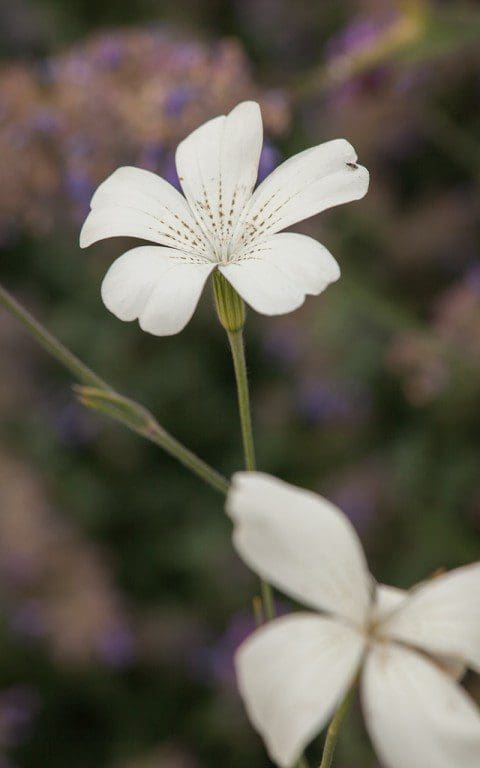 Agrostemma githago ‘Ocean Pearl’
Agrostemma githago ‘Ocean Pearl’
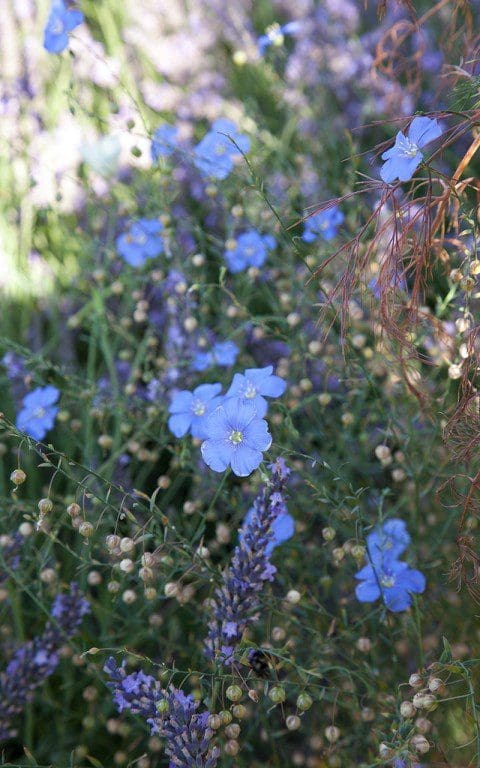 Linum perenne
Linum perenne
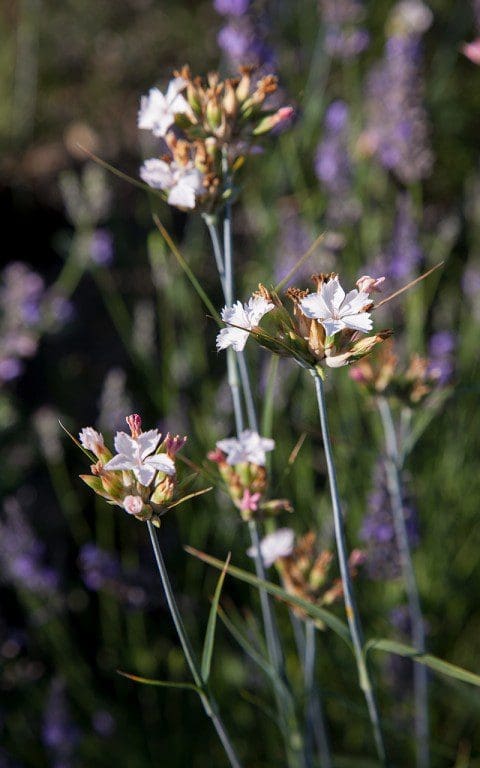 Dianthus ‘Miss Farrow’
Dianthus ‘Miss Farrow’
The calamint comes later than the catmint and shortly after the Salvia greggii ‘Blue Note’, which starts into flower the last week in June. Its spicily scented leaves and flower spikes are sticky with essential oils and the deeply saturated indigo flowers are neverending from now until the frost. The rich blue globes of Echinops ritro ‘Veitch’s Blue’ run through the planting and, along with the verbena, are the biggest draw for butterflies. Just starting now the cool blue spires of Salvia uliginosa continue the nectar flow until the first frosts. There are incidentals to be found in the undercurrent; Dianthus ‘Miss Farrow’, a D. carthusianorum selection with tiny pinpricks of palest pink flower, and floaty Linum perenne, which brings an underwater movement. I hope it seeds this year as we could have more for the cleanliness of its sky-blue flower.
The lavender will be cut in the last week of the school holidays or thereabouts so that it has time to regenerate before winter. This year I will also be cutting the verbena and fennel before winter to avoid the million seedlings which made their home in the gravel mulch this spring. By then I will be pleased to see the sharp line of the troughs again with the long view of Freezing Hill echoing their horizontal.
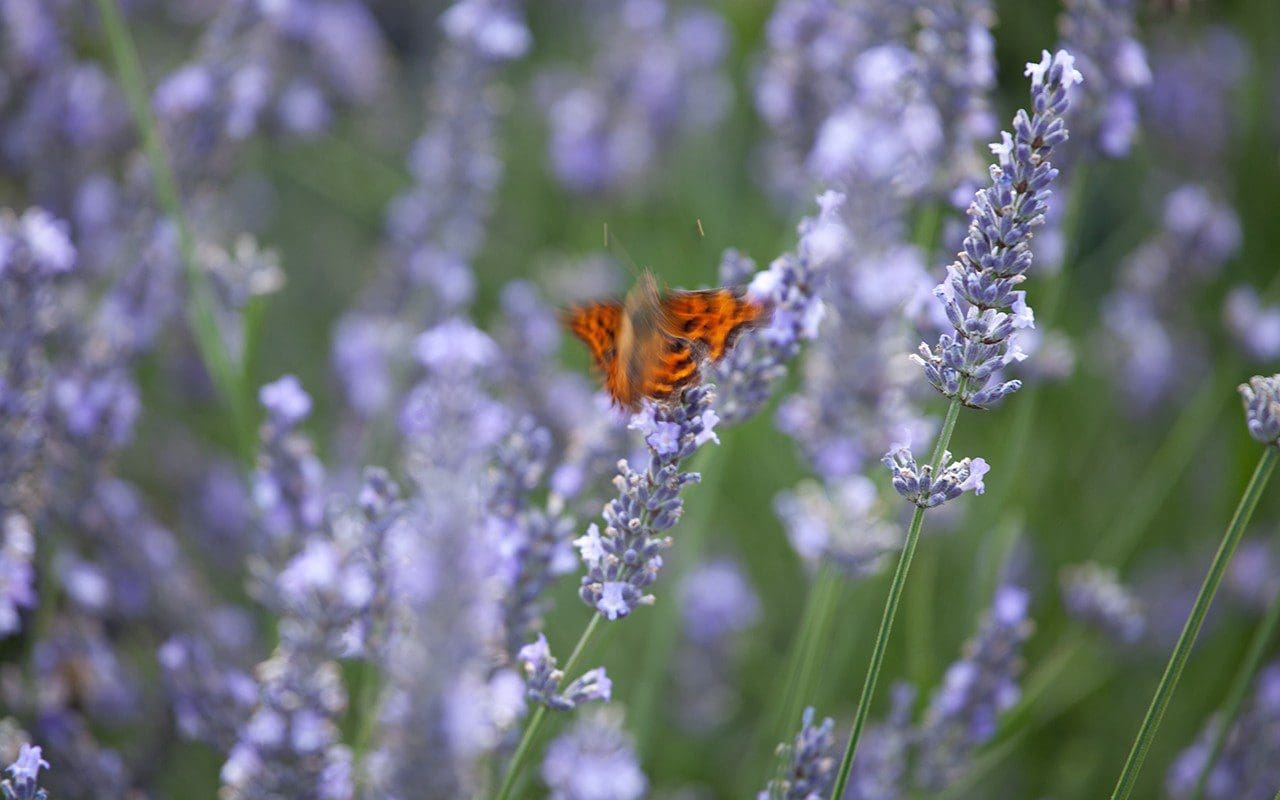
Words: Dan Pearson / Photographs: Huw Morgan
Published 28 July 2018
The two best times to look at the garden are to either end of the day. I would be up at four if I had the reserves, but we are up early when the light is soft and before the sun reaches over the hedge. The stillness of first thing is particular for the feeling of awakening, but there is a charge in the air with the day waiting to happen. When the sun breaks the spell, everything changes as the light flattens and the tasks of the day take over. We wait then until the sun dips low in the sky and the light is softened before resuming our observation.
The long evenings are remarkable in this country and particular this year for the brilliance and stillness of this summer. Evenings were always the time that I used to go down the garden at Hill Cottage to the pair of borders that my father and I made there when I was a teenager. His planting to the left in a border of whites and blues and mine to the right with yellows and clashing magentas. We would spend an hour or so talking things through, observing how things could be bettered or moments where briefly things sang. We would talk about the way the colours changed as the light dropped, the blues beginning to pulse and hover as the low light favoured them, and of the way that the brighter, hotter colours, which had flared during the day, dropped away first.
Huw and I do the same here, using the time when you can see best to workshop the planting and to enjoy the elements that have come together or shifted during the day. The slow evenings are in our favour, for they have an altogether different charge from the awakening of dawn. We let the colour go through its metamorphosis, as the reds, pinks and oranges heat up at sundown and then quickly dim to almost nothing. The violet end of the spectrum then takes over as the gloaming hour assumes its residency, the flowers with the most blue in them appearing to lift from their material origins in these fugitive last minutes. Then, in a shift that you feel but do not necessarily see, the colour is gone and you are left with something else. A garden of textures and form, readying for night. More often than not it is ten before we have even begun to think about supper. It is hard drag yourself inside when your senses are retuned and receptive.
This summer, as much out of desire as necessity, Huw has been photographing the night time garden to extend our experience. I will let him take it from here to explain why.
Dan Pearson
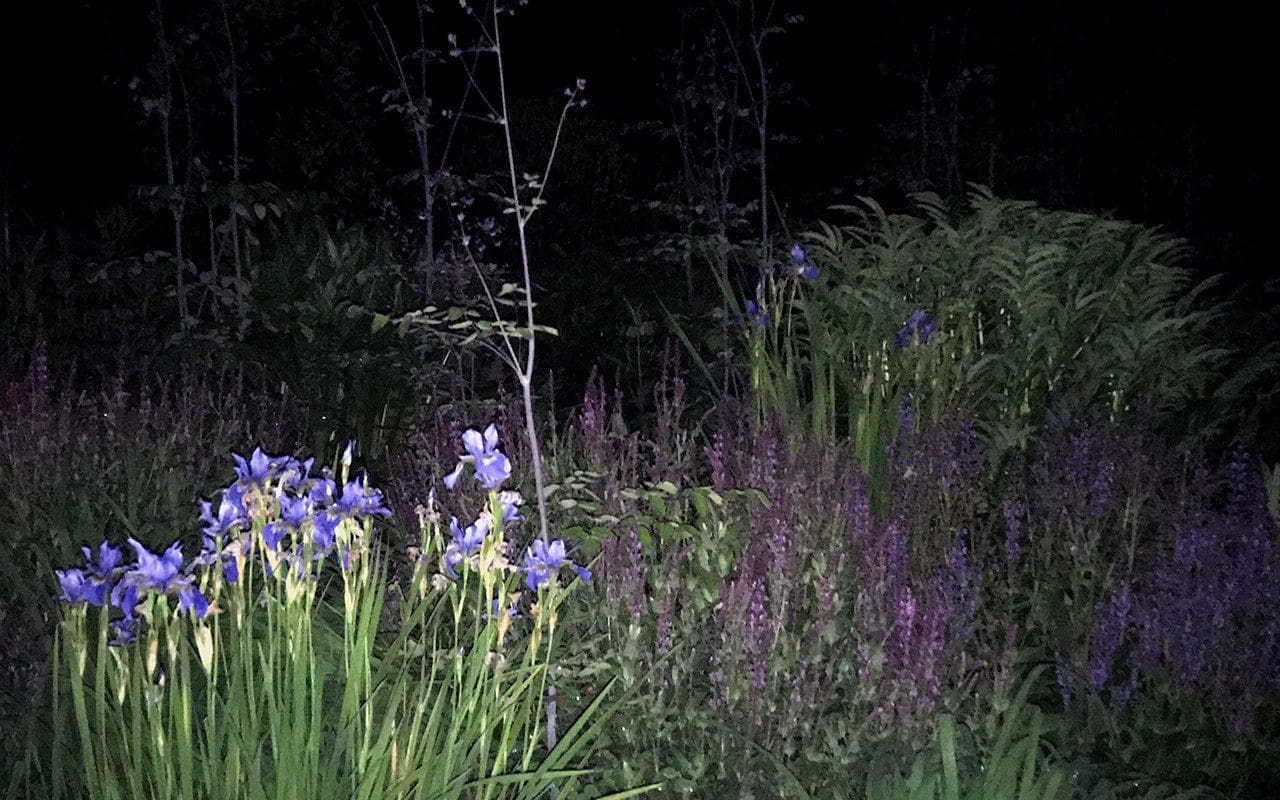
Over the years I have always experimented with my photography. Capturing movement by shooting digital film on a very slow shutter speed and then extracting single frames, selected for the painterly composition of their colour blur. On my old Polaroid camera I would cover the focus sensor, so that images of plantings resembled Impressionist paintings or colour fields. And I have used torches, lanterns and flash to see the garden in a different way by night. With each approach I have been happy, even seeking, to surrender some of my control over the final image to the equipment and technology itself.
However, over the past few years, and so that we can record the garden here properly, I have been actively working to improve my skill with a digital SLR camera and a number of lenses, so it has been a while since I have experimented in this way. At the beginning of June, with the start of the long warm nights, I found myself in the garden at the gloaming hour, having driven down to Somerset after a working day in London. With the warmth, growth had started in earnest and, as the light faded, there were parts of the new garden that it fast became too dark to see clearly. I got out my phone and switched the light on. Suddenly individual plants were thrown into sharp relief against the inky background of hedge, wood and sky. The composition of volumes and heights and the differences in textures became more apparent. Colour was heightened and where, by daylight, the plantings were soft and transparent, now they were graphic and architectural. I immediately started taking photographs on the phone with the flash.
It is a tricky process framing and composing an image when you are, quite literally, shooting in the dark. A series of test shots are necessary to establish the composition and to attain the right distance from the subject so that the flash doesn’t create too much of a hot spot. Even once this has been successfully done, the camera doesn’t always focus accurately in the dark, so each successful shot is arrived at after taking many that do not work. It is then a long process evaluating, editing and then adjusting contrast and colour balance to achieve a satisfactory result.
As the nights grew longer and we wandered the paths later and later each evening, I have been staying out after nightfall to try and capture aspects of the ever-changing picture. As in Tom’s Midnight Garden, the clarity of darkness reveals things invisible by day. The abstraction of the plantings against the velvet black and the fluttering of a thousand moths making of the garden a new mysterious and magical territory.
Huw Morgan
Photographs: Huw Morgan
Published 21 July 2018
It has been an extraordinary run. Day after day, it seems, of clear sky and sunlight. I have been up early at five, before the sun has broken over the hill, to catch the awakening. Armed with tea, if I have been patient enough to make myself one before venturing out, my walk takes me to the saddle which rolls over into the garden between our little barn and the house. From here, with the house behind me and the garden beyond, I can take it all in before beginning my circuit of inspection. It is impossible to look at everything, as there are daily changes and you need to be here every day to witness them, but I like to try to complete one lap before the light fingers its way over the hedge. Silently, one shaft at a time, catching the tallest plants first, illuminating clouds of thalictrum and making spears of digitalis surrounded in deep shadow. It is spellbinding. You have to stop for a moment before the light floods in completely as, when you do, you are absolutely there, held in these precious few minutes of perfection.
Now that the planting is ‘finished’, the experience of being in the garden is altogether different. Exactly a year ago the two lower beds were just a few months old and they held our full attention in their infancy. The delight in the new eclipsed all else as the ground started to become what we wanted it to be and not what we had been waiting for during the endless churn of construction. We saw beyond the emptiness of the centre of the garden, which was still waiting to be planted in the autumn. The ideas for this remaining area were still forming, but this year, for the first time, we have something that is beginning to feel complete.
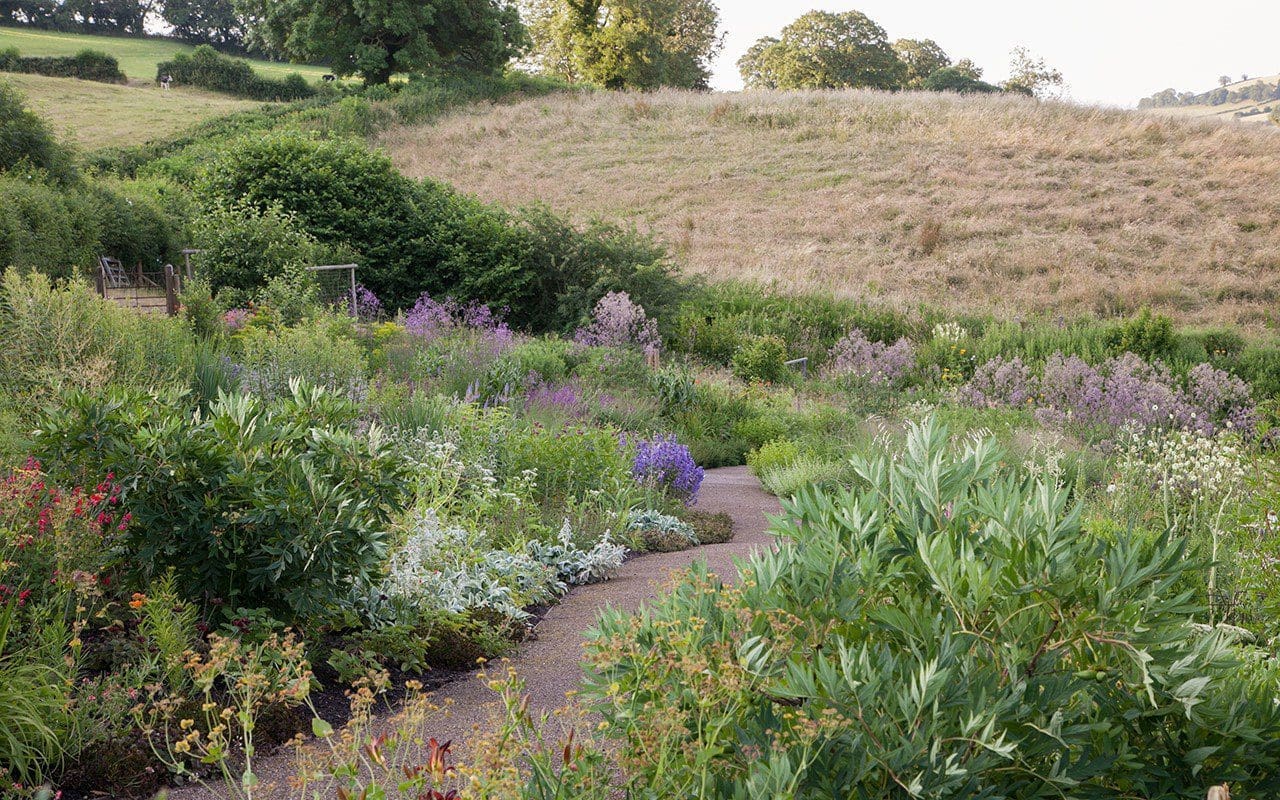 Looking down the central path from the saddle
Looking down the central path from the saddle
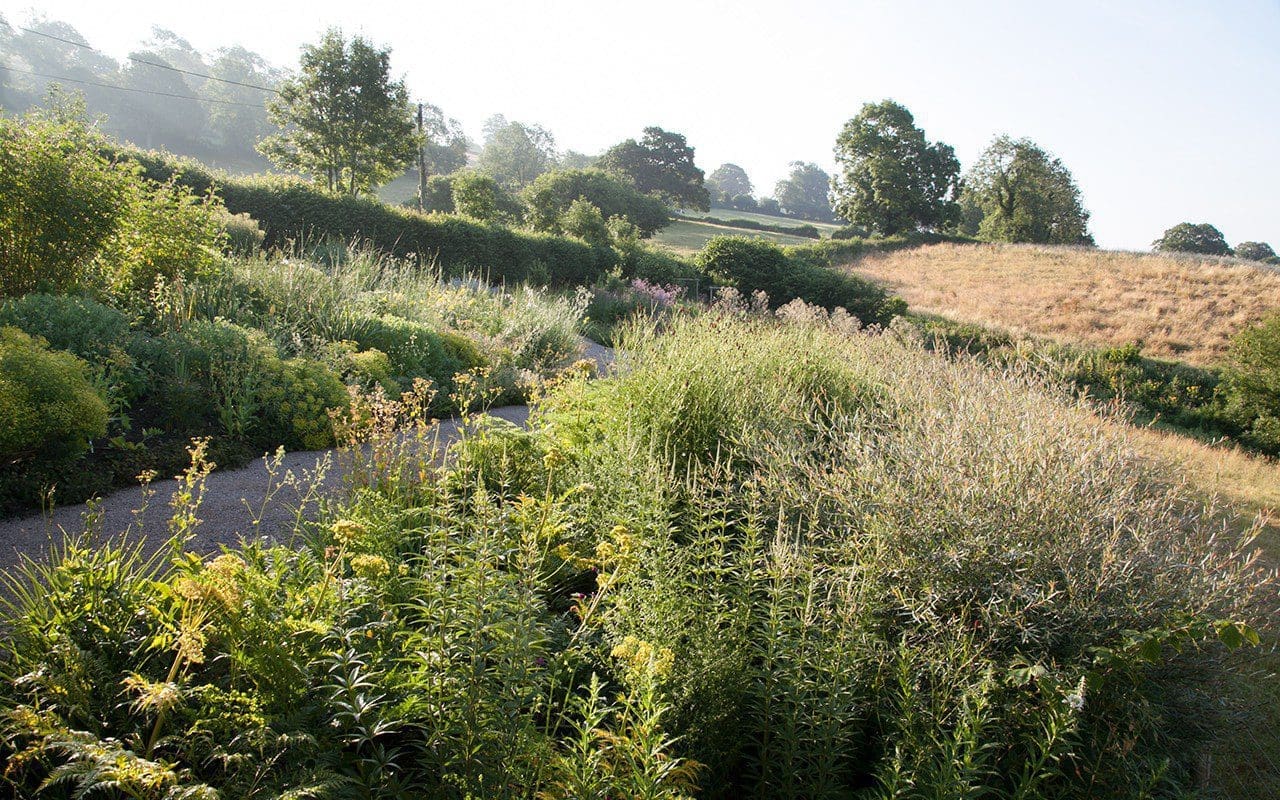 The view from the barn verandah
The view from the barn verandah
Of course, a garden is never complete. One of the joys of making and tending one is in the process of working towards a vision, but today, and despite the fact that I am already planning adjustments, I am very happy with where we are. The paths lead through growth to both sides where last year one side gave way to naked ground, and the planting spans the entire canvas provided by the beds. You can feel the volume and the shift in the daily change all around you. It has suddenly become an immersive experience.
An architect I am collaborating with came to see the garden recently and asked immediately, and in analytical fashion, if there was a system to the apparent informality. It was good to have to explain myself and, in doing so without the headset of my detailed, daily inspection, I could express the thinking quite clearly. Working from the outside in was the appropriate place to start, as the past six years has all been about understanding how we sit in the surrounding landscape. So the outer orbit of the cultivated garden has links to the beyond. The Salix purpurea ‘Nancy Saunders’ on the perimeter skip and jump to join the froth of meadowsweet that has foamed this last fortnight along the descent of the ditch. They form a frayed edge to the garden, rather than the line and division created by a hedge, so that there is flow for the eye between the two worlds. From the outside the willows screen and filter the complexity and colour of the planting on the inside. From within the garden they also connect texturally to the old crack willow, our largest tree, on the far side of the ditch.
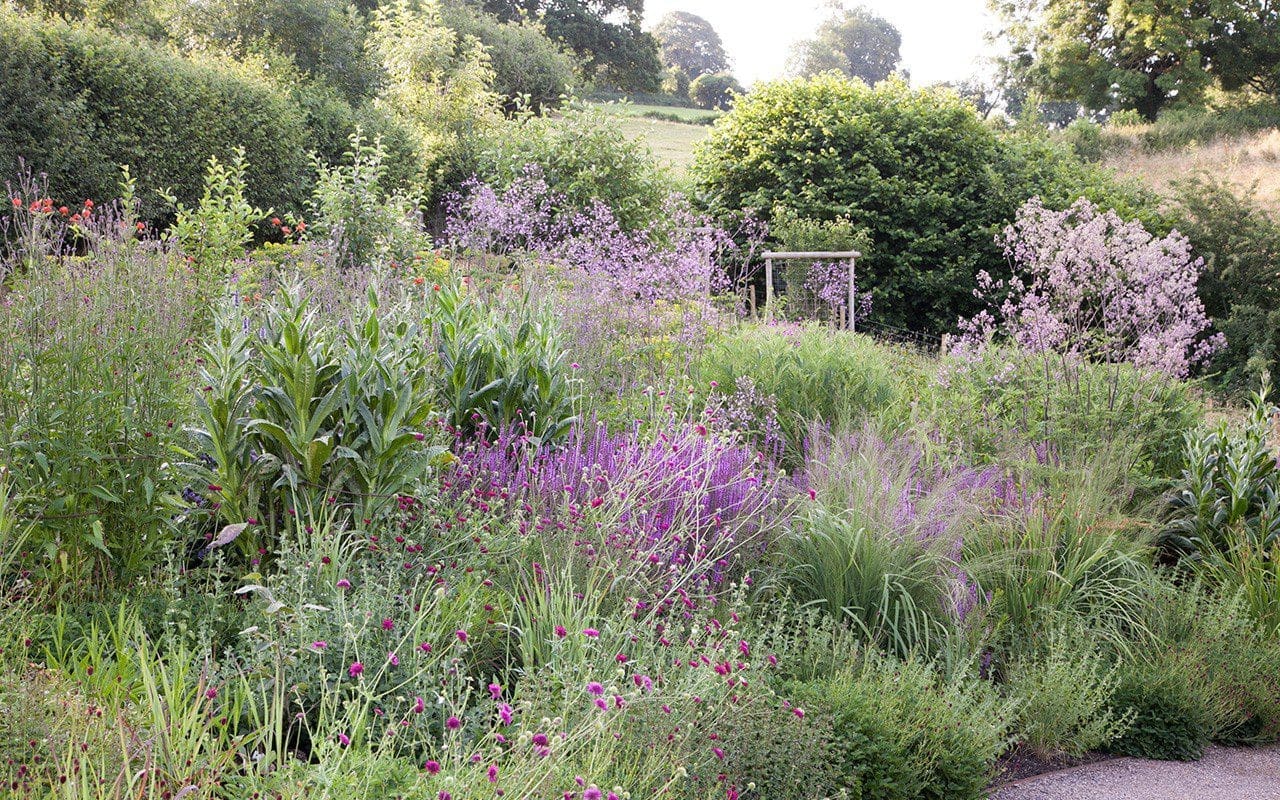 The far end of the garden which was planted in Spring 2017
The far end of the garden which was planted in Spring 2017
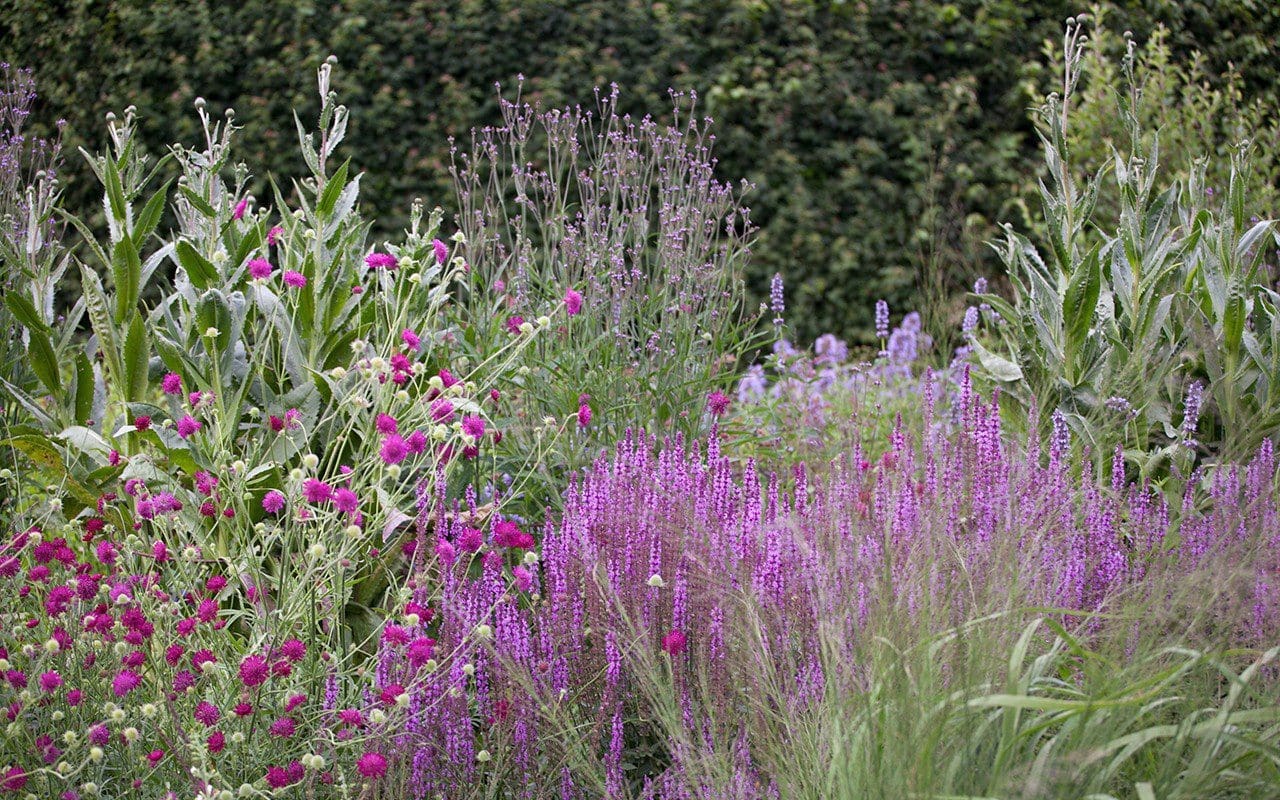 Knautia macedonica, Salvia nemerosa ‘Amethyst’, Cirsium canum and Verbena macdougallii ‘Lavender Spires’
Knautia macedonica, Salvia nemerosa ‘Amethyst’, Cirsium canum and Verbena macdougallii ‘Lavender Spires’
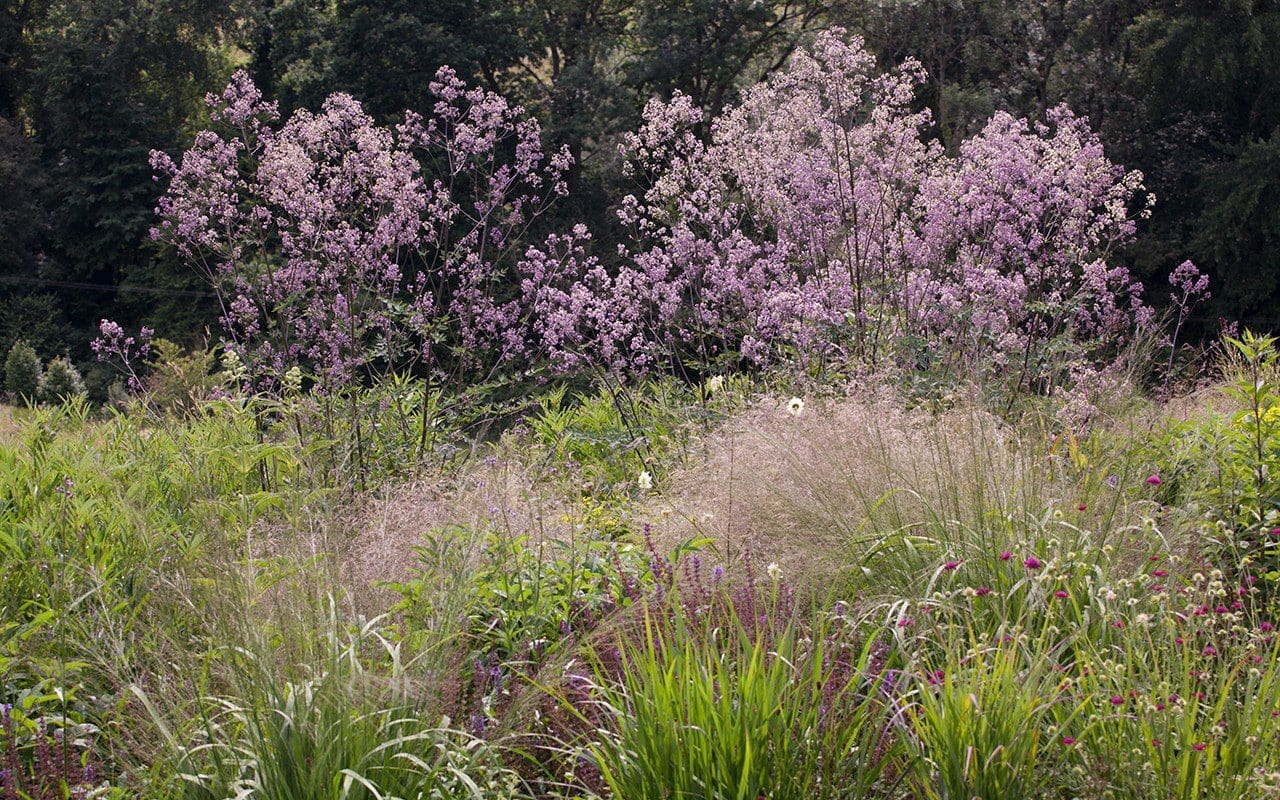 Thalictrum ‘Elin’ above Deschampsia cespitosa ‘Goldtau’
Thalictrum ‘Elin’ above Deschampsia cespitosa ‘Goldtau’
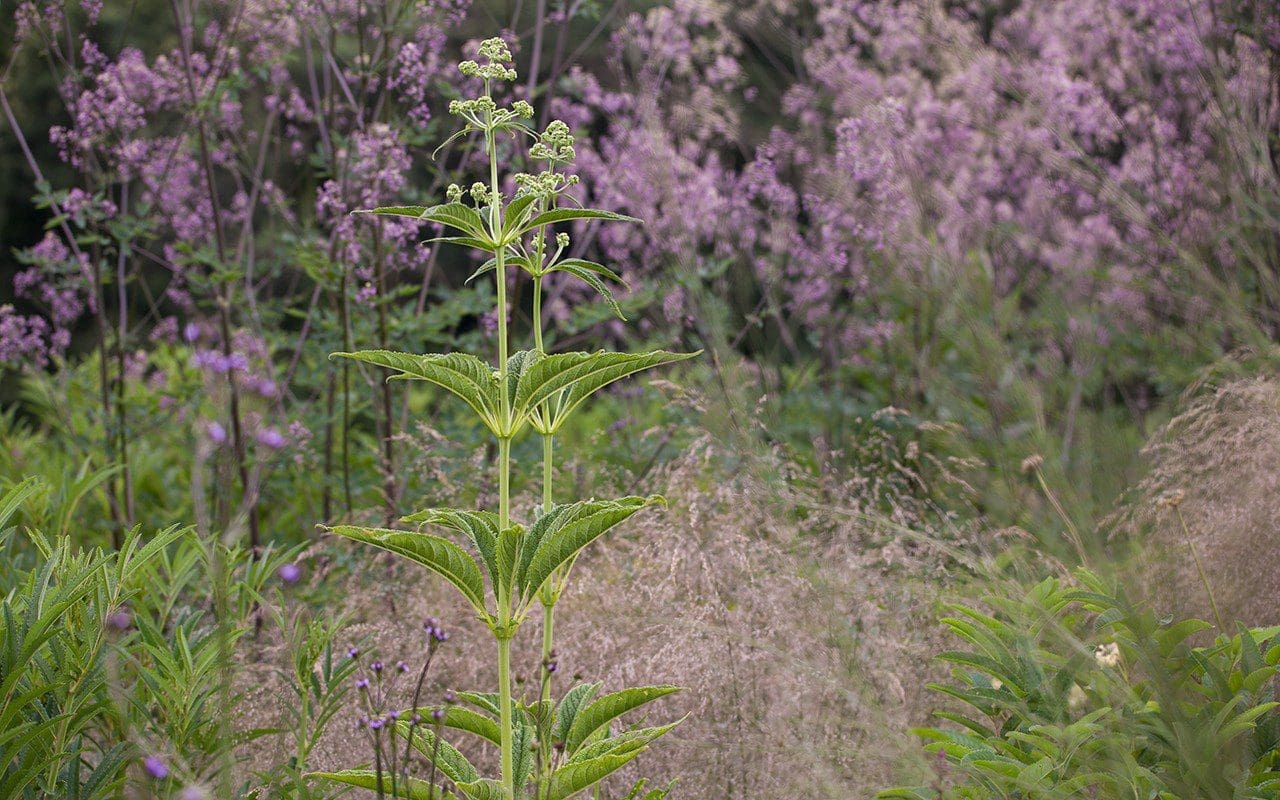 Eupatorium fistulosum f. albidum ‘Ivory Towers’ emerging through Deschampsia cespitosa ‘Goldtau’
Eupatorium fistulosum f. albidum ‘Ivory Towers’ emerging through Deschampsia cespitosa ‘Goldtau’
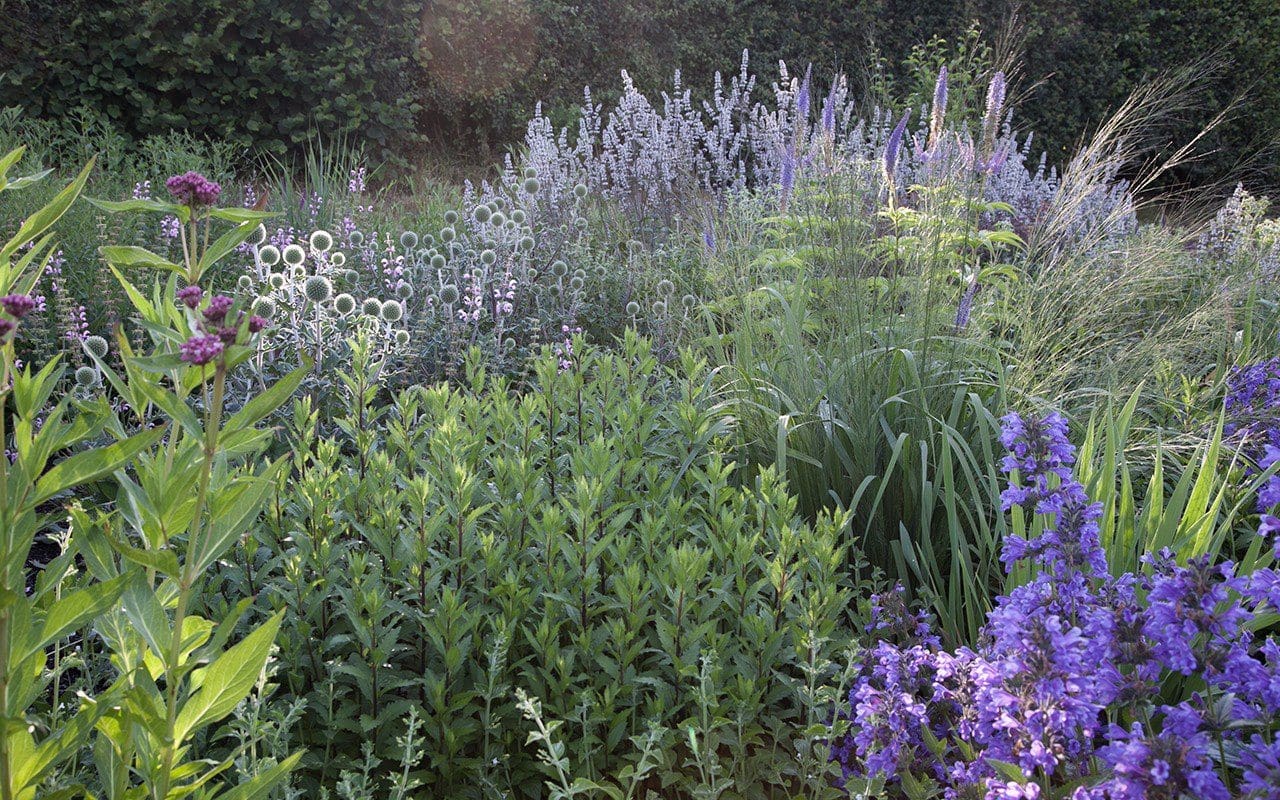 Asclepias incarnata, Echinops sphaerocephalus ‘Arctic Glow’, Nepeta nuda ‘Romany Dusk’ and Nepeta ‘Blue Dragon’
Asclepias incarnata, Echinops sphaerocephalus ‘Arctic Glow’, Nepeta nuda ‘Romany Dusk’ and Nepeta ‘Blue Dragon’
This first outer ripple of the garden is modulated. It is calm and delicate due to the undercurrent of the Deschampsia cespitosa ‘Goldtau’, but strong in its simplicity. From a distance colours are smoky mauves, deep pinks and recessive blues, although closer up it is enlivened by the shock of lime green euphorbia, and magenta Geranium psilostemon and Lythrum virgatum ‘Dropmore Purple’. Ascending plants such as thalictrum, eupatorium and, later, vernonia, rise tall through the grasses so that the drop of the land is compensated for. These key plants, the ones your eye goes to for their structure, are pulled together by a veil of sanguisorba which allows any strong colour that bolts through their gauzy thimbles to be tempered. Overall the texture of the planting is fine and semi-transparent, so as to blend with the texture of the meadows beyond.
The new planting, the inner ripple that comes closer but not quite up to the house, is the area that was planted last autumn. This is altogether more complex, with stronger, brighter colour so that your eye is held close before being allowed to drift out over the softer colour below. The plants are also more ‘ornamental’ – the outer ripple being their buffer and the house close-by their sanctuary. A little grove of Paeonia delavayi forms an informal gateway as you drop from the saddle onto the central path while, further down the slope a Heptacodium miconioides will eventually form an arch over the steps down to the verandah, where the old hollies stand close by the barn. In time I am hoping this area will benefit from the shade and will one day allow me to plant the things I miss here that like the cool. The black mulberry, planted in the upper stockbeds when we first arrived here, has retained its original position, and is now casting shade of its own. Enough for a pool of early pulmonaria and Tellima grandiflora ‘Purpurteppich’, the best and far better than the ‘Purpurea’ selection. It too has deep, coppery leaves, but the darkness runs up the stems to set off the lime-green bells.
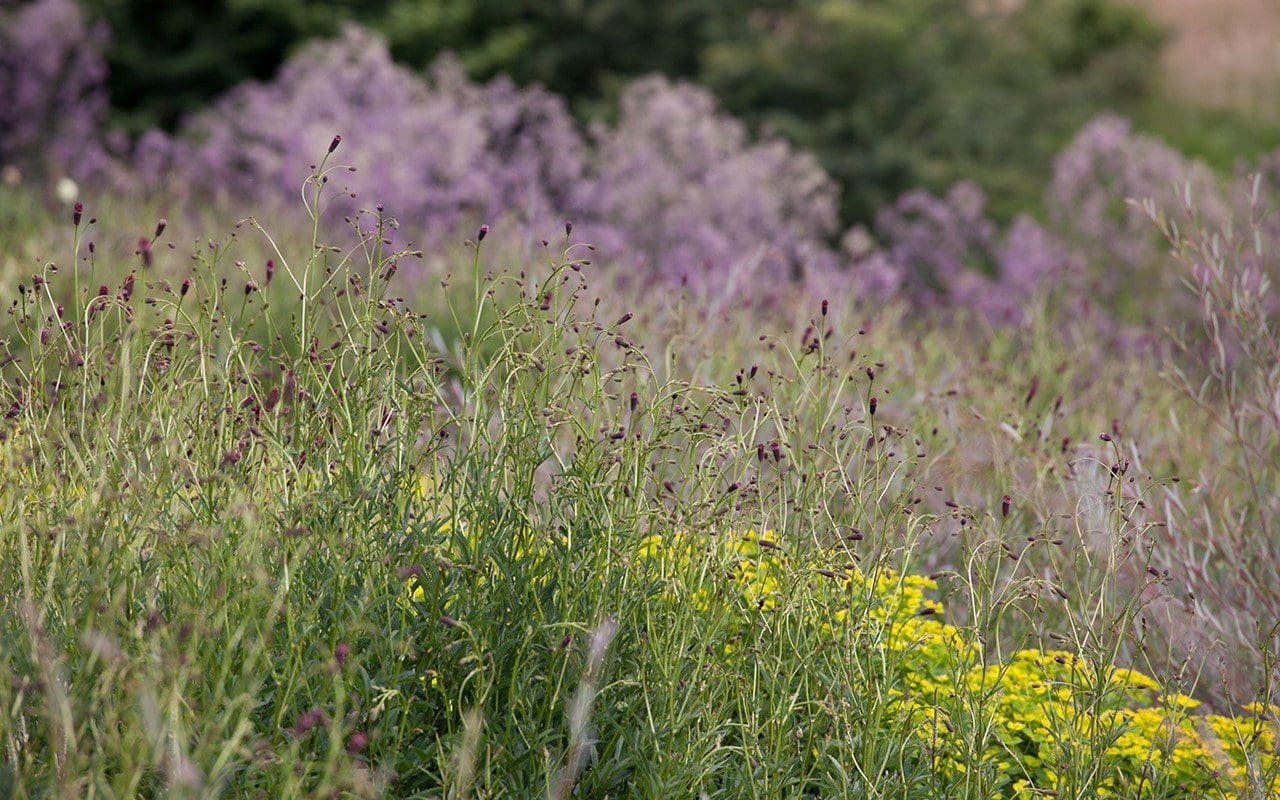 Sanguisorba officinalis ‘Red Thunder’, Euphorbia wallichii and Thalictrum ‘Elin’
Sanguisorba officinalis ‘Red Thunder’, Euphorbia wallichii and Thalictrum ‘Elin’
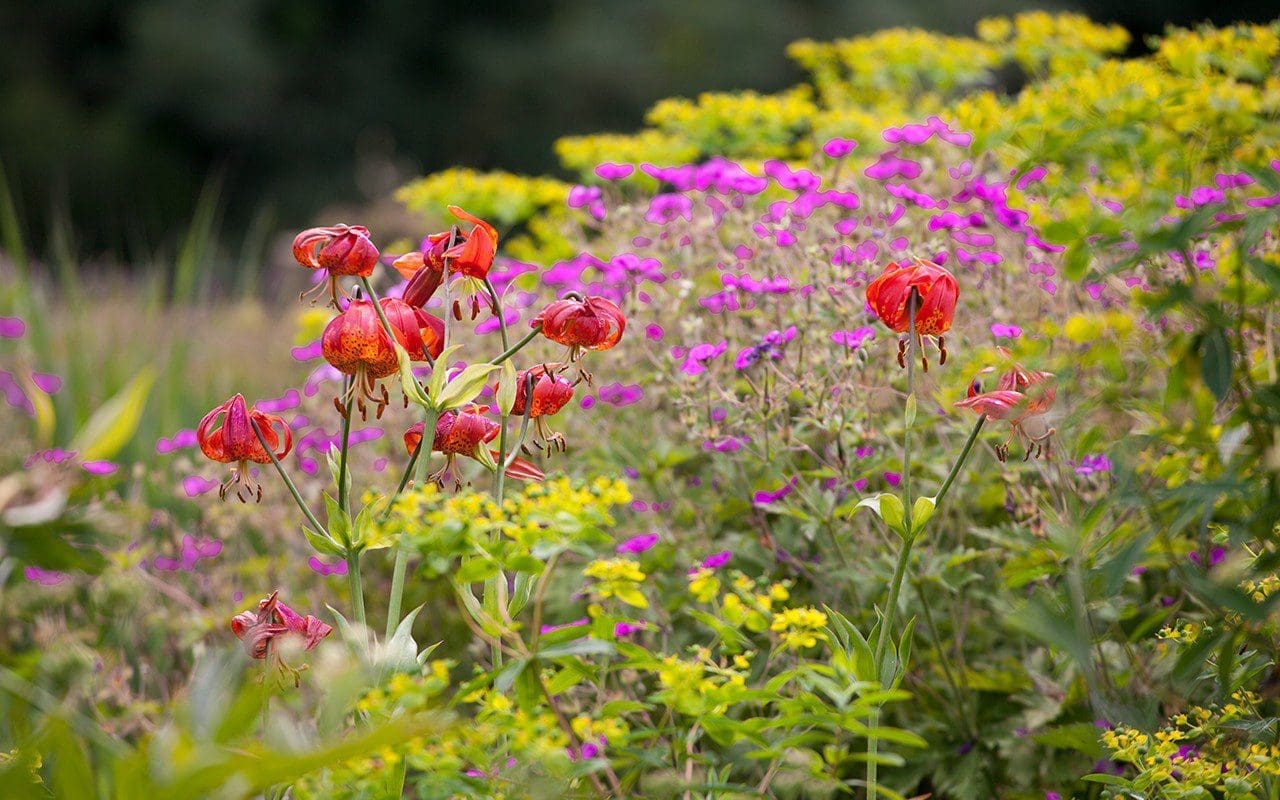 Lilium pardalinum, Geranium psilostemon and Euphorbia cornigera
Lilium pardalinum, Geranium psilostemon and Euphorbia cornigera
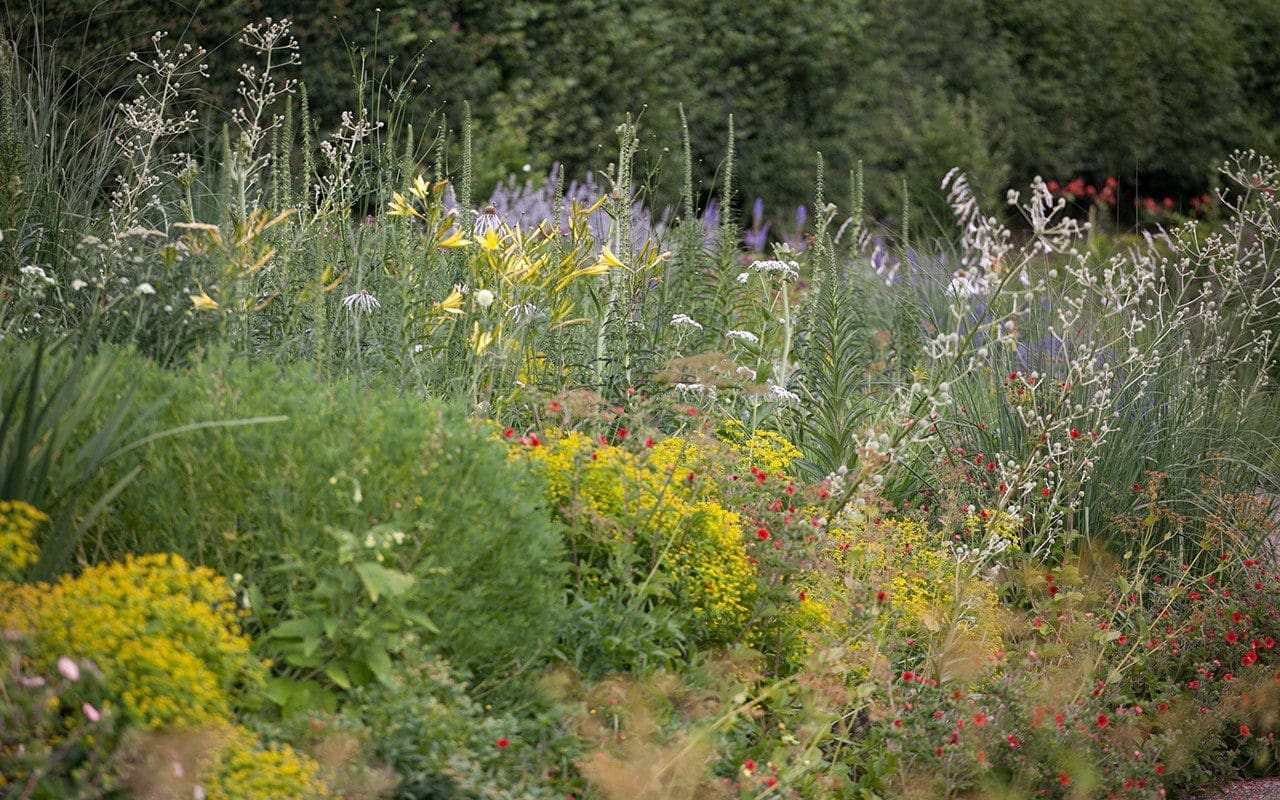 The newly planted central area
The newly planted central area
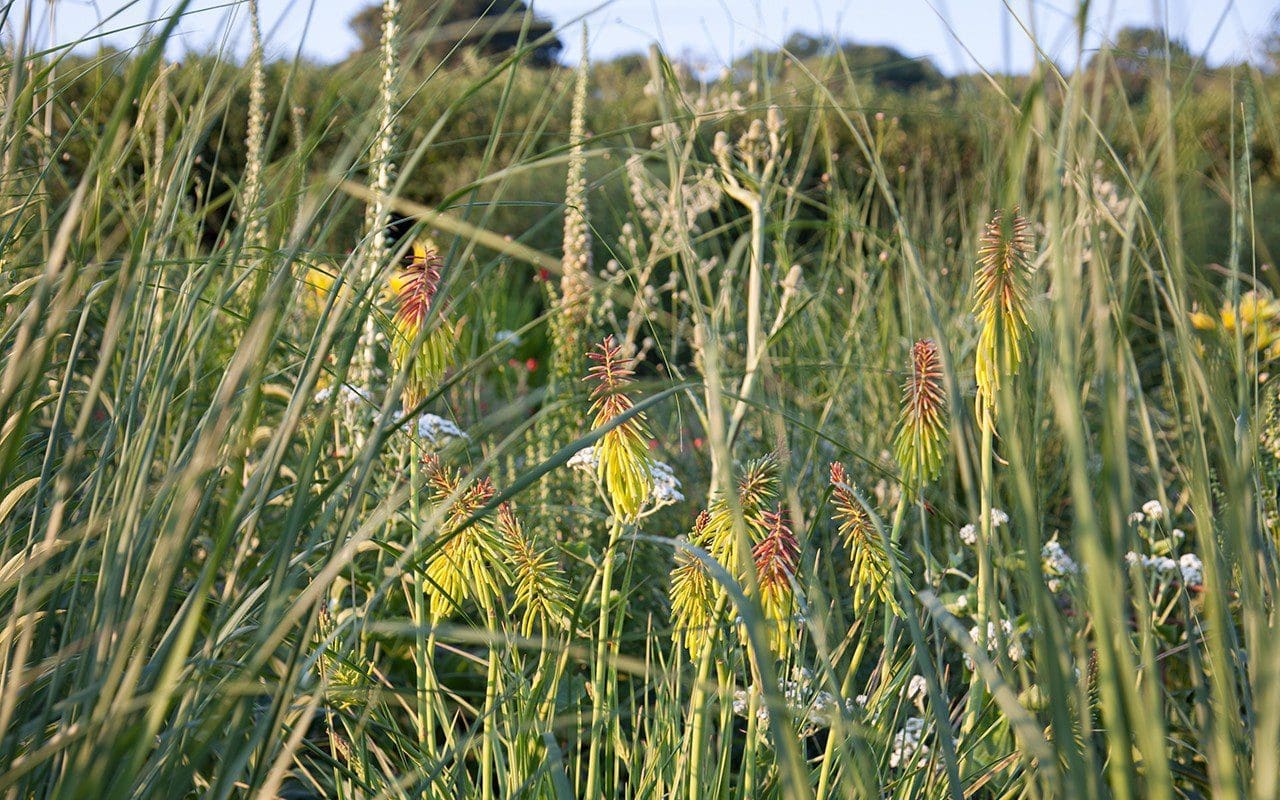 Kniphofia rufa, Eryngium agavifolium and Digitalis ferruginea
Kniphofia rufa, Eryngium agavifolium and Digitalis ferruginea
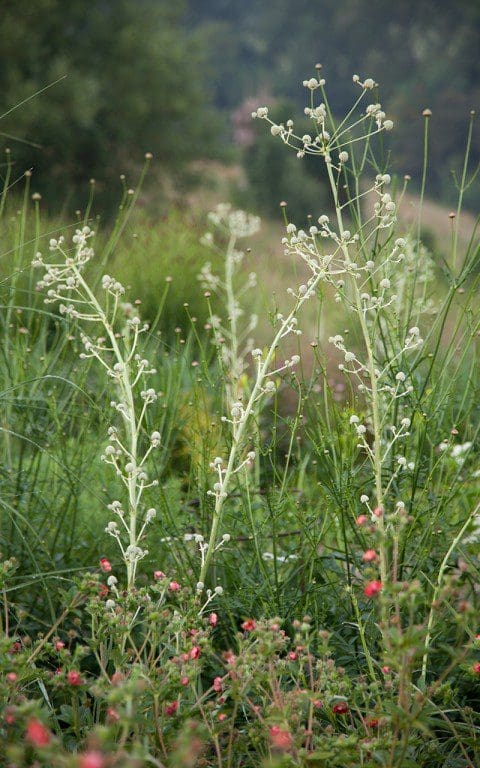 Eryngium eburneum
Eryngium eburneum
There is little shade anywhere else and the higher up the site you go the drier it gets as the soil gets thinner. This is reflected in a palette of silvers and reds with plants that are adapted to the drier conditions. I am having to make shade here with tall perennials such as Aster umbellatus so that the Persicaria amplexicaulis ‘Blackfield’, which run through the upper bed, do not scorch. Where the soil gets deeper again at the intersection of paths, a stand of Panicum virgatum ’Cloud Nine’ screens this strong colour so it can segue into the violets, purples and blues in the beds below. I have picked up the reds much further down into the garden with fiery Lilium pardalinum. They didn’t flower last year and have not grown as tall as they did in the shelter of our Peckham garden, but standing at shoulder height, they still pack the punch I need.
The central bed, and my favourite at the moment, is detailed more intensely, with finer-leaved plants and elegant spearing forms that rise up vertically so that your eye moves between them easily. Again a lime green undercurrent of Euphorbia ceratocarpa provides a pillowing link throughout and a constant from which the verticals emerge as individuals. Flowering perennials are predominantly white, yellow and brown, with a link made to the hot colours of the upper bed with an undercurrent of pulsating red Potentilla ‘Gibson’s Scarlet’. Though just in their first summer, the Eryngium agavifolium and Eryngium eburneum are already providing the architecture, while the tan spires of Digitalis ferruginea, although short-lived, are reliable in their uprightness.
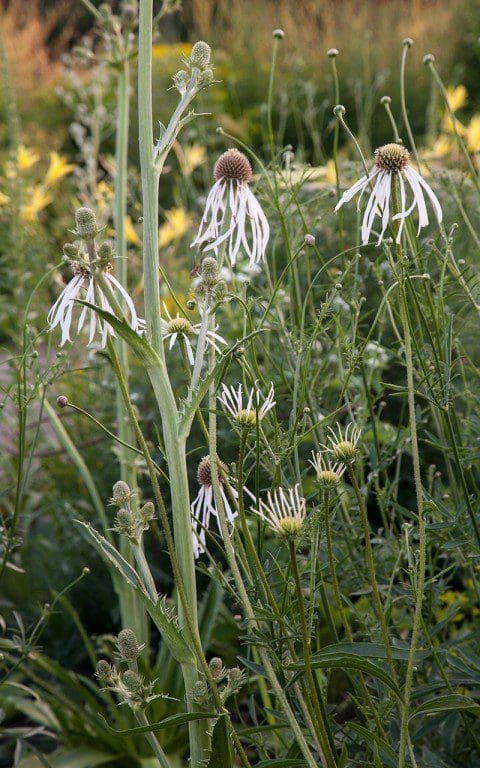 Echinacea pallida ‘Hula Dancer’ and Eryngium agavifolium
Echinacea pallida ‘Hula Dancer’ and Eryngium agavifolium
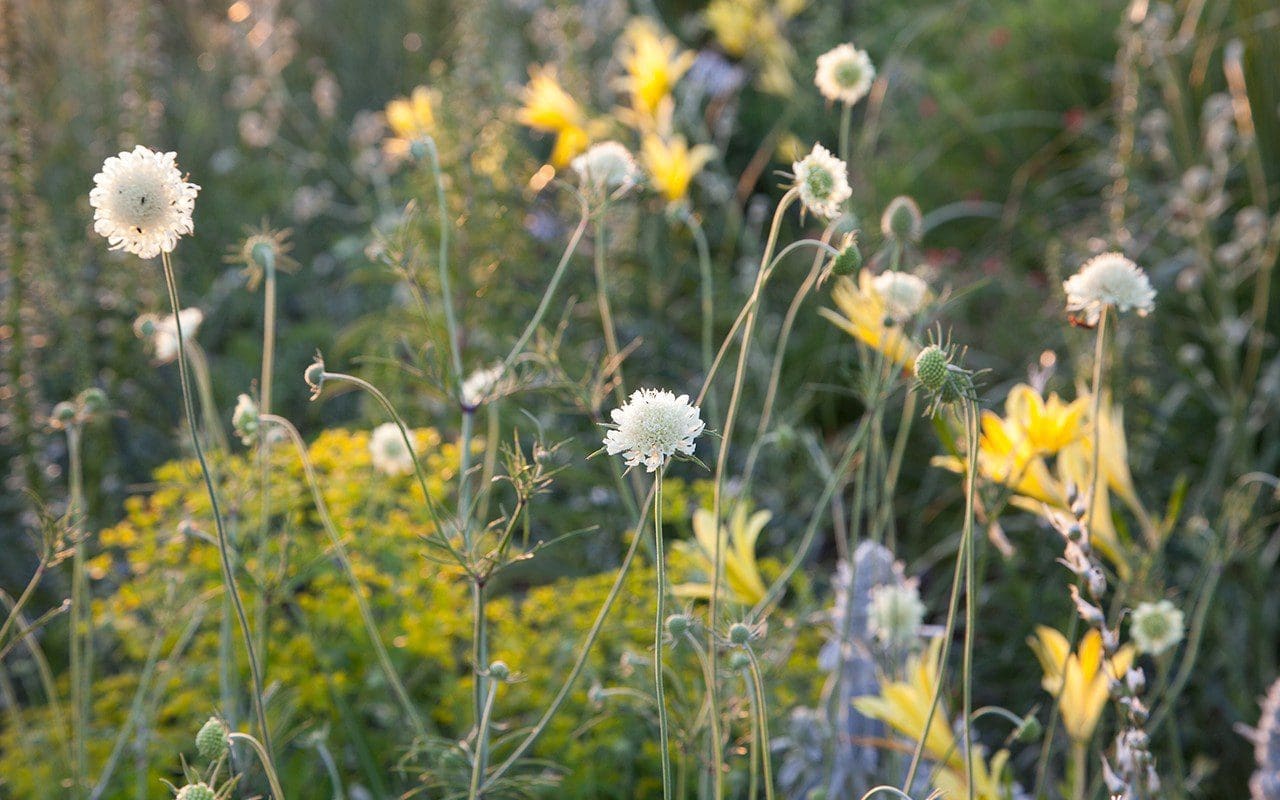 Scabiosa ochroleuca
Scabiosa ochroleuca
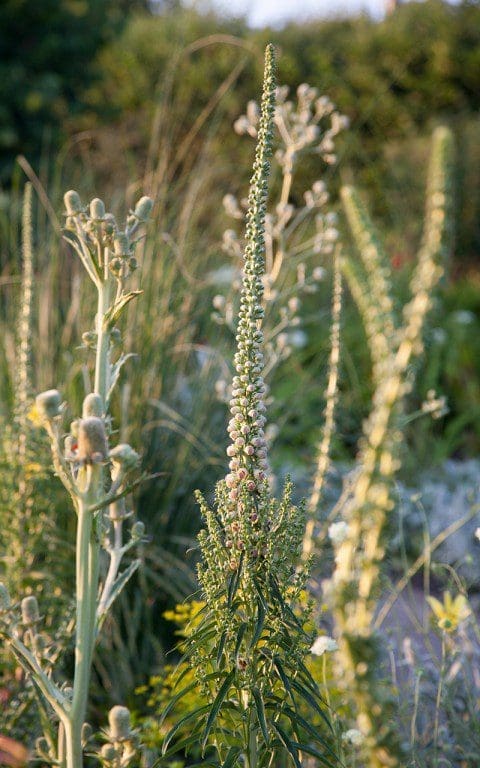 Digitalis ferruginea, Eryngium agavifolium and E. eburneum
Digitalis ferruginea, Eryngium agavifolium and E. eburneum
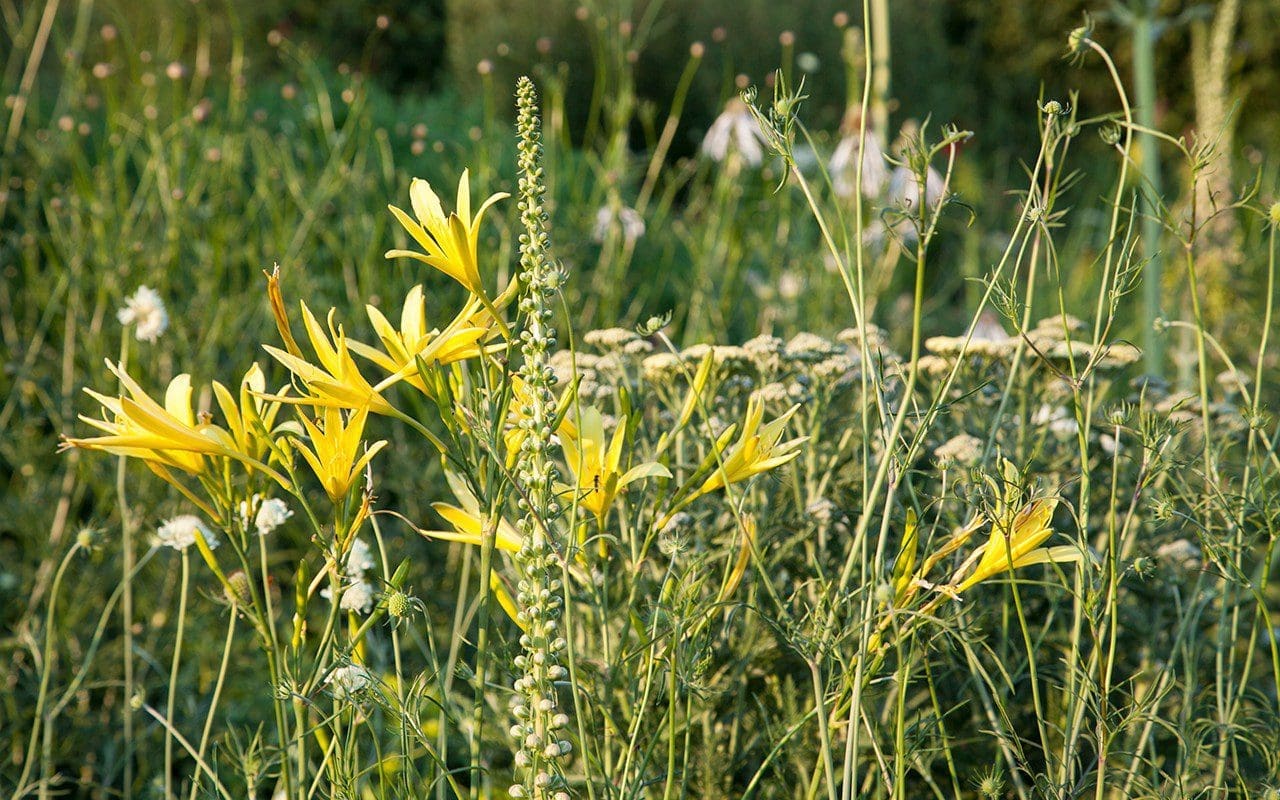 Hemerocallis ochroleuca var. citrina, Digitalis ferruginea, Achillea ‘Mondpagode’ and Scabiosa ochroleuca
Hemerocallis ochroleuca var. citrina, Digitalis ferruginea, Achillea ‘Mondpagode’ and Scabiosa ochroleuca
It has been good to have had the pause between planting up the outer beds in spring last year, before planting the central and upper areas in the autumn. We are now seeing the whole garden for the first time as well as the softness and bulk of last year’s planting against the refinement and intensity of the new inner section. Constant looking and responding to how things are doing here is helping this new area to sit, and for it to express its rhythms and moments of surprise.
I am taking note with a critical eye. Will Achillea ‘Mondpagode’ have a stay of execution now that it is protected in the middle of the bed ? Last year, planted by the path, it toppled and split in the slightest wind. Where are the Rudbeckia subtomentosa ‘Henry Eilers’ and, if they have failed, how will I get them in again next year when everything will be so much bigger ? Have I put too many plants together that come too early ? Too much Cenolophium denudatum, perhaps ? How can this be remedied ? Later flowering asters and perhaps grasses where I need some later gauziness. Will the Dahlia coccinea var. palmeri grow strongly enough to provide a highlight above the cenolophium and, if not, where should I put them instead ? The season will soon tell me. The looking and the questioning keep things moving and ensure that the garden will never be complete.
Words: Dan Pearson / Photographs: Huw Morgan
Published 7 July 2018
The Thalictrum ‘Elin’ are as spectacular as they ever will be, topped out at what must be almost ten feet in height and clouding a myriad of tiny flower. They are in their second year now and have been good from the day they broke their winter dormancy. Last year they sent up just a couple of spires each but, with roots deep and a year behind them, they have powered a forest of lustrous growth. First, an early mound of feathery foliage of a glaucous, thunderous grey flushed with purple and bronze which, by the end of April, had reached its full expansion and was ready to charge the ascent of muscular vertical stems soaring towards the solstice. Slowing once they had reached their full height, the panicles broadened as the lateral limbs filled out with a million buds. The ascent was every bit as remarkable as the cloud of smoky violet flower. Arguably more so for the dramatic build and anticipation.
‘Elin’ march through the planting in the lower part of the garden to provide punctuation, and I am depending upon them now to stay standing. Last year, when their limbs were heavy with flower, a rain-laden wind toppled them like ninepins, so I staked them with a waist-height hoops in early May to prevent a repeat performance. In our deep, hearty soil with plenty of sunshine and no early competition around their crowns, there has been nothing to hold them back, so I have grown them hard and so far denied them extra water. I am hoping this will mean that they grow more strongly and that their companion sanguisorbas help them to stay true.
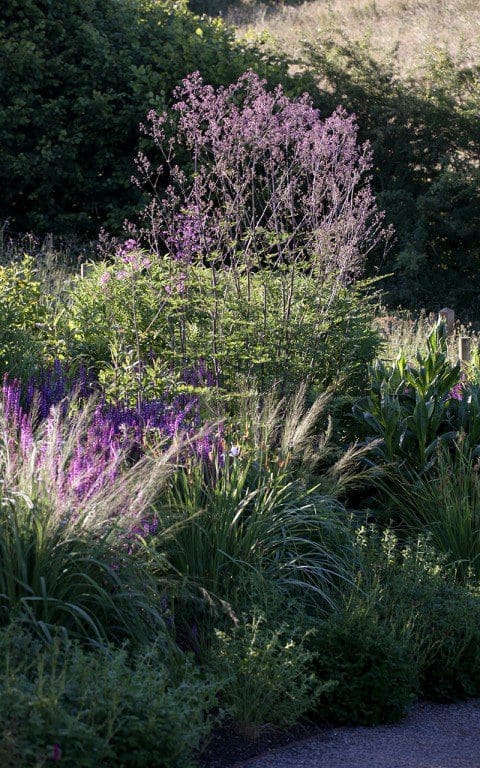
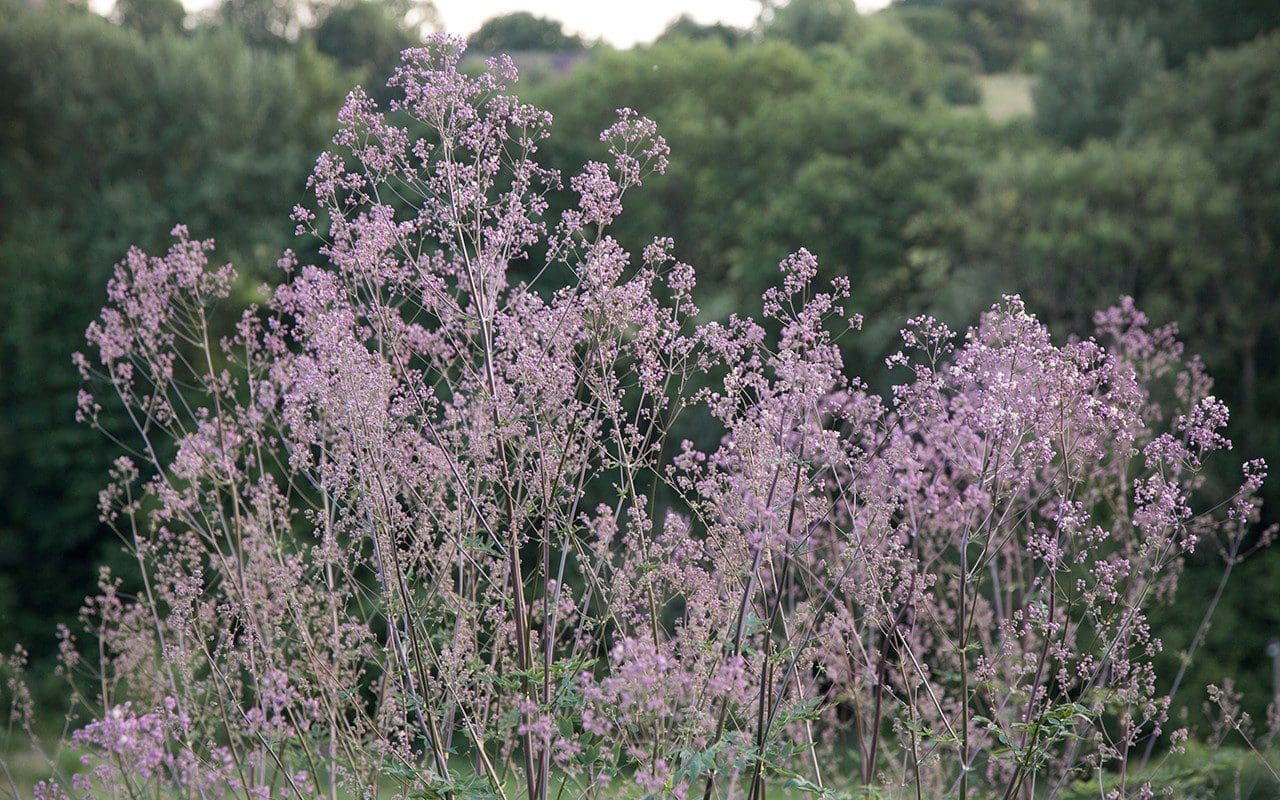 Thalictrum ‘Elin’
Thalictrum ‘Elin’
I have grown Thalictrum aquilegifolium for years, where it is reliable in both sun or shade. A basal clump of foliage – well named for its similarity to columbine – is an early presence in the spring garden and the flowers are sent up early, ahead of most other perennials, so that there is a clear storey between them and their foliage. The wiry stems support clusters of stamen-heavy flowers which, when they are out, resemble exotic plumage. In the true species, the flowers are an easy mauve, but ‘Black Stockings’ (main image with Salvia nemorosa ‘Amethyst’ and Iris sibirica ‘Papillon’) punches the colour up, with dark-stained stems and buds the colour of unripe grapes that open into flowers that register strong violet-pink. I have the white form too, which is strangely rare in cultivation, but not impossible to get. My plants came from the Beth Chatto Nursery, but I will be saving seed, which is viable if sown fresh, and I’m hoping will come true as they are quite some distance in the garden from their cousins. Seedlings that aren’t true white will easily be spotted for they have the purple stain, when the white form is pale, apple green. I plan to have plenty to play with and want to see if they will take in some open ground under the crack willow, where I let the Galium odoratum loose after it misbehaved and took too well to the garden.
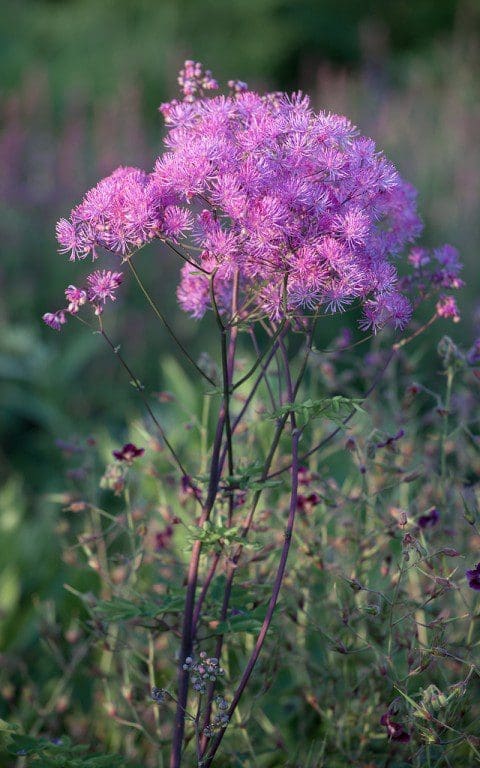 Thalictrum ‘Black Stockings’
Thalictrum ‘Black Stockings’
Until ‘Elin’ appeared on the scene relatively recently, Thalictrum rochebruneanum was the tallest and most dramatic of the tribe. I saw it first at Sissinghurst, where it towered with Cynara in the purple border. As a teenager I lusted after its rangy limbs, impossibly fine it seemed, and the suspense in the delicate flowers. It languished on our thin acidic ground in my parents’ garden, growing to half the height. I tried it again in the Peckham garden, but it hated the way our soil dried as the water table dropped in summer. However, I have grown it well in California where, with a little extra water and shade from the sun, it seeds freely to spring up spontaneously as ‘volunteer’ seedlings. I hope that it will do the same for me here. So far in year two, it has done well, certainly not as well as ‘Elin’ but, with three or four flowering stems per plant, which have enjoyed the light at the base where they have been planted amongst later-to-emerge persicaria.
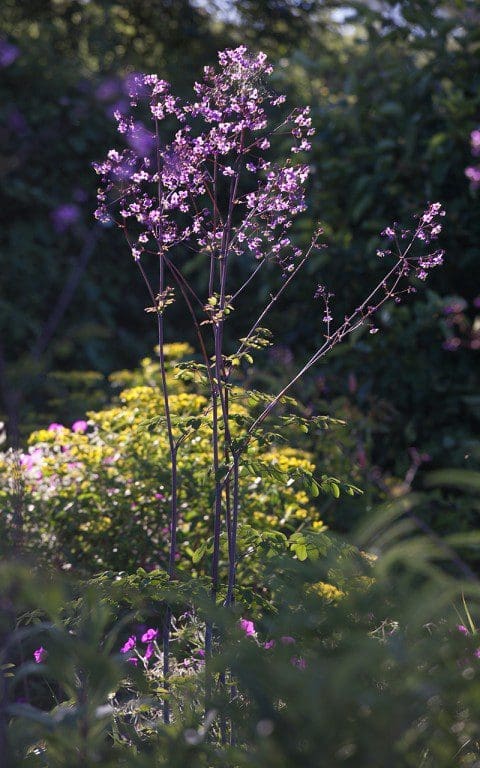
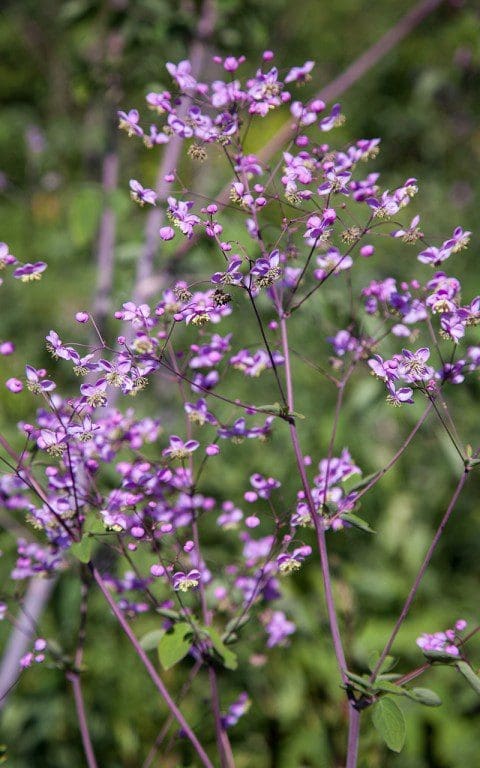 Thalictrum rochebruneanum
Thalictrum rochebruneanum
Hailing from Japan, where they find a niche amongst other perennials that like a cool, retentive soil, they must be a spectacular sight to come upon. Where ‘Elin’ is all about quantity, the flowers forming a Milky Way when they come together, every flower of Thalictrum rochebruneanum is a jewel. Richly coloured like gemstones, held sparsely so that your eye is drawn to the individual, inviting you to spend some time to take in the space and the colour contrast of the inner parts of the flower. A cup of violet petals holds the gold provided by the pollen and projection of anther within.
Never getting everything completely as I want it to be, I see now that I need to bring a plant or two up closer to the path, so that I can take in the detail and enjoy looking up, for you have to, your neck craned. Being early days in this garden, I can only hope for a volunteer or two to take to this ground and let me know that I have finally found them a place they really want to be.
Words: Dan Pearson / Photographs: Huw Morgan
Published 30 June 2018
The last few weeks of growth have been remarkable, the volume and intensity lusher for the wet start and the thunderous, still growing weather. In this lead up to summer the garden was texturally wonderful, the layering of foliage acute for the absence or scarcity of flower. Finely divided mounds of sanguisorba, spearing iris and mounding deschampsia all readying themselves, but yet to show colour. A sense of expectation and the build up to the first round of early summer perennials we have today in this posy.
The colour in the garden is designed to come in waves, like a swathe of buttercups in a meadow, that leads your eye from one place to the next and builds in intensity and then dims as the next thing takes over. After an awakening of single peonies, the salvias are the next contrast to the foundation of greens, which I like here for their ease in the landscape. Though I have never found our native Meadow Clary (Salvia pratensis) on the land, it felt right to bring it into the garden in its cultivated form. We have two named varieties which are early to show and good for their verticality. Salvia pratensis ‘Indigo’, a rich, well-named blue and Salvia pratensis ‘Lapis Lazuli’, which was planted last autumn and is flowering here for the first time this year.
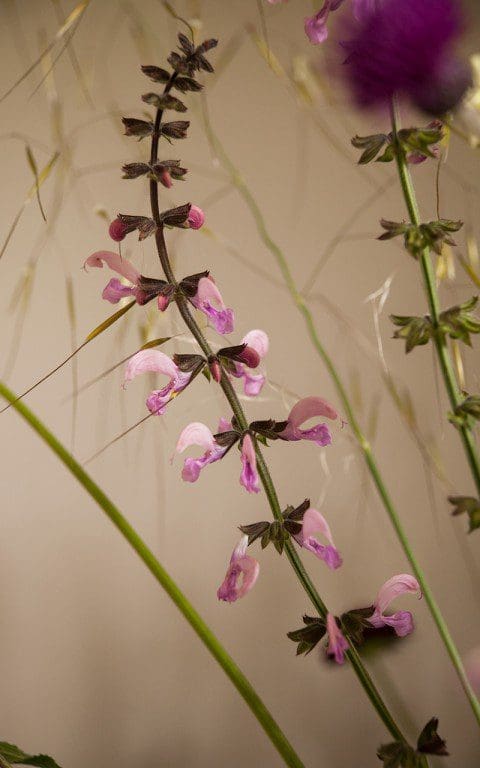 Salvia pratensis ‘Lapis Lazuli’
Salvia pratensis ‘Lapis Lazuli’
Where ‘Indigo’ is perfectly named, ‘Lapis Lazuli’ has nothing of the intensity of the stone it is named after, nor of the ultramarine pigment derived from it. I have a nugget on my windowsill which I found once in Greece, sparkling in crystal clear shallows and catching my eye like a magpie’s. Although I was expecting something brighter and cleaner in colour like my find, the clear, soft pink of ‘Lapis Lazuli’ is anything but disappointing. It has been in flower now since early May for a whole three weeks longer than it’s cousin ‘Indigo’, rising up to two feet in widely spaced spires from a rosette of puckered, matt foliage. I expect it to still be looking good at the end of the month, but shortly before it starts to run out of steam, it will be cut to the base to encourage a second flush.
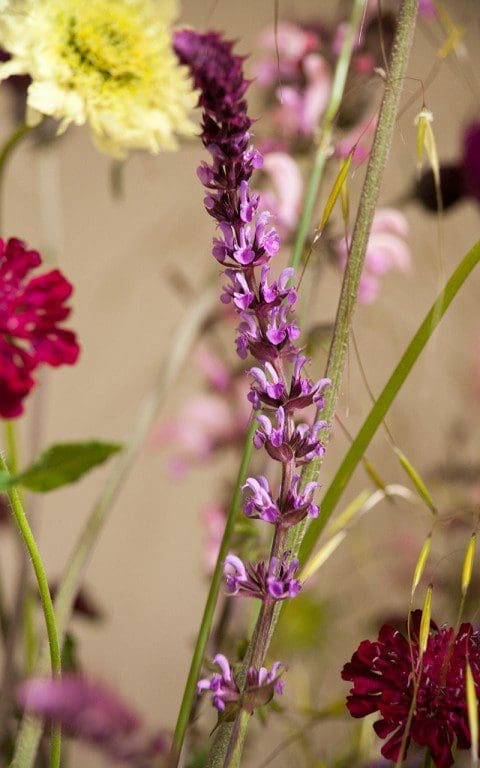 Salvia nemorosa ‘Amethyst’
Salvia nemorosa ‘Amethyst’
The first cut back is always hard, because the salvias are a magnet to moths and bees, but we performed the same severity of cut on ‘Indigo’ last year and it rewarded us with a new foliage and then flower in August. Salvia nemorosa ‘Amethyst’, the second of the salvias in this posy and far better named for it’s jewel-like colouring, will also respond to the same treatment, but it is important to act before the energy has gone out of the plant by curtailing its show before it finishes flowering naturally. Energy put into seed will thus be saved and replaced with more flower and the reward of fresh new growth.
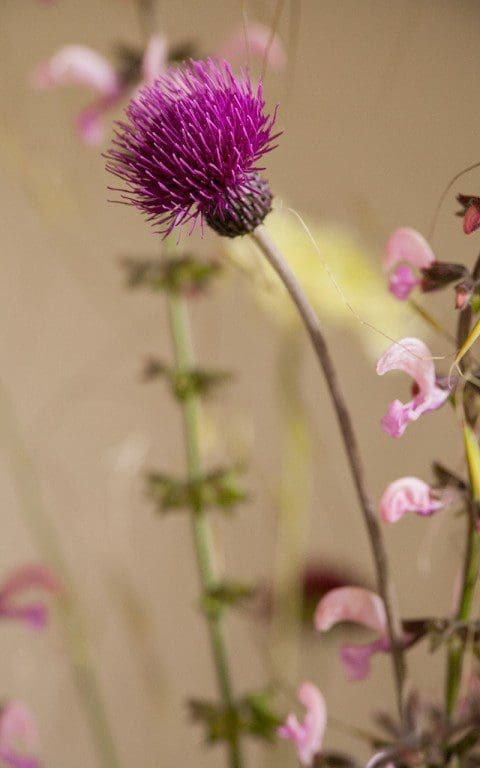 Cirsium rivulare ‘Trevor’s Blue Wonder’
Cirsium rivulare ‘Trevor’s Blue Wonder’
The cirsium and the cephalaria are also encouraged to produce a second round of foliage by cutting them to the base immediately after they flower. Though they are less inclined to throw out more flower, refreshed foliage is just as useful in an August garden, which needs the greens from this early part of the summer to keep the garden looking lively. The Cirsium rivulare ‘Trevor’s Blue Wonder’ in this bunch grows down by the barns, where its early show coincides with baptisia. Though not remotely blue – a theme that is coming through in this posy, it seems – I love the bluer purple of this form just as much as the garnet red of the Cirsium rivulare ‘Atropurpureum’. These early thistles like plenty of light around their basal clump of foliage and look best for having the air you need to appreciate the way their flowers are held high and free of foliage.
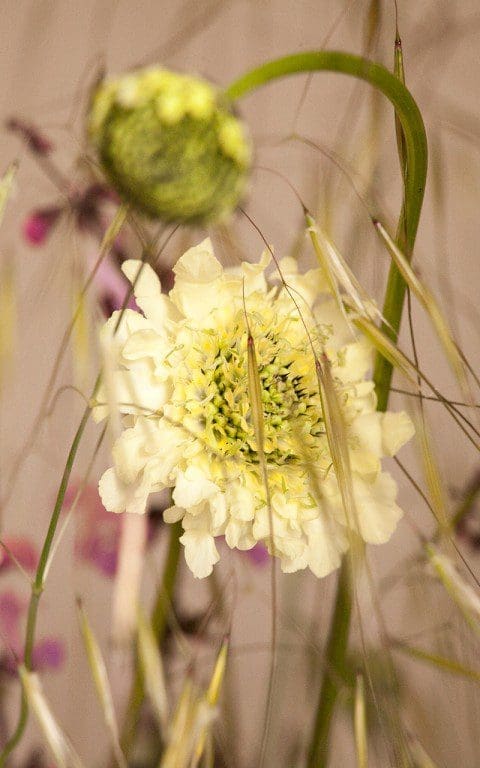 Cephalaria gigantea
Cephalaria gigantea
Cephalaria gigantea is similar in its requirements and looks best when it can punch into air without competition. I grow it as an emergent amongst low Coreopsis verticillata ‘Moonbeam’ at the Millennium Forest in Hokkaido, where they grow ten feet tall on either side of a winding path. The creamy yellow flowers are delightfully sparse and the terminus of a rangy cage of airy growth. Here on our hillside they grow six or seven feet at most and right now appear head and shoulders above their partners. A single plant will leave a sizable hole in a planting if you choose to fell it after flowering, as I do for fresh growth, so it is wise to combine it with later performing partners that ease its temporary absence. Asters, grasses and sanguisorba cover for me here.
I have two more species that are part of the new planting and will flower for me for the first time here this year. Cephalaria alpina is a smaller cousin which is more delicate in all its parts, terminating at about four feet and forming a low mound of divided foliage. Cephalaria dipsacoides, teasle-like in its naming and also in its vertical nature, is up to six feet tall, but grows upright from the base. Creamy in colour like its cousins, but differing from all the plants in this posy in being later to flower and prolifically seeding if it likes you. Although I love its seed heads and the structure they offer the autumn garden, I will be cutting the plants down prematurely before they seed. A practice I am having to employ here with several of the self-seeders, as I do not have the manpower to manage the progeny.
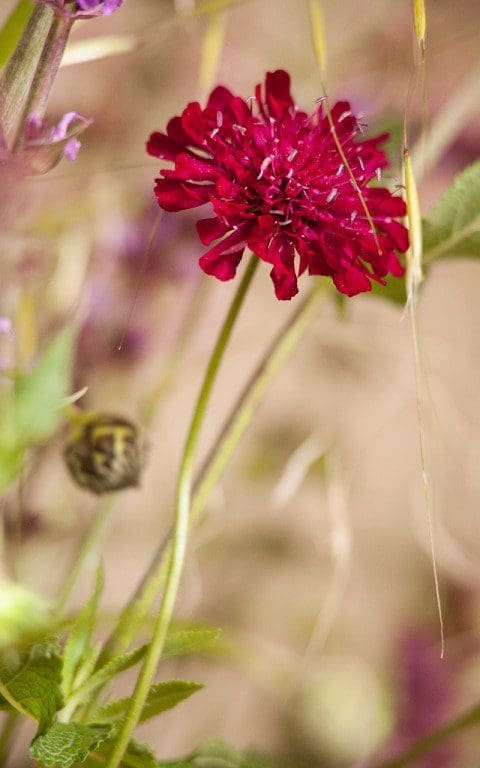 Knautia macedonica
Knautia macedonica
A case in point being Knautia macedonica, that I will now treat as a useful filler where I need something fast and reliable. Our ground is almost too rich for this pioneer and in year two the plants splay fatly where they have been living too well. It too seeds prolifically, and my failure to deadhead them last summer resulted in a rash of seedlings this spring, which showed that it could be a problem if left to go native. A few seedlings on standby, however, will provide me with gap fillers where I need them and a succession of this ruby-red scabious that hovers amongst its neighbours. We pull any pink seedlings, favouring the bloodline of those with darker genes.
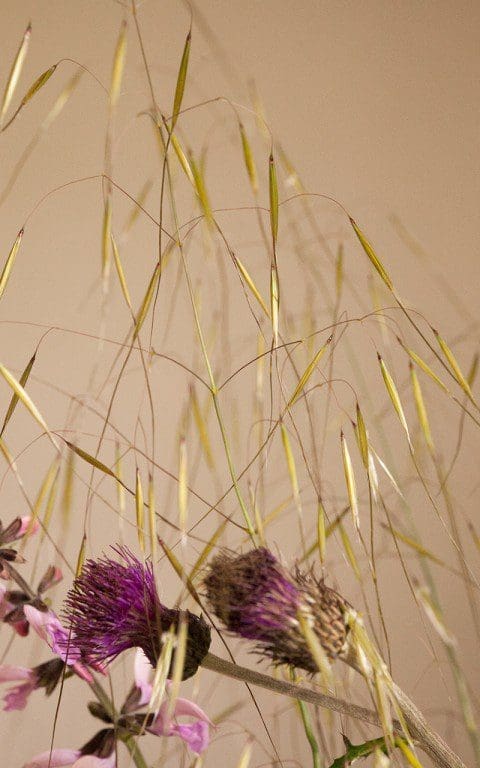 Stipa gigantea
Stipa gigantea
Stipa gigantea, the Giant Oat Grass is a plant that I have not grown since Home Farm, where it was a mainstay of the Barn Garden. For a while this grass became so fashionable that I avoided using it, despite its obvious beauty and, without enough room to grow it in the Peckham garden, I gave myself a breather. However, I am very happy to have it back and have given it the room it needs to look its best and for its low mound of evergreen foliage to get the light it needs. Right now it is at its most captivating, the lofty panicles, pale copper before turning gold and heavy with yellow pollen, dancing lightly to catch the long evening light. It is an early grass, bolting sky-bound plumes in May and taking June in a shower of luminosity and light.
Words: Dan Pearson / Photographs: Huw Morgan
Published 16 June 2018
It is that time again, a relay of one spectacle running into the next. In the hedgerows the hawthorns burst and spilled in Hockneyesque flurries, dimming only for a moment before being replaced by guelder rose and now the first of the elder with its creamy tiers piled high. In the garden, where we are working towards a similar principle of massed succession, the Rosa ‘Cooperi’ has helped us to connect to these whites in the landscape and jump the boundaries, so that your eye can travel a distance. First close up and then out, to leap from hedgerow to hillside.
I first saw Rosa ‘Cooperi’ about twenty years ago when I was judging the open gardens of Islington. It was love at first sight and I asked for and came away with a cutting, which rooted readily and took over the wall at the end of the garden in Peckham. It grew there vigorously and now I smart to think what the current owners must be dealing with, because this is a rose that needs headroom. A cutting was dutifully brought to Hillside where I released it onto the old barns (main image) and, seven years later, it is showing not a sign of slowing. Its limbs, reaching continually out and away from the last year’s extension growth, can easily make three to four metres in a season, though it is said to reach no more than ten. As the best flowering wood is the previous year’s, it makes sense to let it advance without curbing it too vigorously, and so it clouds and softens the building’s outline.
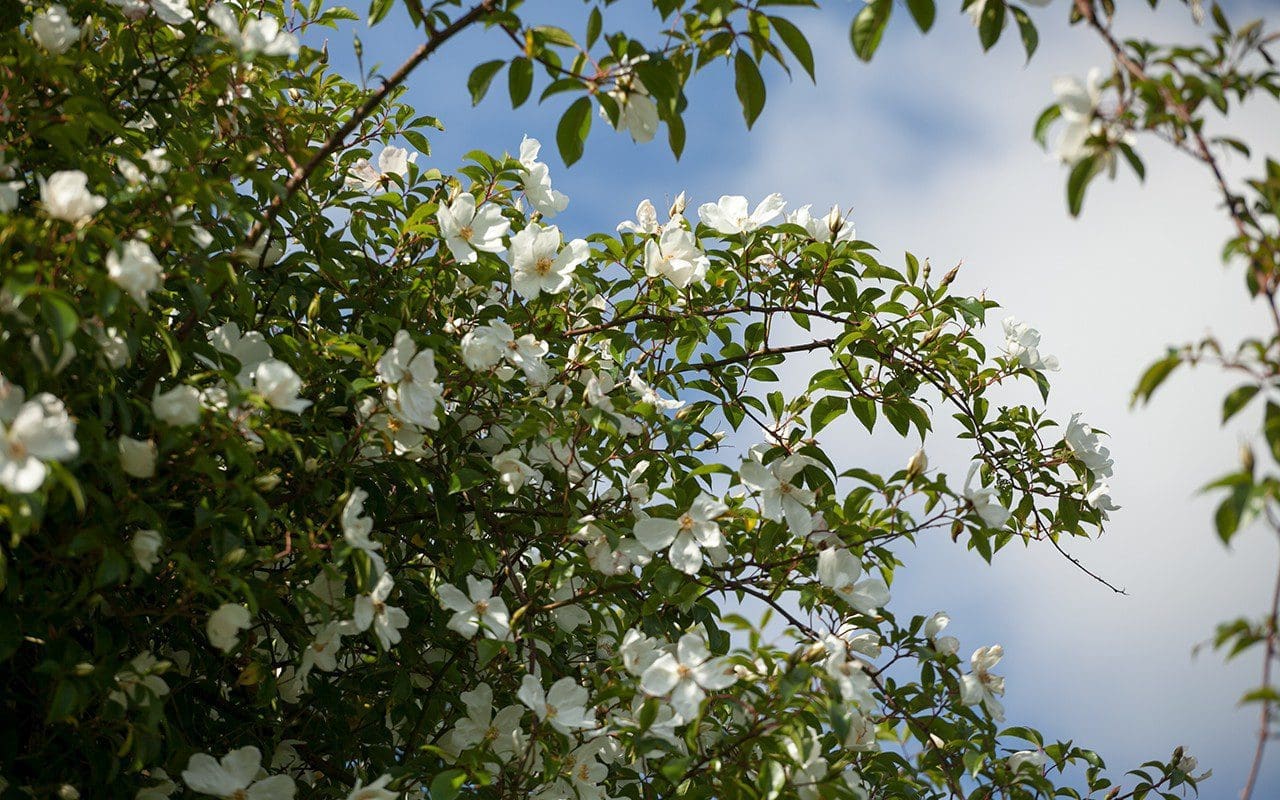
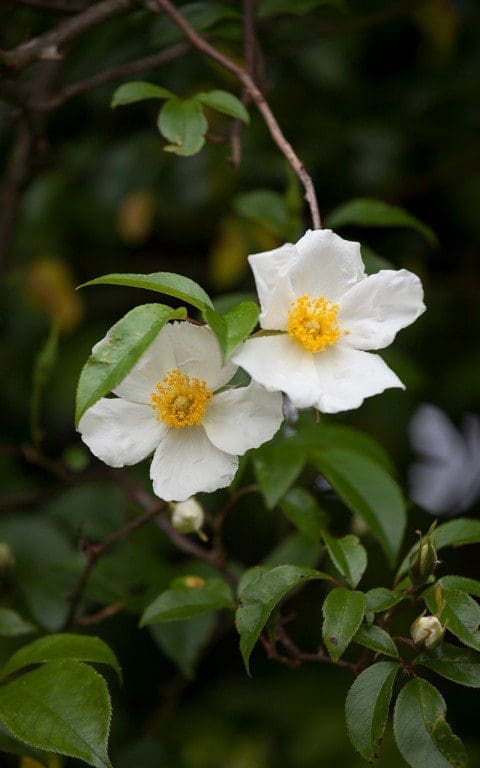 Rosa ‘Cooperi’ – Cooper’s Burmese rose
Rosa ‘Cooperi’ – Cooper’s Burmese rose
I keep it from overwhelming the barn – for it has made its way inside as well as out – by cutting back the excess of viciously thorned limbs in winter. You have to tie down your hat, or it will be whipped from your head, and wear tough clothing, never a jumper, which will be laddered and have you snared in moments. Wrangling aside, the dark, glossy foliage is the perfect foil for a succession of simple, ivory flowers that this year smattered in the last week of May and were at their zenith last weekend when these photographs were taken.
In form they are as pure as dog roses, but twice the size, becoming speckled pink if they get rained upon and as they age. The display lasts three weeks reliably, a month if you are lucky, but I never complain about this brevity. In fact, there are two glossy cuttings waiting in my holding area for somewhere to release them into grass. I’d like to see how ‘Cooper’s Burmese’ would take to not having anywhere to climb. I have a hunch it might mound and then stop its advance with nowhere to go, so in long grass on a bank I could simply edit its longest limbs from a sensible distance with long-armed pruners.
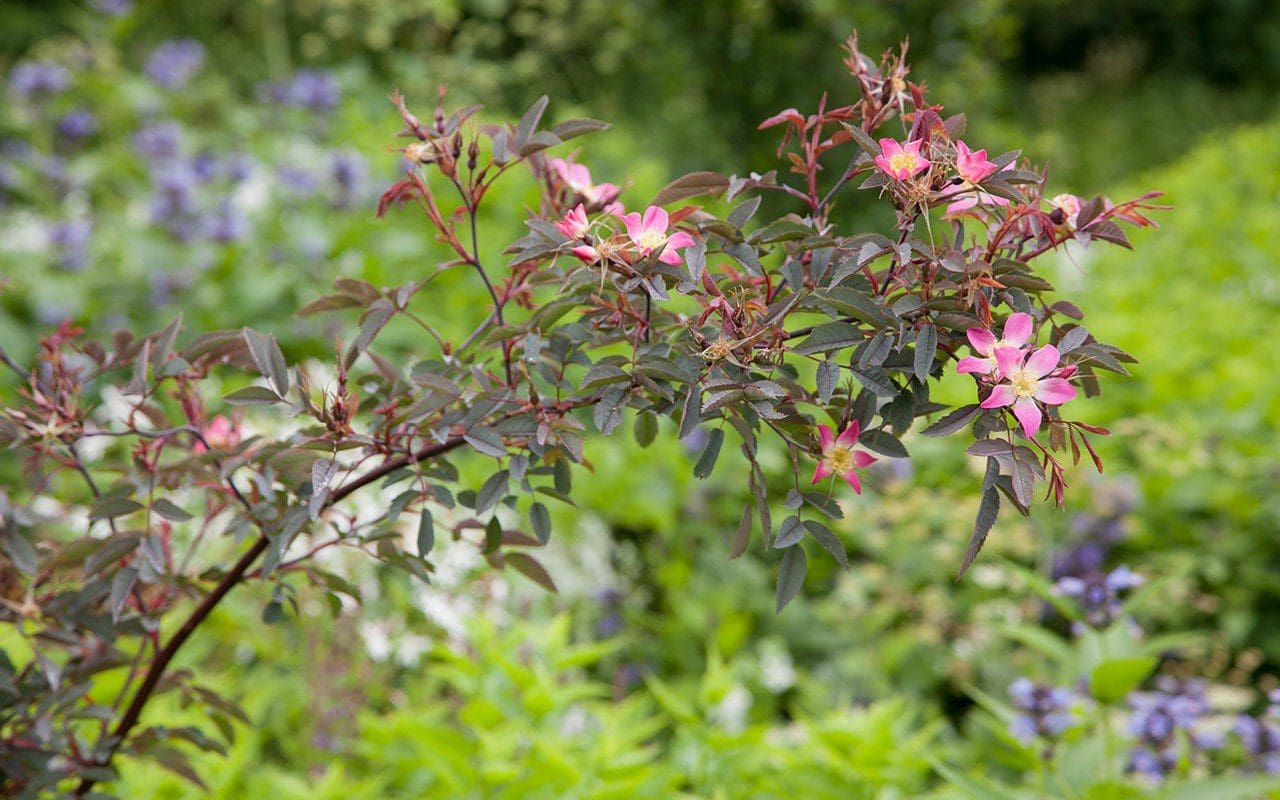
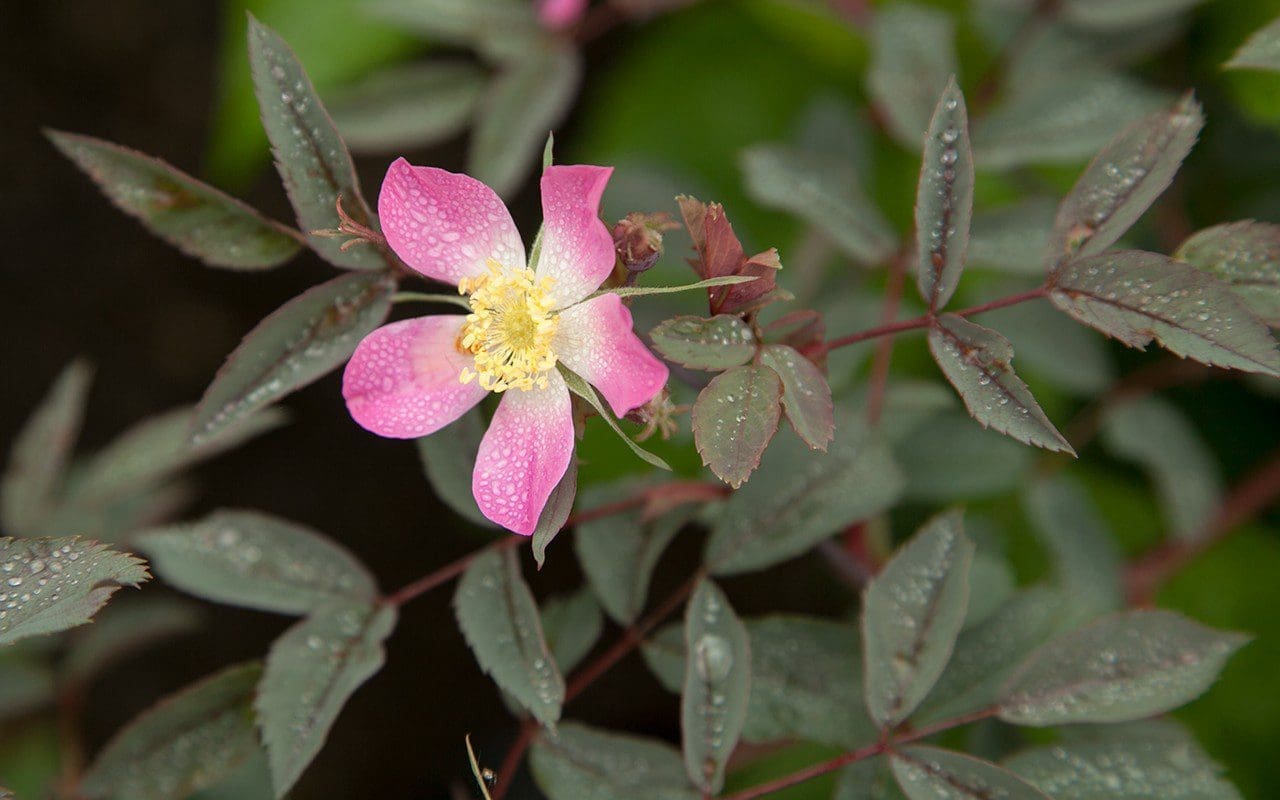 Rosa glauca
Rosa glauca
We have removed all the double David Austin roses from the garden and made a cutting area where they sit in sensible rows with dahlias and cutting peonies. Their opulence is wonderful in a vase, but not where I want things to feel on the wild side. Instead, Rosa glauca has made its way into the perennial planting, Its young coppery foliage ages to a completely matt grey-green as June gives way to full summer and it makes a delectable background, arching elegantly and scattering tiny, perfectly formed, pink dog roses along its limbs, which become mahogany-dark hips in autumn. I love it and am pleased to have it back after not having the room when gardening in London. If left untouched it will form a loose bumound of six foot in all directions. However, it can be coppiced hard every third or fourth year for the benefit of new, strongly coloured foliage, although you will have to wait a year before it starts to flower again.
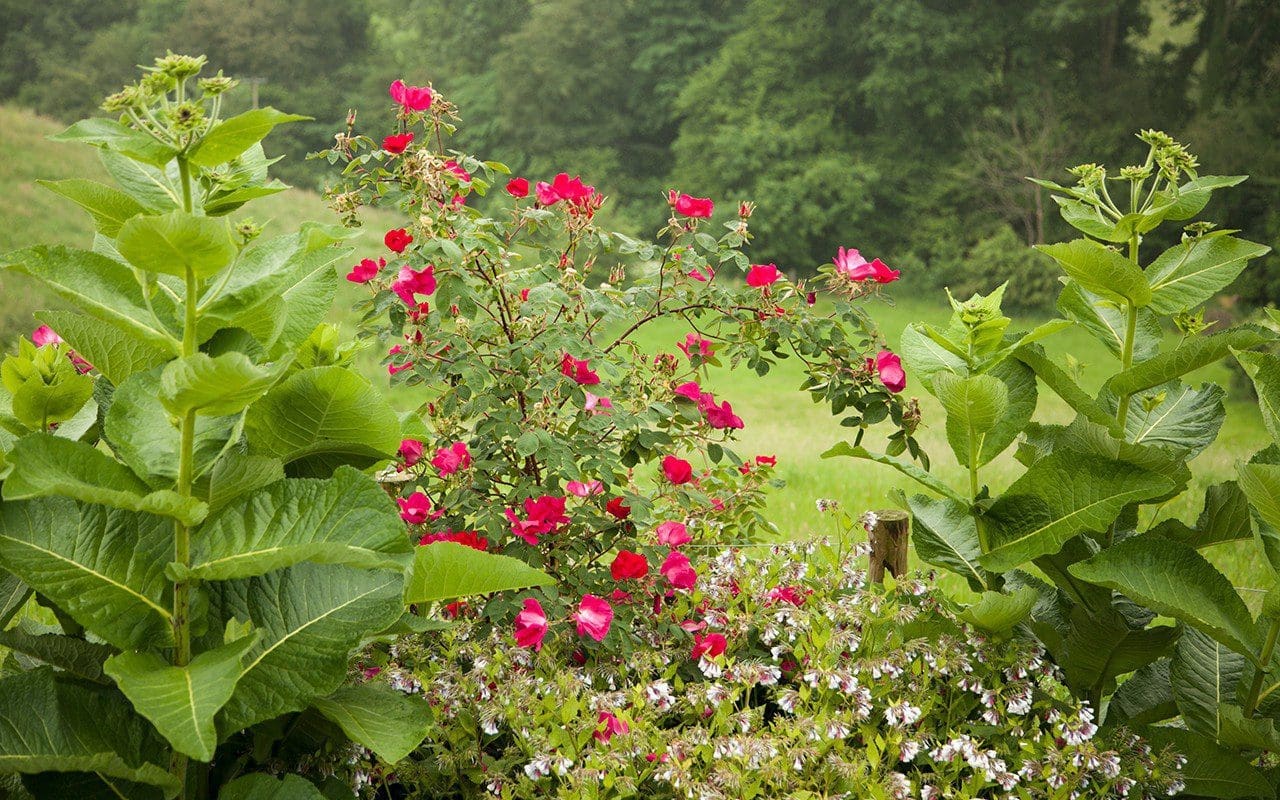
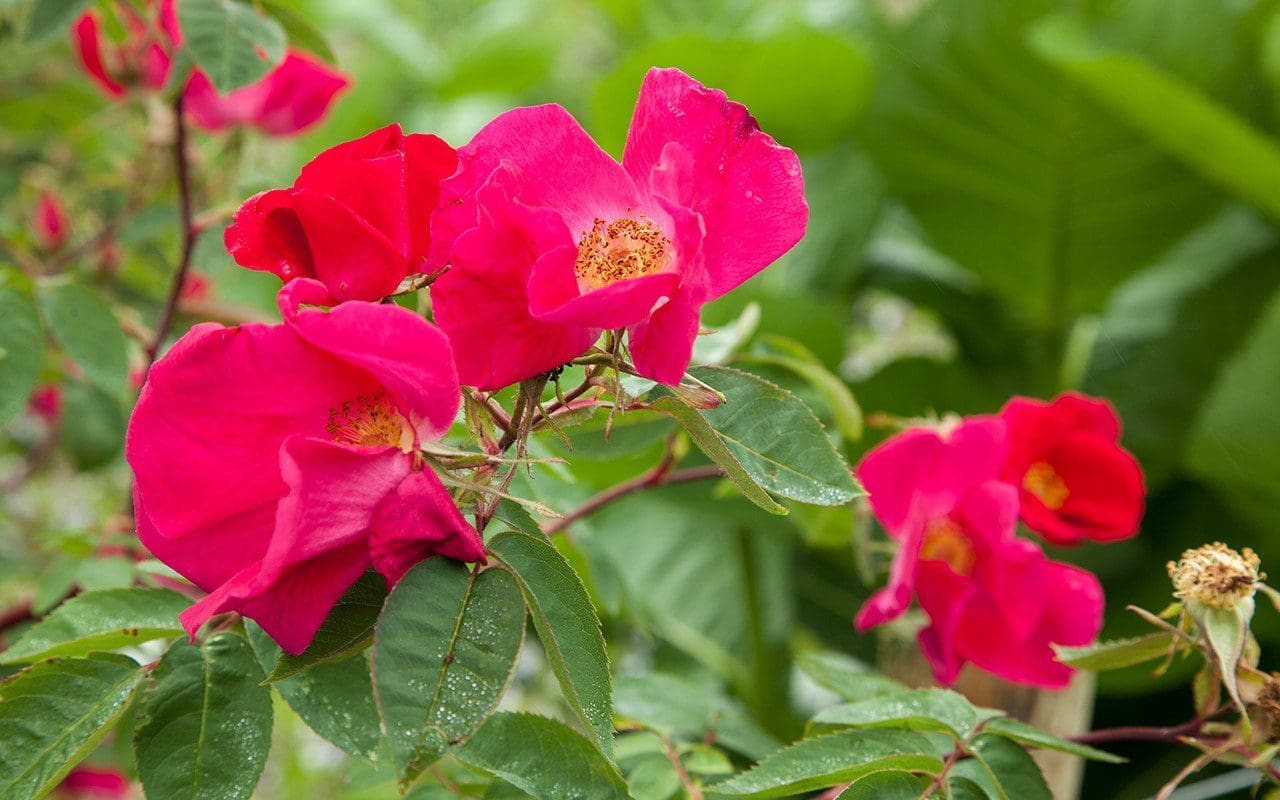 Rosa ‘Scharlachglut’
Rosa ‘Scharlachglut’
The last time I grew Rosa ‘Scharlachglut’ was at Home Farm, where it spilled through the gold-flowered oat grass, Stipa gigantea, in the Barn Garden. Cultivated roses and grasses make curious bedfellows in the borders, but the singles sit well with informality. The colour in the enclosed space of the Barn Garden was deliberately provocative and you could feel the race of your pulse when the reds and pinks came together. ‘Scharlachglut’ means ‘Scarlet Blaze’ (it is sometimes sold as ‘Scarlet Fire’) and, true to its name, it flames fiercely against the green in the landscape here, but I am delighted to see it unapologetically announcing summer.
Though once blooming – as are its companions above – its brevity is remarkable. Scarlet, perfectly shaped buds open bright vermilion and age to a hot, cerise pink so that a range of colour appears along the length of arching limbs. As the flowers age they also increase in size and, although perfume is not its greatest strength, no matter, its presence is astonishing. Though I currently have it growing through comfrey and inula for later, as the planting matures I will add cow parsley so that the scarlet is suspended in cooling white. The timing is at the point of crossover where the lace of the anthriscus is dimming. When the cow parsley is over they will both be gone.
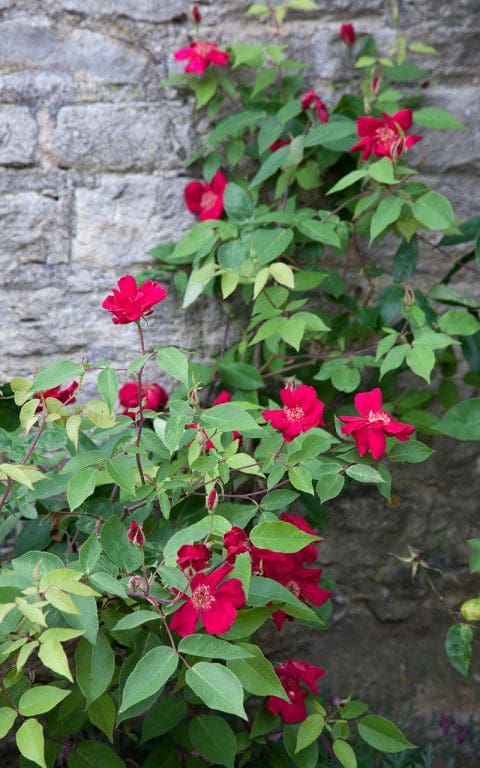
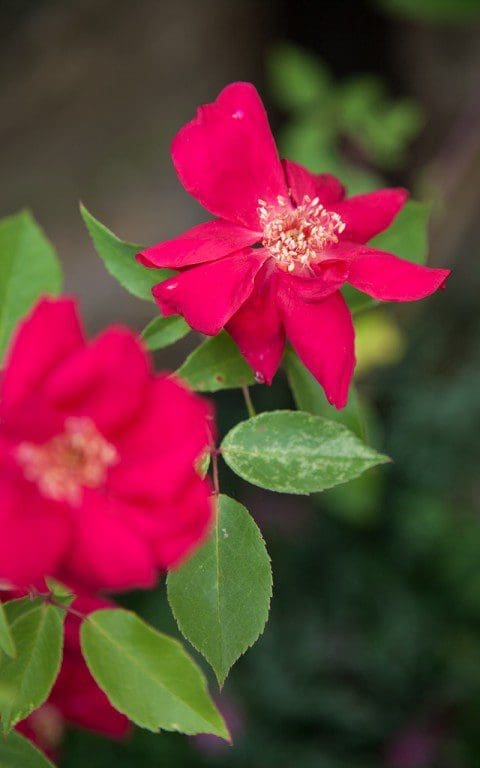 Rosa x odorata ‘Bengal Crimson’
Rosa x odorata ‘Bengal Crimson’
Up by the house, and the only recurrent rose in this collection, is Rosa x odorata ‘Bengal Crimson’. Once again, this is a cutting from the garden in Peckham, where my original plant will be presenting less of a problem to its owners. Rosie Atkins gave me the mother plant when she was the curator at The Chelsea Physic Garden. It grows there in several places, spilling informally from the borders, for it is almost impossible to prune. The growth is soft and thornless, the limbs reaching whichever way they choose to go, but forming something lovely despite the lax behaviour. Being slightly tender, it loves London living and will easily grow to two metres or more in each direction against a wall, or taller with support in a sheltered position.
It hated life here initially and my young cutting burned and frazzled where it was exposed in its windy holding position. I have now found it a sheltered corner in the lea of the house where it looks like it ought to. Soft and choice, with pale, apple-green foliage and flowers that refuse to conform to order. Opening from perfect buds of crimson intensity, the single flowers rarely open completely, but fold and roll informally, fading so that they too have variance when they come together. As they do, one after another without pausing, until winter curtails the willingness to throw out more growth. That said, it is often in flower at Christmas, although by then the flowers are chilled to a softer pink. With a plant that is always so giving, it is important to repay it with the care of deadheading by taking the spent sprays back to fresh new growth. In doing so, you can give it just the amount of attention it needs to keep the plant looking good and, after a brief pause, it will respond with more flower. A simple exchange, and an opportunity to spend some time up close with this beauty.
Words: Dan Pearson / Photographs: Huw Morgan
Published 9 June 2018
For the first three or four years here we grew row upon row of dahlias in the old vegetable garden. They soaked up the light in the first half of summer and flung it back again in a riot of colour later. We grew upwards of fifty, with rejects making way for new varieties from one year to the next to test the best and the most favoured. The dahlias were completely out of character with what I knew I wanted to do here but, like children in a sweetshop, we had the space to play and so we indulged.
Three years of experimentation left us gorged and satiated, but a handful made it through to become keepers. All singles, and delicate enough to be worked into the naturalism of the new planting, we kept Dahlia coccinea ‘Dixter’ for sheer stamina of performance, Dahlia merckii ‘Alba’, the most delicate of all, and the demurely nodding Dahlia australis. Proving to be perfectly hardy with a straw mulch as insurance against the cold they have made good garden perennials. The exception is a scarlet cactus dahlia that outshone the blaze of competition in the trial. Originally bought as ‘Hillcrest Royal’, but mis-supplied, we grew it in our old garden in Peckham and loved it enough to bring it with us and, then again, to keep it in the cutting garden. Unable to identify it correctly after many years of sleuthing we named it ‘Talfourd Red’ after the south London road we lived on and I cannot imagine an autumn now without its flaring fingers.
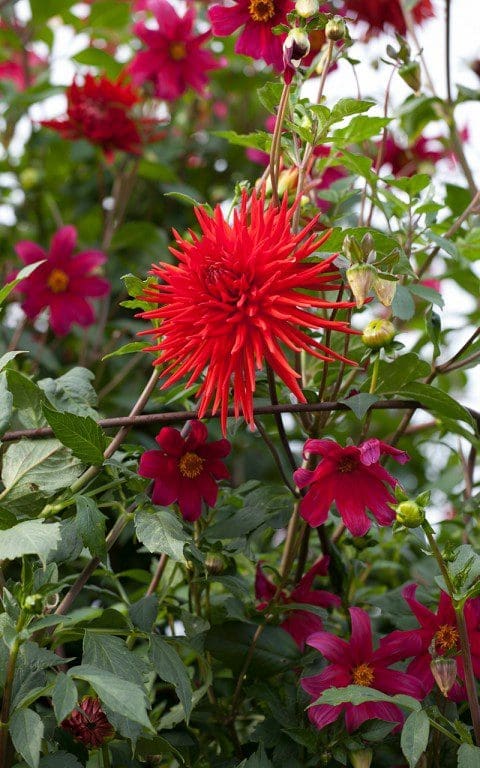 Dahlia ‘Talfourd Red’ and Dahlia coccinea ‘Dixter’
Dahlia ‘Talfourd Red’ and Dahlia coccinea ‘Dixter’
I do like a new plant, and getting to know Tithonia rotundifolia for the first time this year is enabling me to see how it might be used to inject some late summer heat into a planting. We already have a handful of favourites here that are tried and trusted and loved for their intensity of colour, which builds as the growing season wanes. In the case of the Tropaeolum majus ‘Mahogany’, they are almost at their best sprawling and vibrant in the damp cooling days and allowed to climb into their neighbours. The seed originally came from the garden of Mien Ruys at least twenty years ago. I had gone with two friends on an inspirational trip to see what was happening in naturalistic gardens in Holland and Germany and we stopped to meet her in her wonderful garden. The seed was scattered on the pavement over which it was sprawling and a few found their way, with her consent, into my pocket.
This ‘Mahogany’ is not what you will get if you look for it in the seed catalogues. Indeed, it now seems to be unavailable apart from in the United States and ‘Mahogany Gleam’ is a different thing altogether. The leaves are a brighter more luminous green than usual and the flowers a jewel-like ruby red. I have been territorial ever since I started to grow it and winkle out any that come up with a darker leaf or paler flower. It self-seeds willingly every spring, letting you know when the soil is warm enough to sow and where the warmest parts of the vegetable garden are. The seedlings exhibit the same bright foliage so it is easy to weed out the occasional rogue, which might have reverted to the darker more typical green. We currently grow ‘Mahogany’ in the kitchen garden amongst the asparagus and use the leaves and flowers to garnish salad.
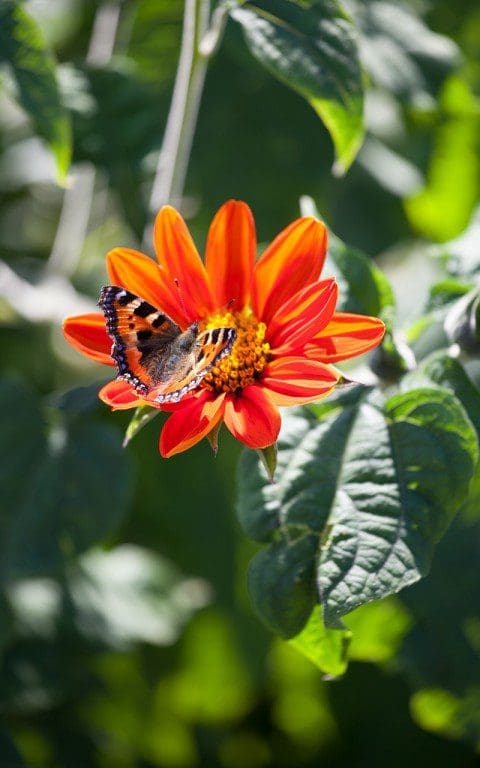 Tithonia rotundifolia ‘Torch’
Tithonia rotundifolia ‘Torch’
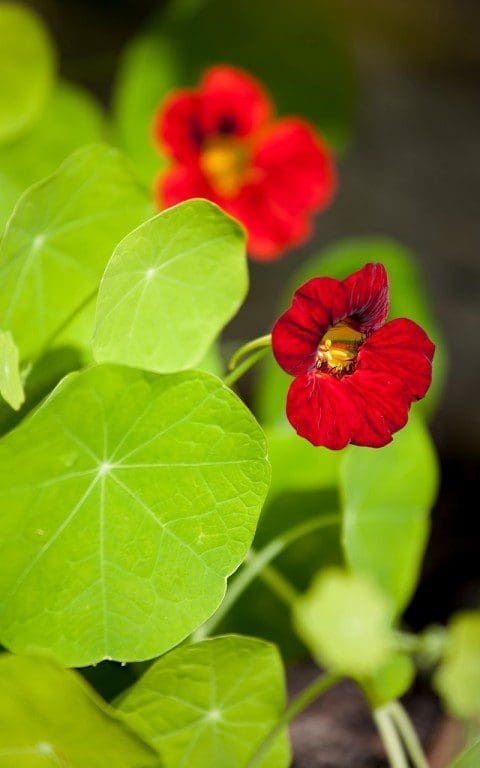 Tropaeolum majus ‘Mahogany’
Tropaeolum majus ‘Mahogany’
Close by, and growing this year in two old stoneware water filters, is Tagetes patula. This wild form will grow up to three or four feet with a little support or something to lean on and flowers from June until it is frosted. The colour is absolutely pure and as vibrant and saturated a saffron yellow as you can find. It is easily germinated from seed under cover in spring and fast, so best to wait until mid-April to sow. I harvest my own seed and keep it apart from the dark, velvety Tagetes ‘Cinnabar’ (main image), which it will taint. Seedlings that have crossed will no longer have the deep richness that makes this latter plant so remarkable. I was disappointed to find this spring that the mice had eaten all the seed I’d left out in the tool shed and was expecting to have the first of many years without it. However, as luck would have it and quite out of the blue, they somehow found their way some distance into the new herb garden. Maybe it was mice doing me a favour with the plants I left standing in the kitchen garden last winter. Another lesson learned.
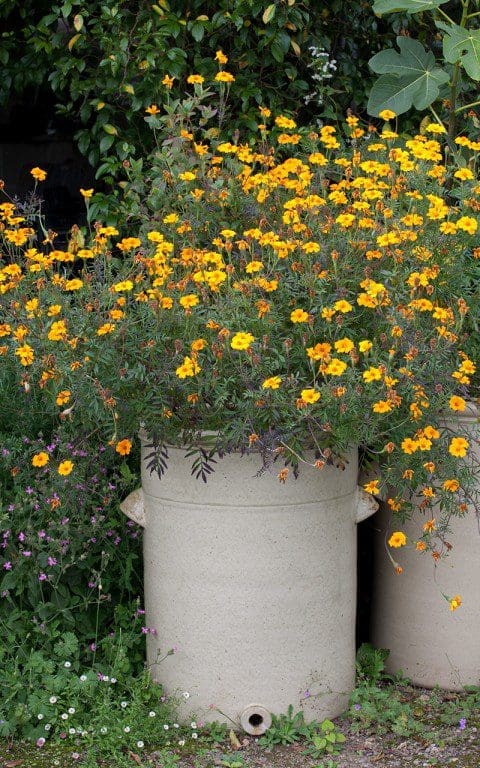
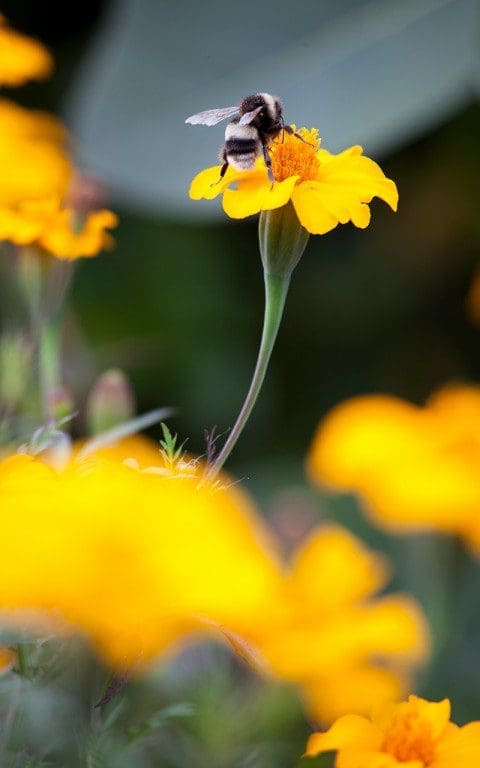 Tagetes patula
Tagetes patula
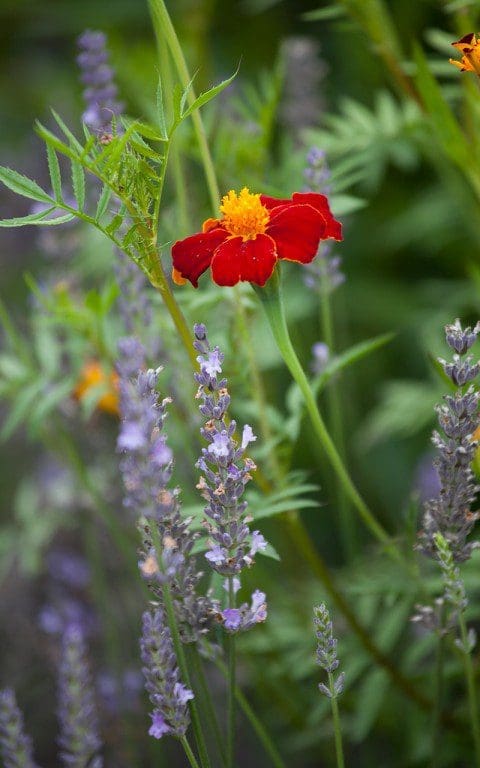 Tagetes ‘Cinnabar’
Tagetes ‘Cinnabar’
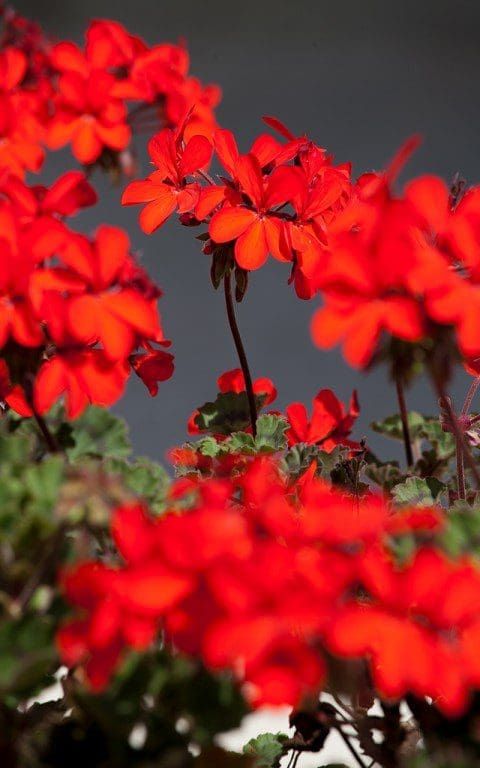 Pelargonium ‘Stadt Bern’
Pelargonium ‘Stadt Bern’
My father was never afraid of colour and always commented on the brilliance of Pelargonium ‘Stadt Bern’, which is the best, most brilliant red I have ever come across. Purer for the flowers being properly single, with elegant tear-shaped petals and thrown into relief against darkly zoned foliage. I bought a tray of plants from Covent Garden Market twenty five years ago for my Bonnington Square roof garden and have managed to keep them going ever since. Given how archetypal it is for a pot geranium I have no idea why it is not more freely available, but there are always a handful of cuttings in the frame which are for giving away to friends, who are given these precious things on the understanding they are part of keeping a good thing going, and that they are my insurance for any unexpected losses.
Words: Dan Pearson / Photographs: Huw Morgan
Published 23 September 2017
A month ago I was in Japan, on my annual visit to the Tokachi Millennium Forest in Hokkaido. I have been working at the forest for sixteen or seventeen years now and the yearly journey is always rewarding. It is a place with a big vision, where half the side of a mountain and the forested foothills are the domain. It has the feeling of the north, with air that slips over the mountains from Russia not so far away. Bears really do live in the woods and the landscape freezes to minus twenty-five, under a blanket of pristine white from early November through to the end of April.
The owner, Mitsugishe Hyashi, bought the land with the ambition of offsetting the carbon footprint of his newspaper business, but the park represents far more than this. He also set out for it to be sustainable for the next thousand years and it is a privilege to have been part of this vision and to be a small part in shaping the park’s direction.
The gardens and the managed forests are a big part of helping to communicate the big idea to visitors. The gently managed places, which take the rough edges off the wilderness, are part of making people feel comfortable in the areas that are accessible. Takano Landscape Planning, which put together the original masterplan, knew that the people and their comfort in the environment were important and, when I was asked to be part of the project in 2000, it was to help with creating a series of spaces that would provide the landscape with a focus for the public.
 The Earth Garden
The Earth Garden
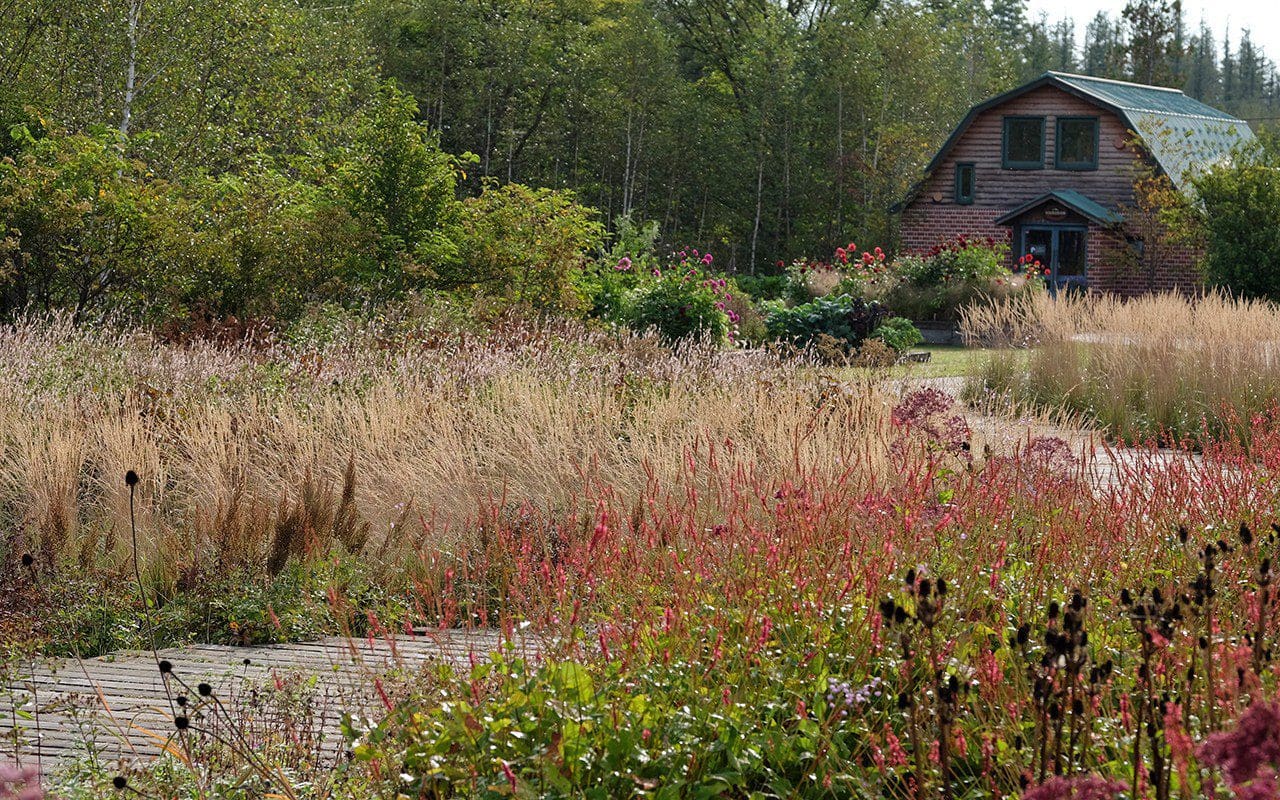 The Goat Farm and Farm Garden at the end of the Meadow Garden
The Goat Farm and Farm Garden at the end of the Meadow Garden
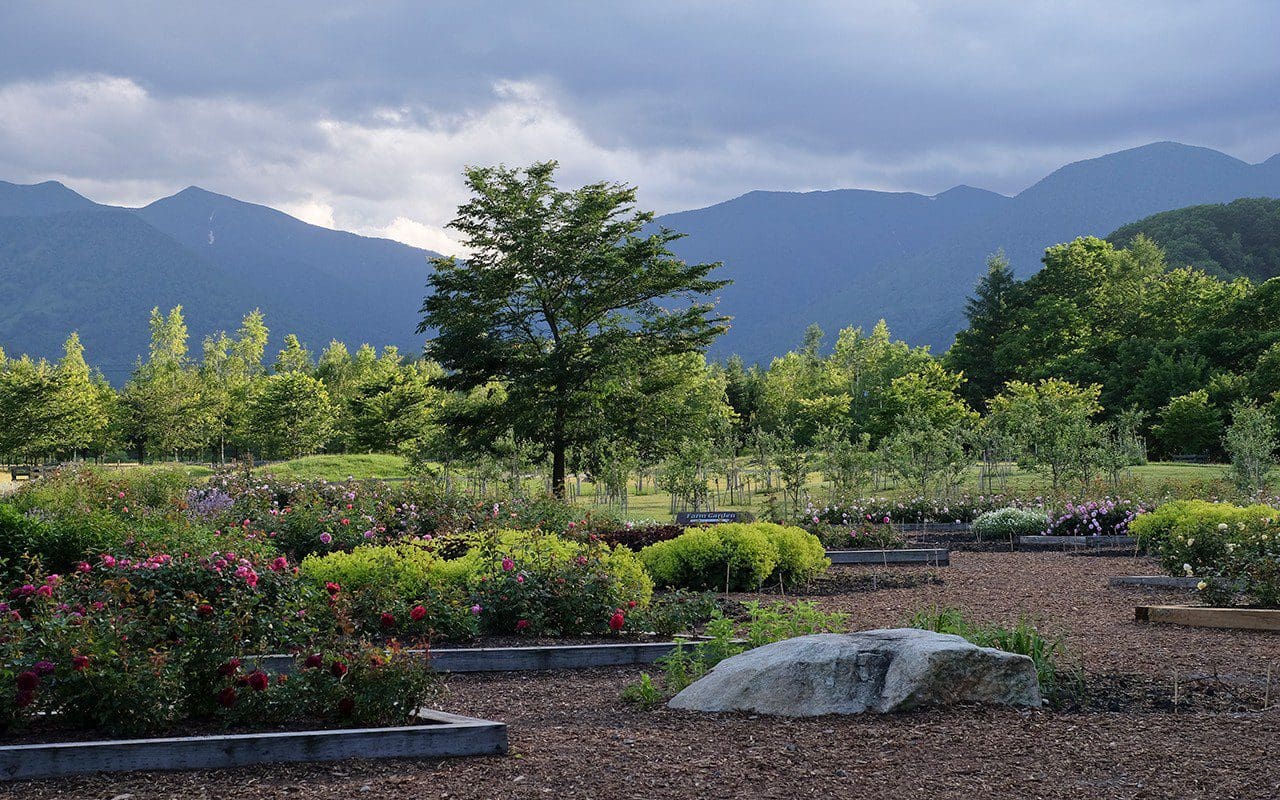 The Rose Garden
The Rose Garden
In their turn, the gardens we have since created have been key in making a ‘safe’ place and a link with the magnitude of the landscape, to literally ground the visitor in the place. A landform called the the Earth Garden, which reconfigured a clearance field that separated the visitor from the mountains, was the first of the projects to come to fruition. A series of grassy waves, echoing the undulations of the mountains beyond, now provides the visitors with a ‘way into’ the landscape. By exploring the earthworks they soon find themselves at the base of the mountains or at the edge of a mountain stream or a trail into the woods. The landforms extend to wrap another five hectares of cultivated garden, and area named the Meadow Garden, which was planted to celebrate the official opening ten years ago. Beyond that there is the Farm Garden where people can see a modestly-sized productive space with fruit, vegetables and cutting flowers and eat food grown there at the cafeteria. A goat farm producing cheese is the backdrop to this space, while most recently we have developed a Rose Garden of hybrid and species roses suitable for a northern climate and an orchard to test growing apples and other top fruit this far north.
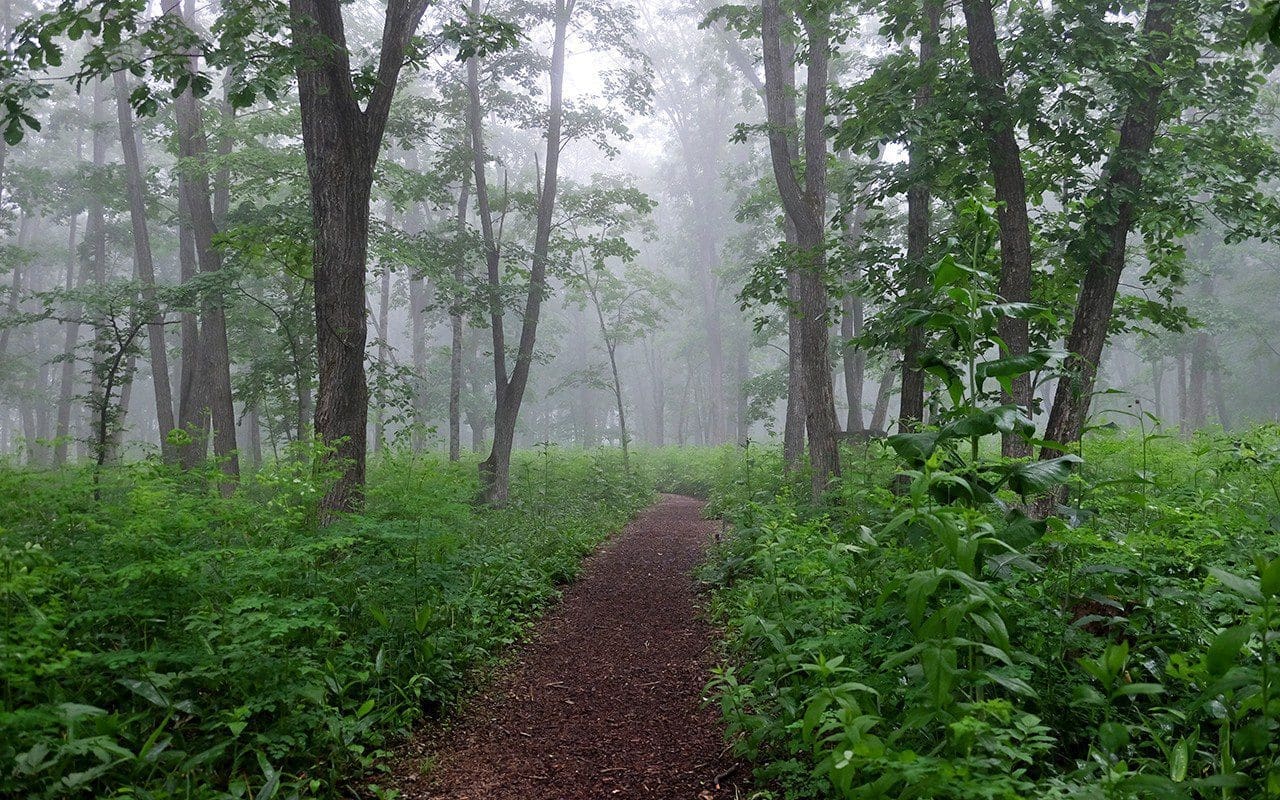
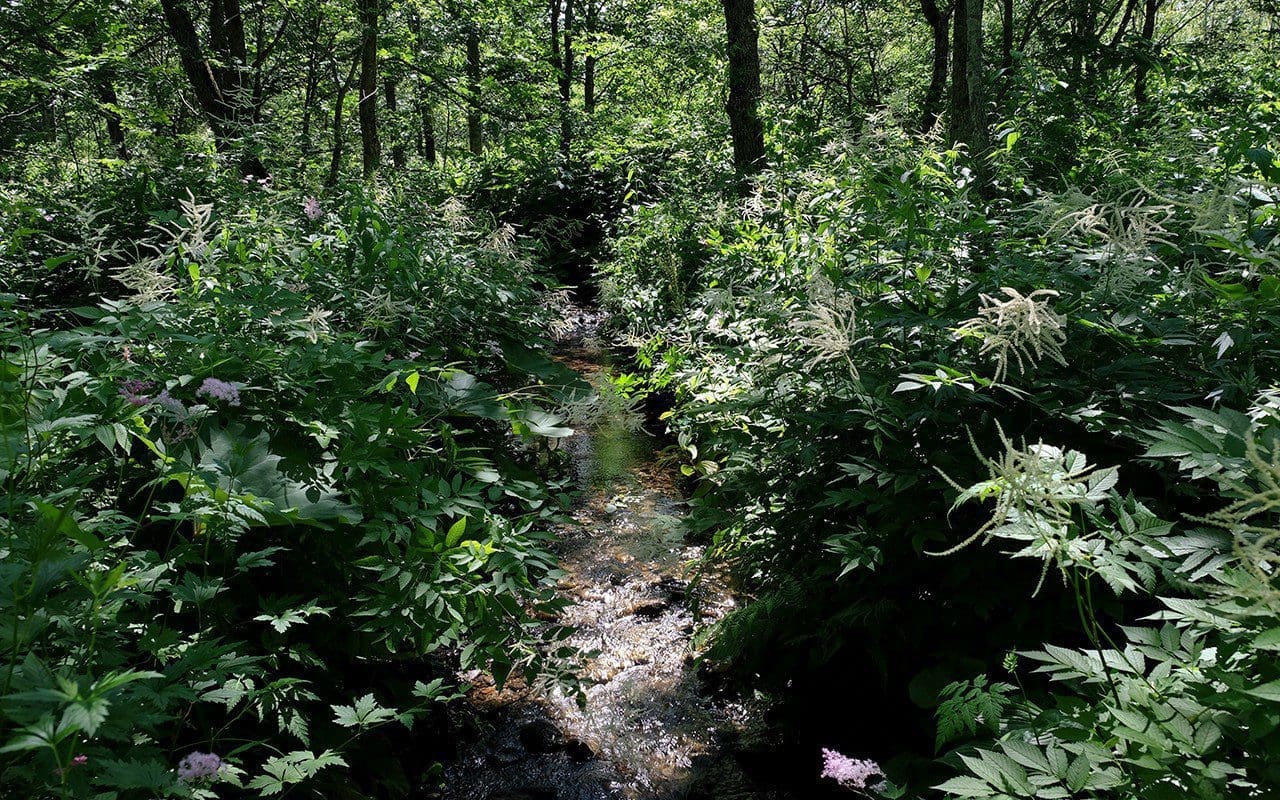 The Entrance Forest
The Entrance Forest
The Entrance Forest, where Fumiaki Takano had already made a start when I was brought on board, eases visitors in with soft bark paths and decked walkways that take them back and forth across the rush of mountain water that switches between the trees. The low native bamboo Sasa palmata, which took over the forest after its balance was disturbed when all of the oak was logged at the turn of the last century, has been carefully managed to encourage a more diverse regeneration of the forest floor. Repeated cutting in the autumn, coupled with the short summers that curtail its regrowth and stranglehold, has been diminished enough for the window of opportunity to be given back to other plants in the native seedbank. Wave upon wave of indigenous plants now greet the visitors. Anemone, Caltha palustris var. nipponica and Lysichiton camtschatcense seize the window after snow melt and, as oak woodland comes to life, the race continues with Trillium, scented-leaved and candelabra primulas and arisaema. By the time I arrived in late July, the woodland was tall with giant-leaved meadowsweet, cardiocrinum and lofty Angelica ursina.
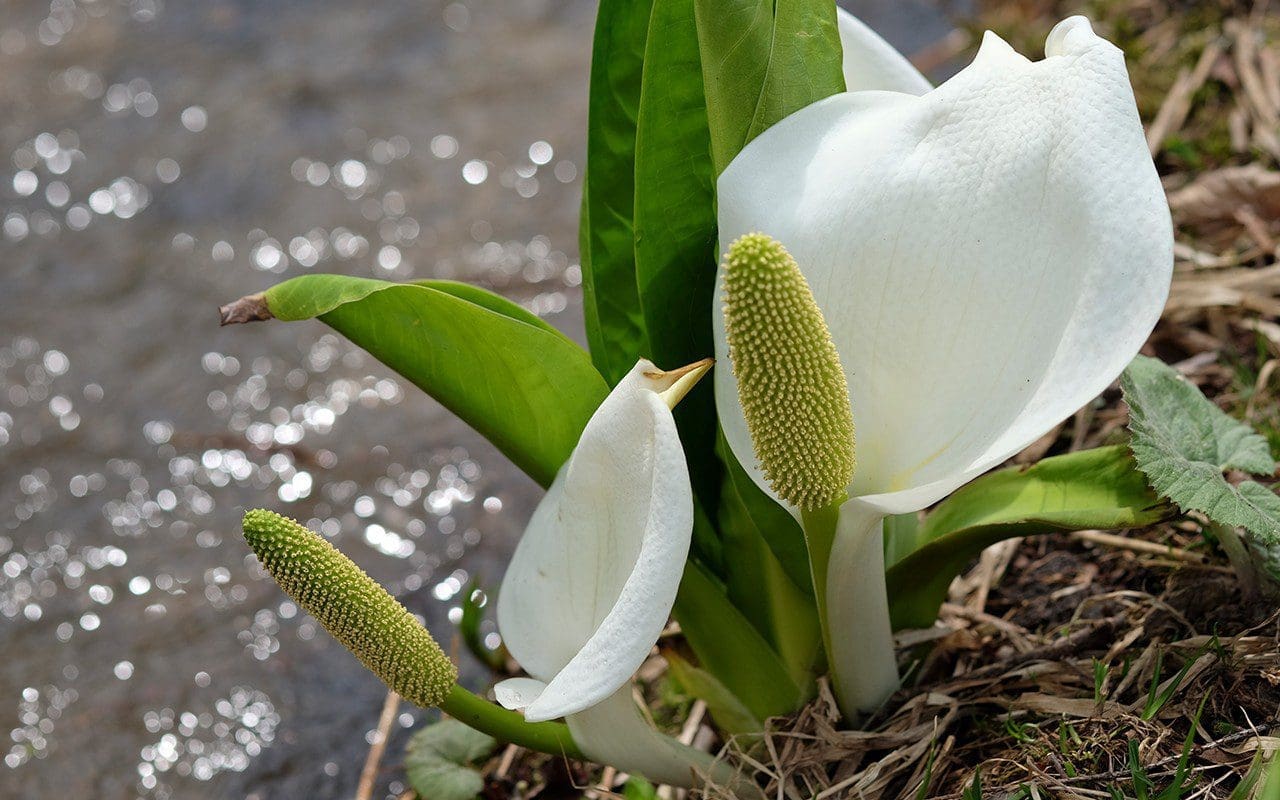 Lysichiton camtschatcense
Lysichiton camtschatcense
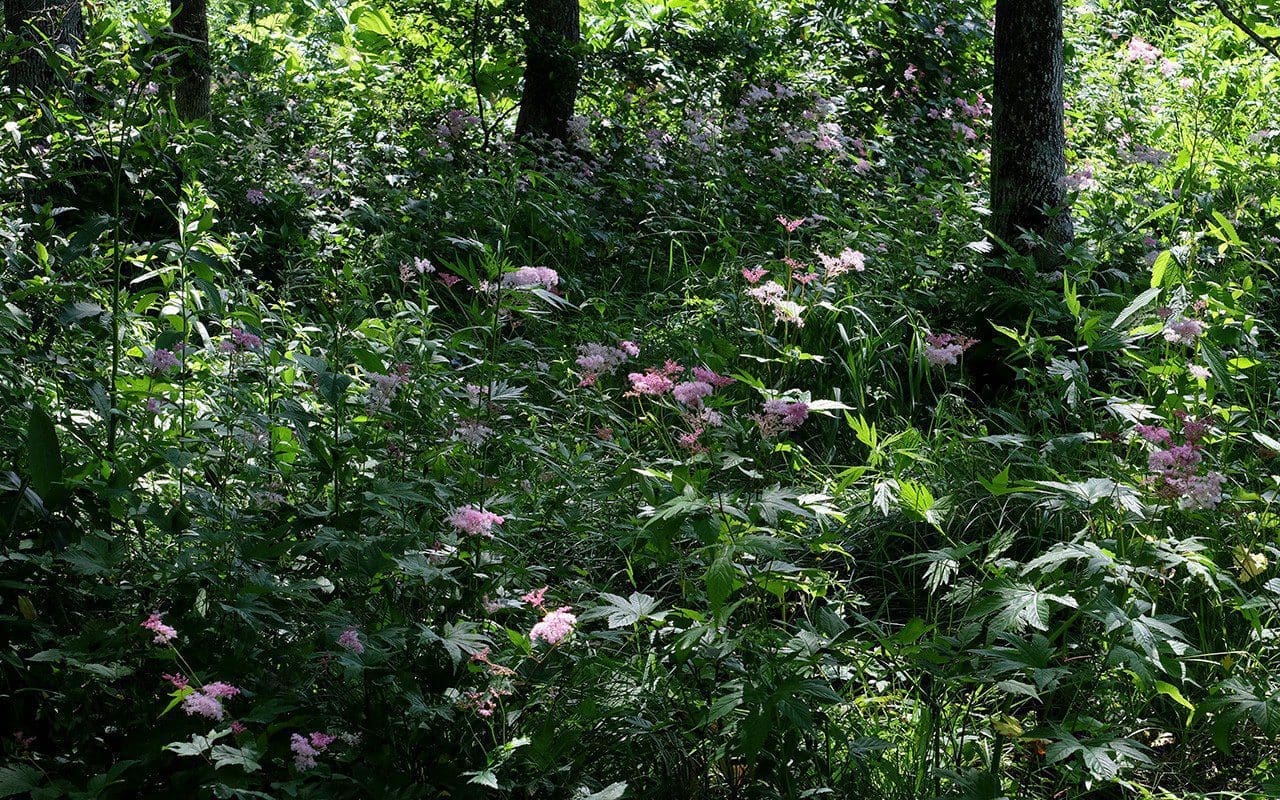 Filipendula camtschatica
Filipendula camtschatica
The Meadow Garden (main image), my primary focus with Head Gardener, Midori Shintani, was inspired by the woodland and the way the plants have found their niche and live together in successive layers of companionship. Sitting on the fringes of the wood where dappled light meets sunshine, it is divided into two main parts by a meandering wooden walkway. The lower areas emulate the edge of woodland habitats, while above the path the planting basks in full sunshine. The planting is further divided by swathes of Calamagrostis x acutiflora ‘Karl Foerster’, which separate the different colour fields, so that the yellows are held back as a surprise. The movement of the mountain winds is caught in their plumage to animate the garden.
The plantings integrate Japanese natives with plants from other regions of the world that have similar climates. North America and parts of northern Europe provide the ‘exotic’ layer in the garden and their inclusion draws attention to the Japanese natives that are mingled amongst them. Plants such as the Houttuynia cordata, Hakonechloa macra and Aralia cordata. Everyday plants in Japan that are given a new focus. In terms of my own gardening process, these plants were the exotics and it has been such a fascinating process to reverse my experience of the exotic/native balance. Native Lilium auratum, the Golden-Rayed Lily of Japan, and the giant meadowsweet, Filipendula camtschatica, are teamed with Phlox paniculata ‘David’. Sanguisorba hakusanensis, the extraordinary pink, tasselled burnet is in company with Valeriana officinalis and Astrantia major ‘Hadspen Blood’.
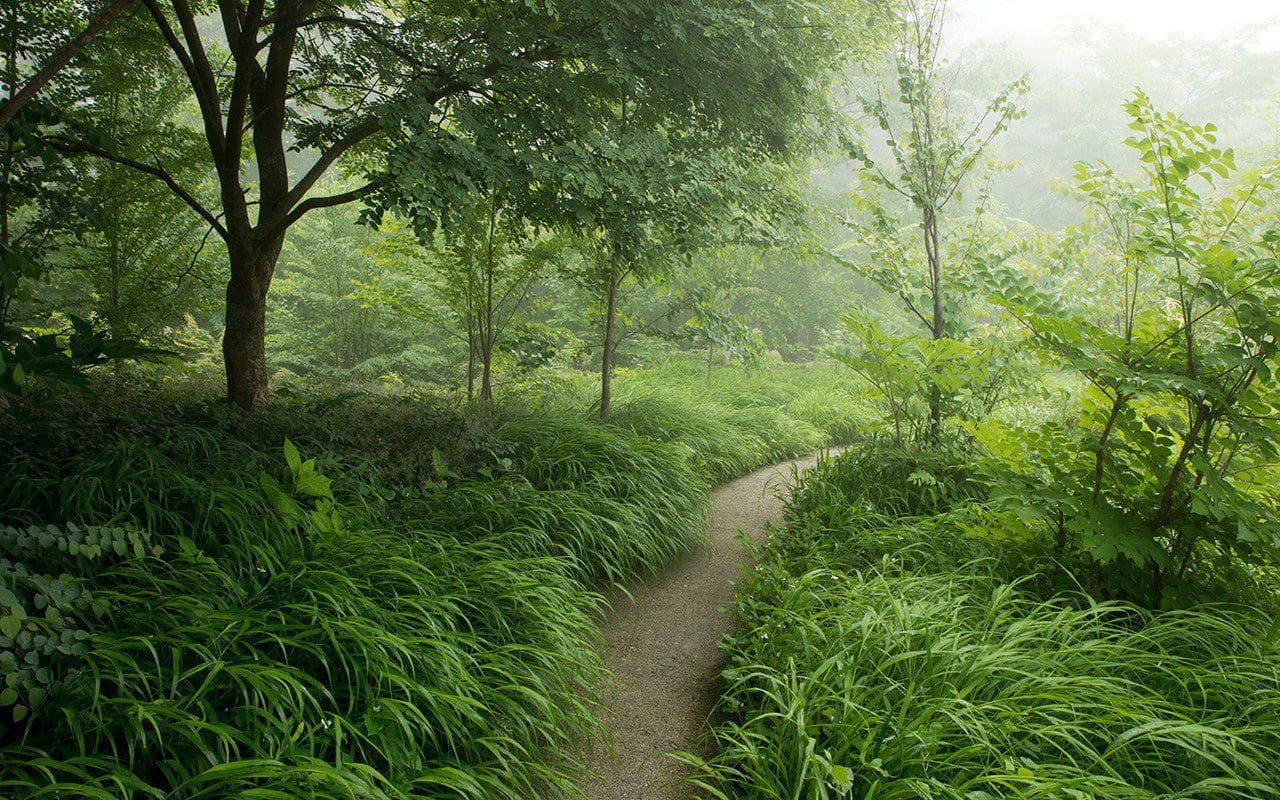 The woodland edge of the Meadow Garden with ground cover of Hakonechloa macra and Houttuynia cordata
The woodland edge of the Meadow Garden with ground cover of Hakonechloa macra and Houttuynia cordata
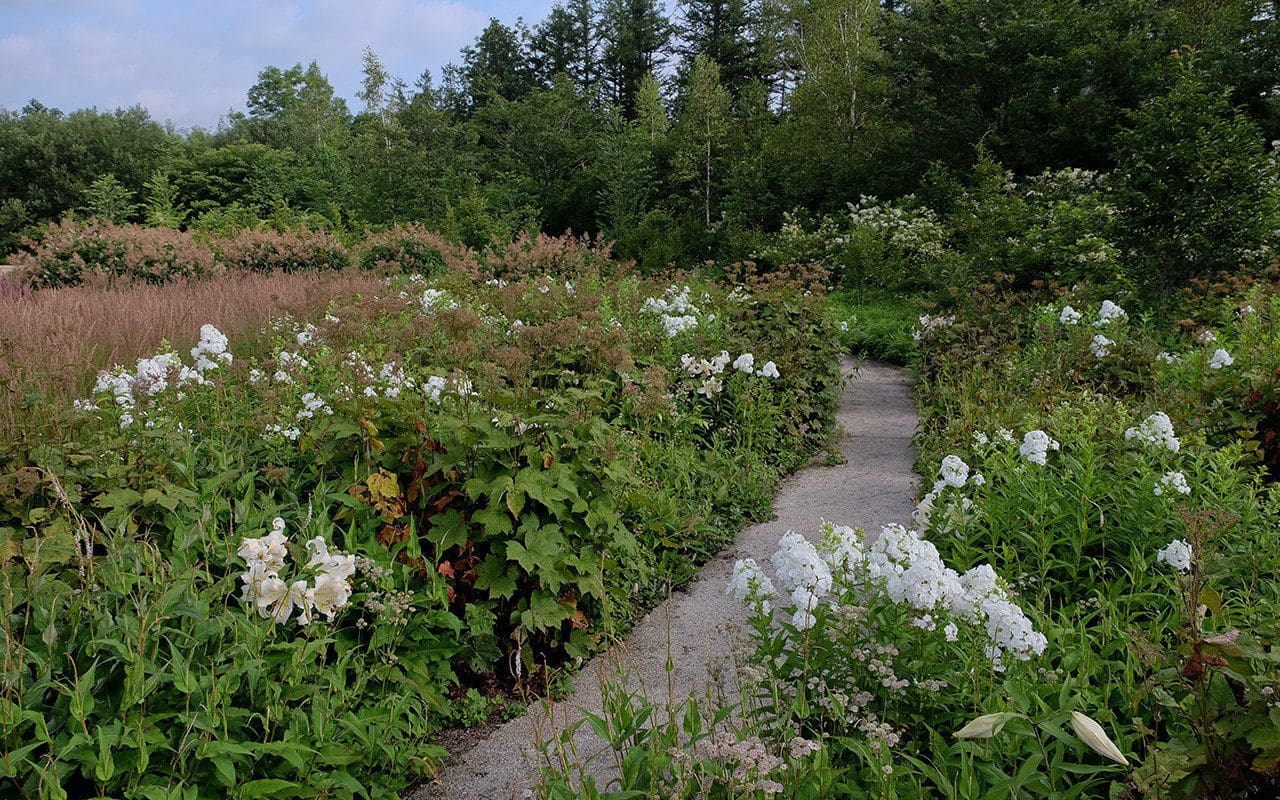 The woodland edge of the Meadow Garden with Lilium auratum and Phlox paniculata ‘David’
The woodland edge of the Meadow Garden with Lilium auratum and Phlox paniculata ‘David’
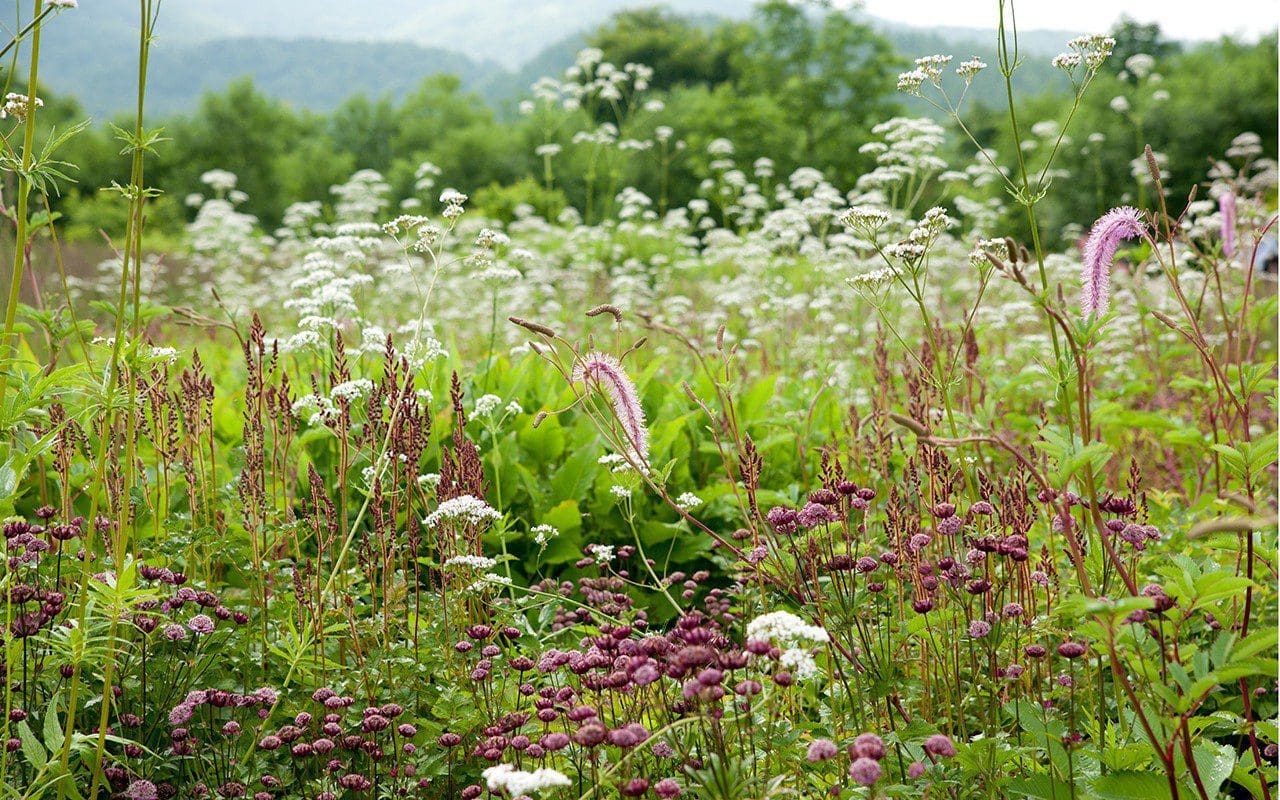 Sanguisorba hakusanensis, Astrantia major ‘Hadspen Blood’ and Valeriana officinalis
Sanguisorba hakusanensis, Astrantia major ‘Hadspen Blood’ and Valeriana officinalis
The original planting plans were designed as a number of individual mixes, planted in drifts to allow the planting to flow across the site. Each mix contained a small number of species, usually five to seven, that were planted completely randomly. The percentages in the mix were critical, with a small number of emergent plants such as the Cephalaria gigantea to rise above larger percentages of individuals that would knit and mingle at lower and mid-level. Now that I look back it was a brave move, because it was entirely dependent upon the head gardener to steer and monitor.
Midori has been more than I could have hoped for in an ally on the ground and our yearly critique and analysis of the plantings is a high level conversation that looks both at the big picture and also at the detail. Of course, there have been adjustments to refine each mix as they change yearly with plant lifespans, climate and vigour, which drive our response. But we have also needed to make changes to keep the garden moving forward, introducing new plants and swapping or reducing the numbers of those which have become dominant. For instance, we have found plants that will happily coexist in a demanding matrix of twenty five companions in the wild, can take their opportunity to dominate when given just a handful of company.
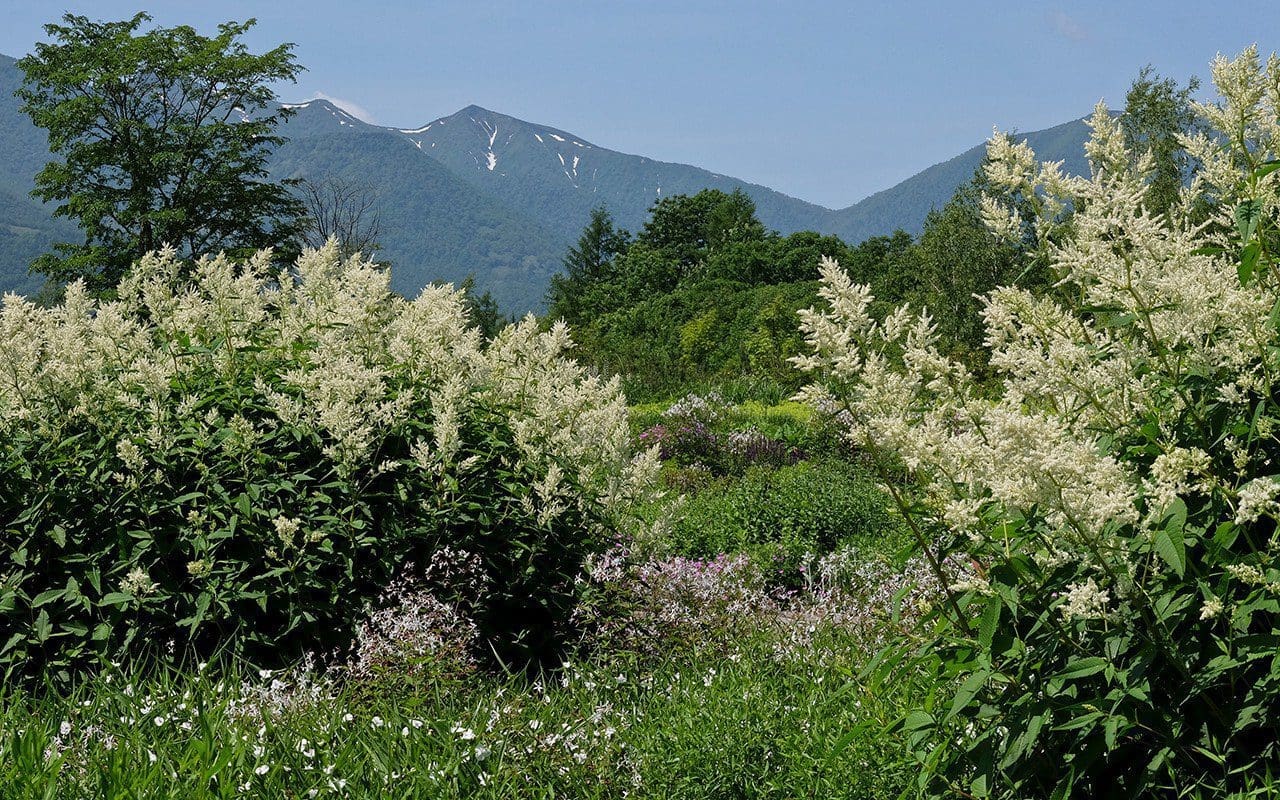 Persicaria polymorpha and Gillenia trifoliata
Persicaria polymorpha and Gillenia trifoliata
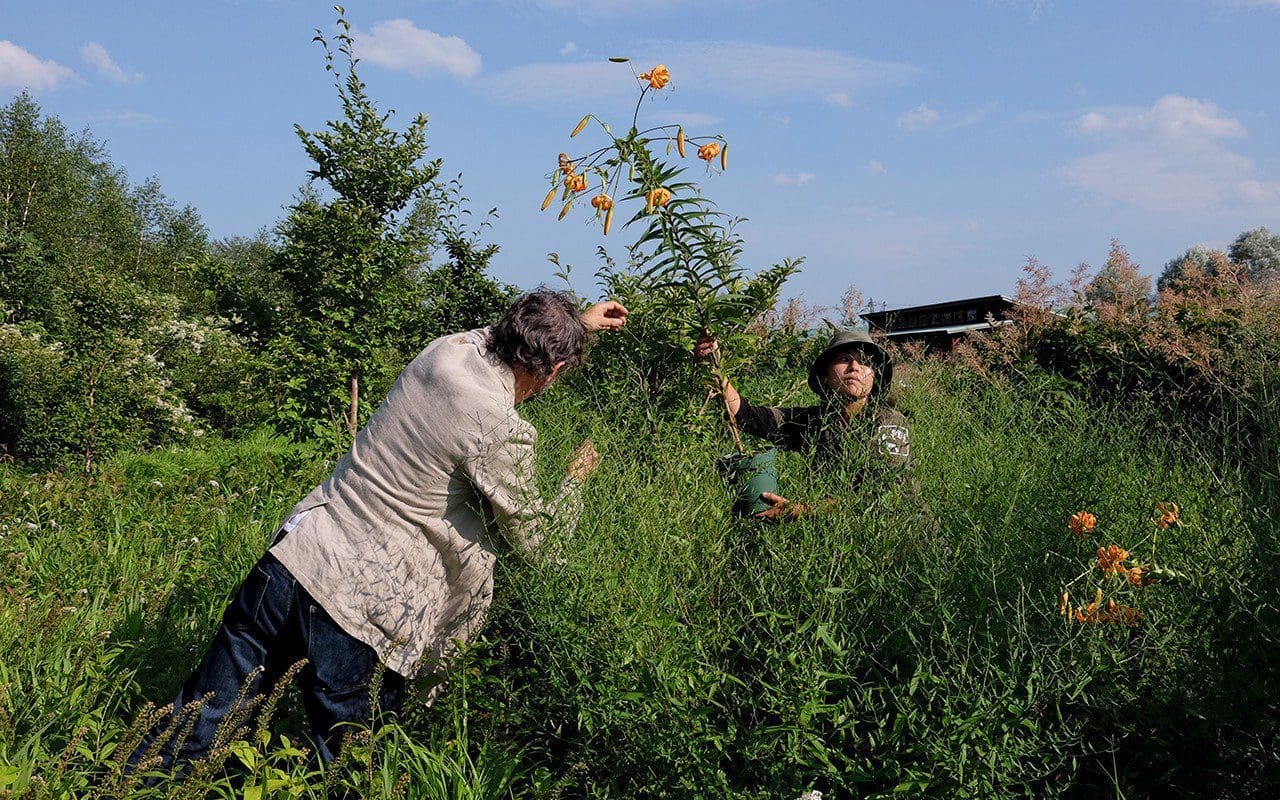 Dan placing new additions of Lilium henryi with Head Gardener, Midori Shintani
Dan placing new additions of Lilium henryi with Head Gardener, Midori Shintani
Last year, to challenge the thousand year brief of sustainability, a tornado swept across the island. It hit last summer, just before I visited and I arrived to see the carnage. The mountain water had swelled the streams that braid the site to rip and tear and deposit a silver sand from afar and boulders that are now new features. Miraculously the waters divided to either side of the Meadow Garden, but they swept away all but two of the bridges, which have never been found. We were left feeling very small and of little consequence within the time frame that had been set for the preservation of this place.
The repairs have been slow but sure and in scale with what is possible. New shingle banks have been embraced as the new places and opportunities that they are. Already they are being colonised. It is the gardener’s way to repair and to move on, but we have been humbled nevertheless. Midori walked me through the garden, pointing out ‘weeds’ that have been swept in to the planting that were never there before. And there are anomalies that are hard to get to grips with that point to changes of another scale. Some plants have taken a hit a year later to sulk or fail, and we do not know why, whilst others have seized life with a new vigour as if the charge from the mountain has revitalised them. With ten years under our belts and the knowledge we have gained that is specific to this place, we are adjusting again and moving on. On to a second decade and the certain changes that we will be responding to, to move with it.
Words: Dan Pearson / Photographs: Kiichi Noro and Syogo Oizumi
Published 16 September 2017
Planting the fruit orchard was one of our first major projects the winter we arrived here. I knew where I wanted to see it almost immediately, on the south-facing slopes beyond the barns to the west. Nestled into the hill, it was to continue the spine of productivity that runs along this contour. House, vegetable garden, barns, compost heaps and then orchard. It had a rhythm to it that felt comfortable.
Later, and after it was planted, neighbours told us that there had once been fruit trees growing on the same slopes, so it was right to have made the move so quickly. I’d been wanting to plant an orchard for myself for years and made my lists with relish, choosing West Country apples, both cookers and eaters, and a number of pears and plums. I paced out the planting stations in an offset grid with 8 metres between the trees. Doing it by eye meant that it went with the slope and the grid took on a more informal feeling that was less rigid.
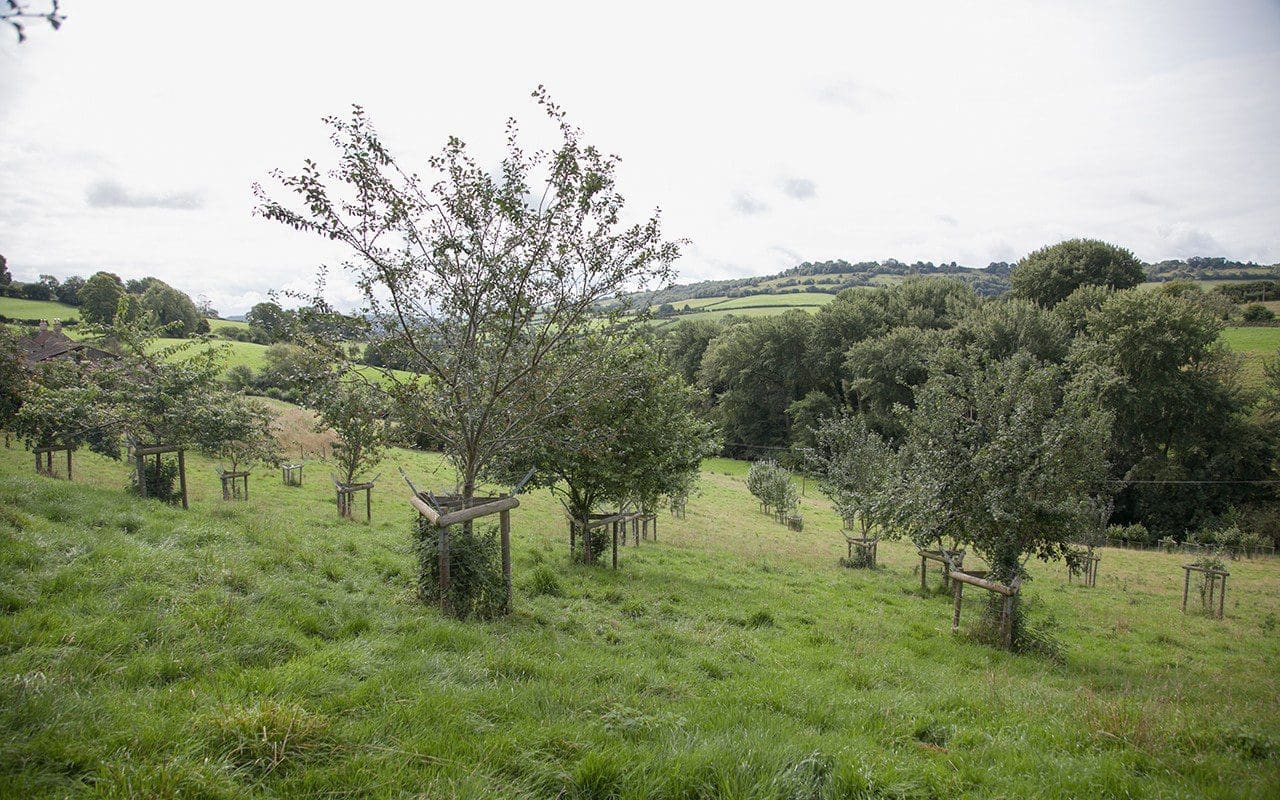 The Plum Orchard
The Plum Orchard
Thirteen apples were set on their own on the lower slope, whilst five pears and then the plums sat above them. In making the decision as to how the orchard should step across the slope, I noted how the frost settled and where the cold air drained as it pooled lower in the hollow. The pears, which like a warm, sheltered position, were planted up close to the barns in the lea provided by the hedge and the buildings. The later-flowering apples were placed lower down the slope in the hope that the frosts, which tend to hang low, were mostly over by the time they were in blossom. The early-to-flower plum orchard was put on the highest ground that linked to the blossom wood in the next field above, as they also prefer a warm, free-draining position. Here they have so far escaped the frosts. To date, for there is still always time to learn, I am happy to have gone with my intuition.
The plum orchard is a loose term for the collection of a dozen or so trees that now inhabit this top corner of the field. I say loose because they all have different characteristics that are driven by the original species from which they have been selected, or from the cross between the edible species. So, to explain, the plum orchard includes true plums, mirabelle plums, damson plums and greengages. We also have two bullace, an old term for a wild plum. Three yellow ones, given to us by a local farmer who has them growing in the hedgerows above our land, are planted in the hedge between the plum orchard and the blossom wood. They may be ‘Shepherd’s Bullace’ or ‘Yellow Apricot Bullace’, two old named varieties that were once very commonly grown. These make a link to an ancient, gnarled tree by the barns, which is dark violet and eats like a damson. The cherry plums (Prunus cerasifera) sit in the blossom wood itself.
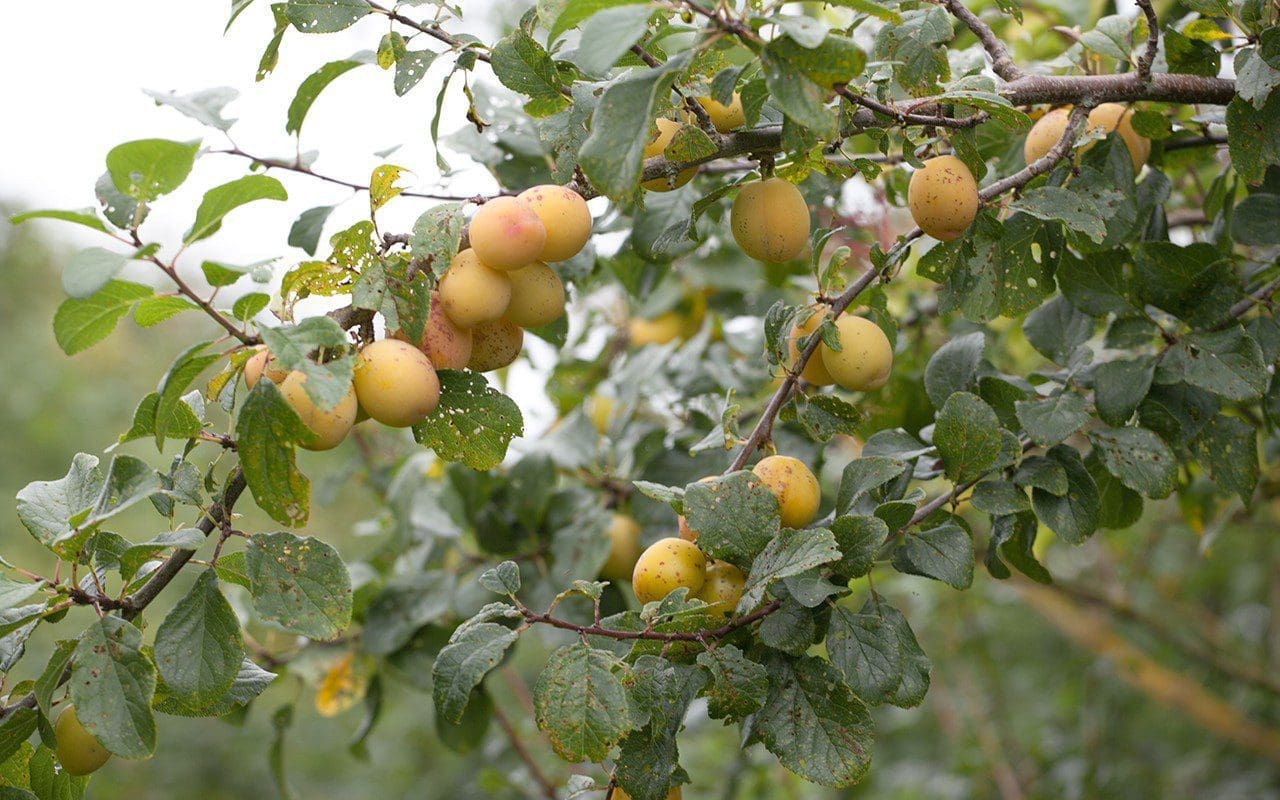 Yellow bullace
Yellow bullace
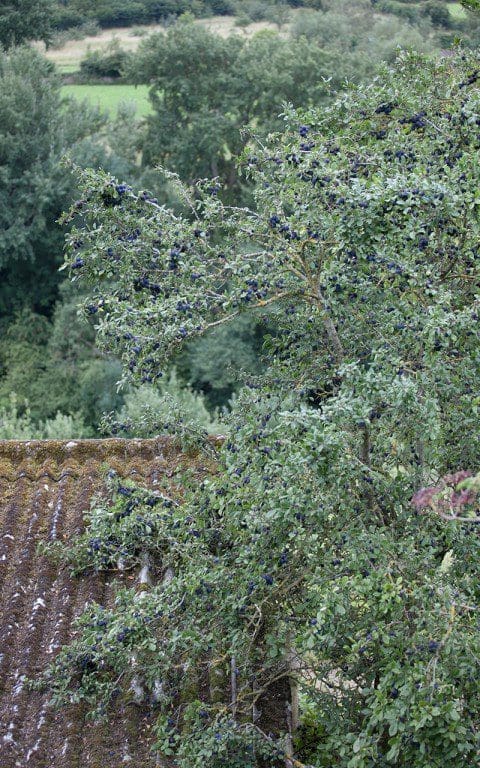
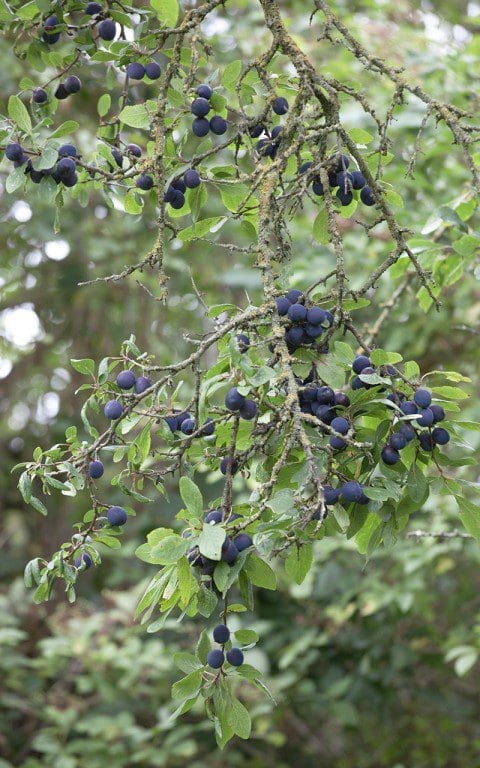 The old black bullace by the barns
The old black bullace by the barns
First to flower, and indeed to fruit, are the cherry plums, which are good both for February blossom and jam making. Their flavour reminds me of the perfumed Japanese ume plums and we have in the past made a delicious plum brandy from them. In the orchard it is the mirabelle plums (first recommended to me by Nigel Slater, who grows them at the end of his garden) that are the first to flower and fruit. Originally from Eastern Europe, but grown to perfection in France, this is a small plum, usually with a tart flavour. Generally preferred for cooking, ‘Mirabelle de Nancy’ has marble sized, apricot-coloured fruit which are fragrant and sweet enough to eat off the tree if picked just before they drop. ‘Gypsy’, with larger red fruit, is a cooker and the earliest of them all, ripe almost a month ago. If I were to lose one, it would be ‘Golden Sphere’, whose flavour is bland in comparison, but it is a pretty plum, well-named for its colour.
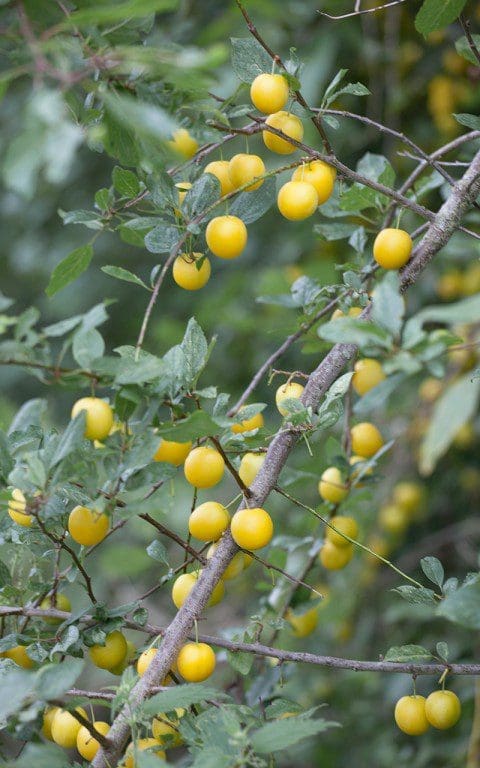 Cherry plums
Cherry plums
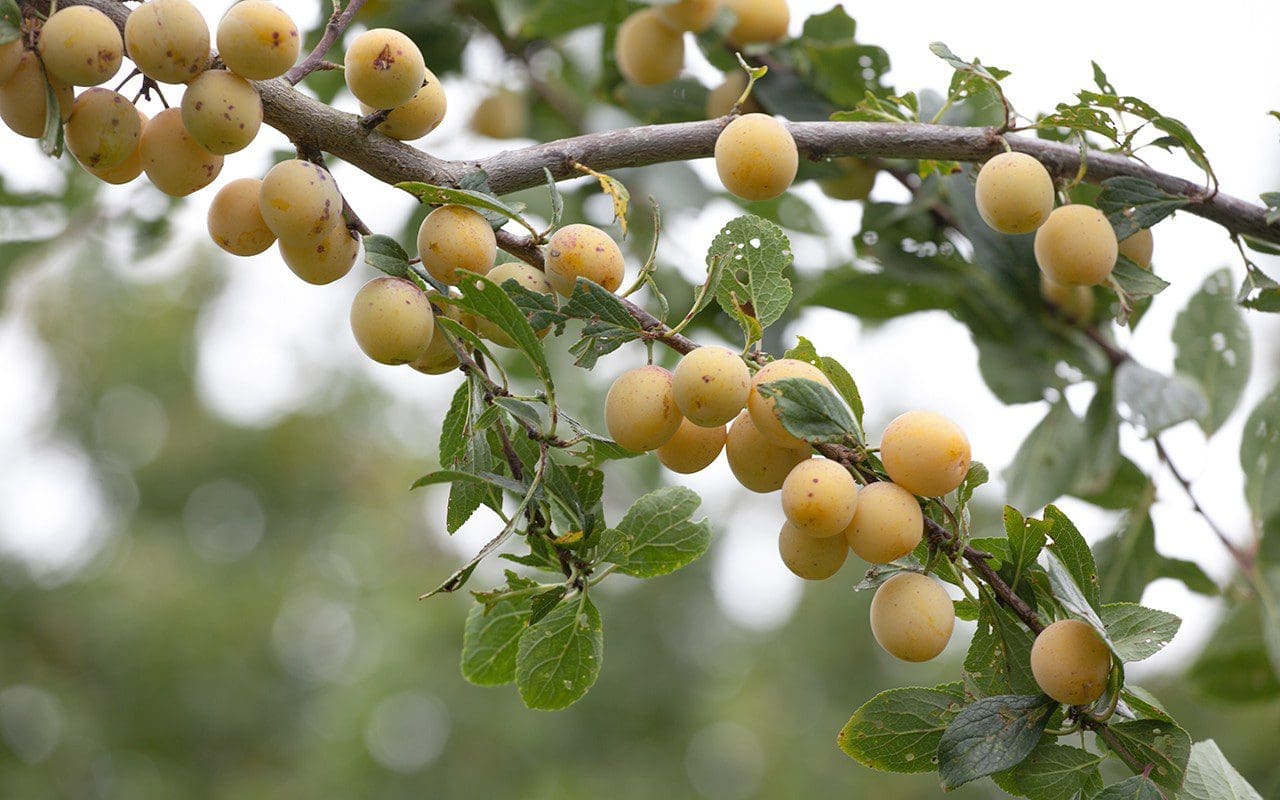 Mirabelle de Nancy
Mirabelle de Nancy
If I were only able to have one plum tree, it would be a greengage. As a rule, the yellow plums are said to have better flavour than the reds, but greengages are the most aromatic and, in our opinion, the most delicious. Of course, there is a small price to pay for such a delicacy, as greengages have a reputation for being shy to fruit. I have five in the orchard. ‘Early Transparent’ is the most reliable and has fruited plentifully. ‘Denniston’s Superb’ fruited well this year too and has the very best flavour. Despite the skins being less than perfect, the greengage perfume and the depth of flavour of this greengage is superlative – as refined and floral as a good ‘Doyenne de Comice’ pear or, if you were living in heat, a freshly picked white peach. I have three more greengages that are yet to prove themselves; ‘Reine Claude de Bavay’, which is famously shy to fruit, ‘Bryanston Gage’ and ‘Cambridge Gage’, which the sheep have managed to reach, pulled at and damaged, so I am waiting patiently for results next year.
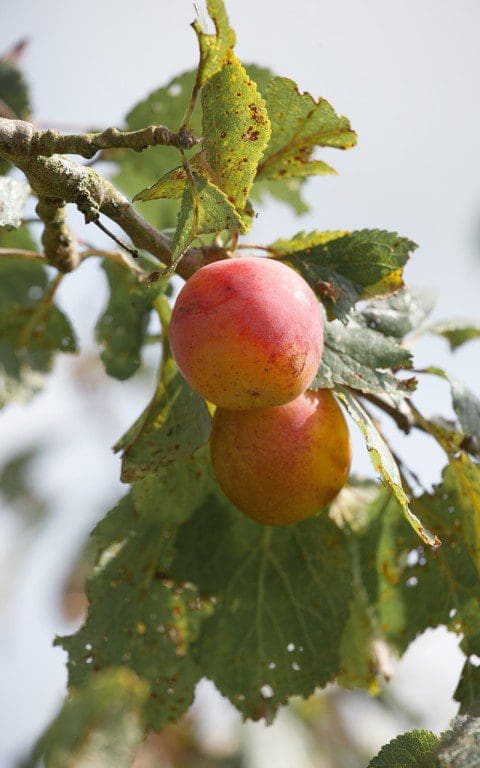 Gage ‘Early Transparent’
Gage ‘Early Transparent’
We have two true plums in the orchard. ‘Victoria (Willis Clone)’, a selection that is reputedly free of silverleaf, an airborne bacteria to which ‘Victoria’ is prone and which can infect broken branches in the summer. Plums, particularly the heavy fruited ‘Victoria’, are famous for snapping under the weight of their fruit, so I have taken to gently shaking the tree a little earlier in summer to lighten the load that the June Drop hasn’t done for. Though the ‘Victoria’ is a good looking plum – it is next to ripen after the greengages – it is nice but rather ordinary. It is, however, indispensable for freezing for winter crumbles. ‘Warwickshire Drooper’, a vigorous and amber-fruited plum, is better I think. Adaptable for being both an eater and a cooker, and not a plum you can buy off the shelf like ‘Victoria’. It is also a very heavy cropper and makes delicious jam.
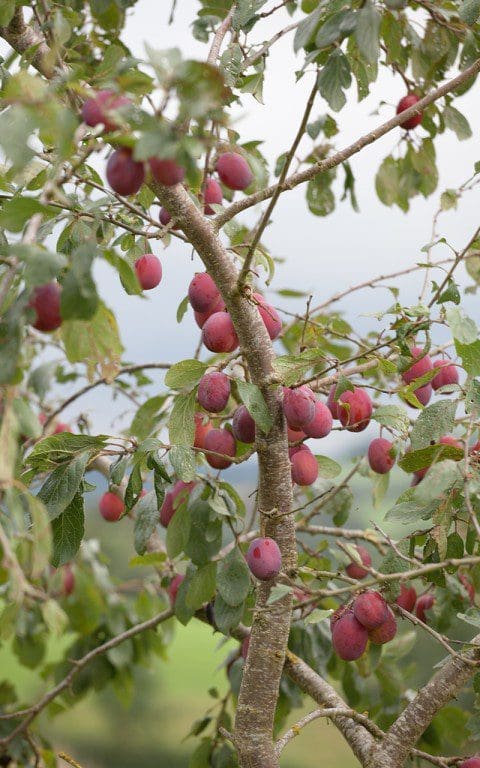 Plum ‘Victoria (Willis Clone)’
Plum ‘Victoria (Willis Clone)’
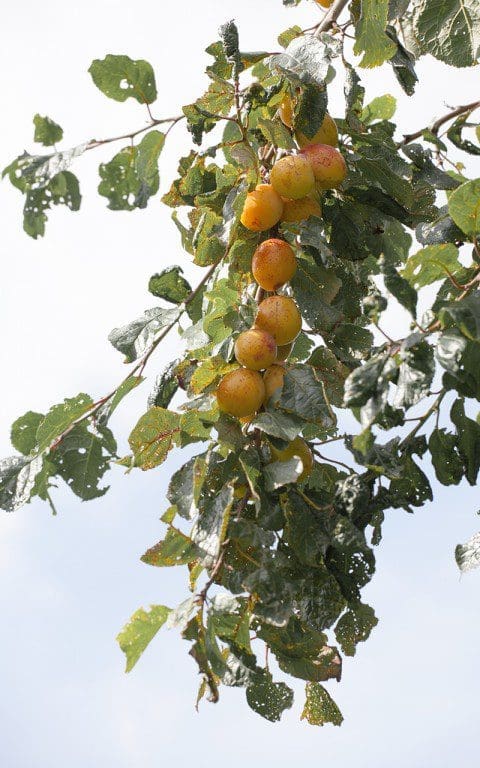 Plum ‘Warwickshire Drooper’
Plum ‘Warwickshire Drooper’
The damsons are perhaps the most beautiful, hanging dark and mysterious, with a violet-grey bloom that, when you reach out and brush the surface, reveals the depth of colour beneath. These are the last to fruit and this year I fear we will miss them in the fortnight we go away on holiday in early September. ‘Shropshire Prune’ (main image) has proven itself to be one of the most reliable fruiters with small, perfumed fruit that are firm and make the strongest flavoured jam. A little earlier and larger of fruit, ‘Merryweather’ also has very good flavour and is one of the only damsons sweet enough to eat from the tree if left to fully ripen.
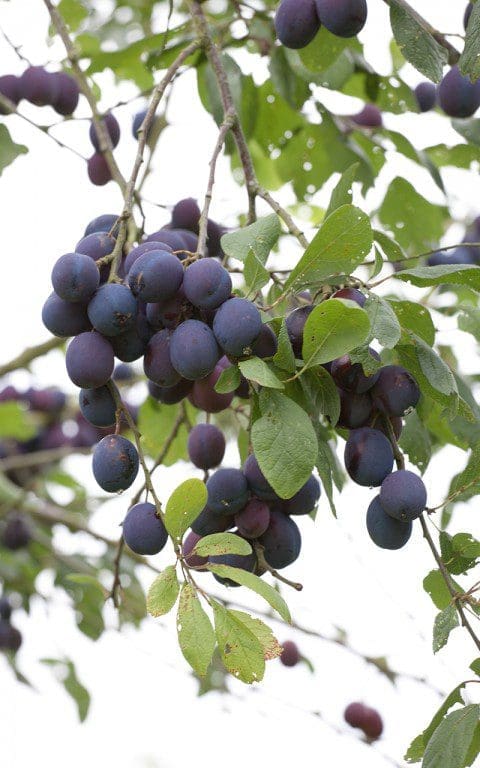 Damson ‘Merryweather’
Damson ‘Merryweather’
The plums are something you have to watch as they ripen, for they take some time to ready but, when they do, they all ripen over the space of a fortnight. The range of varieties in the plum orchard helps here in staggering the harvest, but getting to them before the wasps do is always a challenge. This year, however, we are bombarded with fruit which means there is plenty to go round, and I have been heartened to see that the rotting fruit also provides a late summer larder for honeybees and butterflies. I have a long, three-legged ladder with an adjustable third leg ideal for picking on our slopes but, for expediency, it has been quicker to lay down tarps on the hummocky grass and gently shake the trees. The fruit cascades around you and you can pluck the best without reaching into the branches to be stung by the competition.
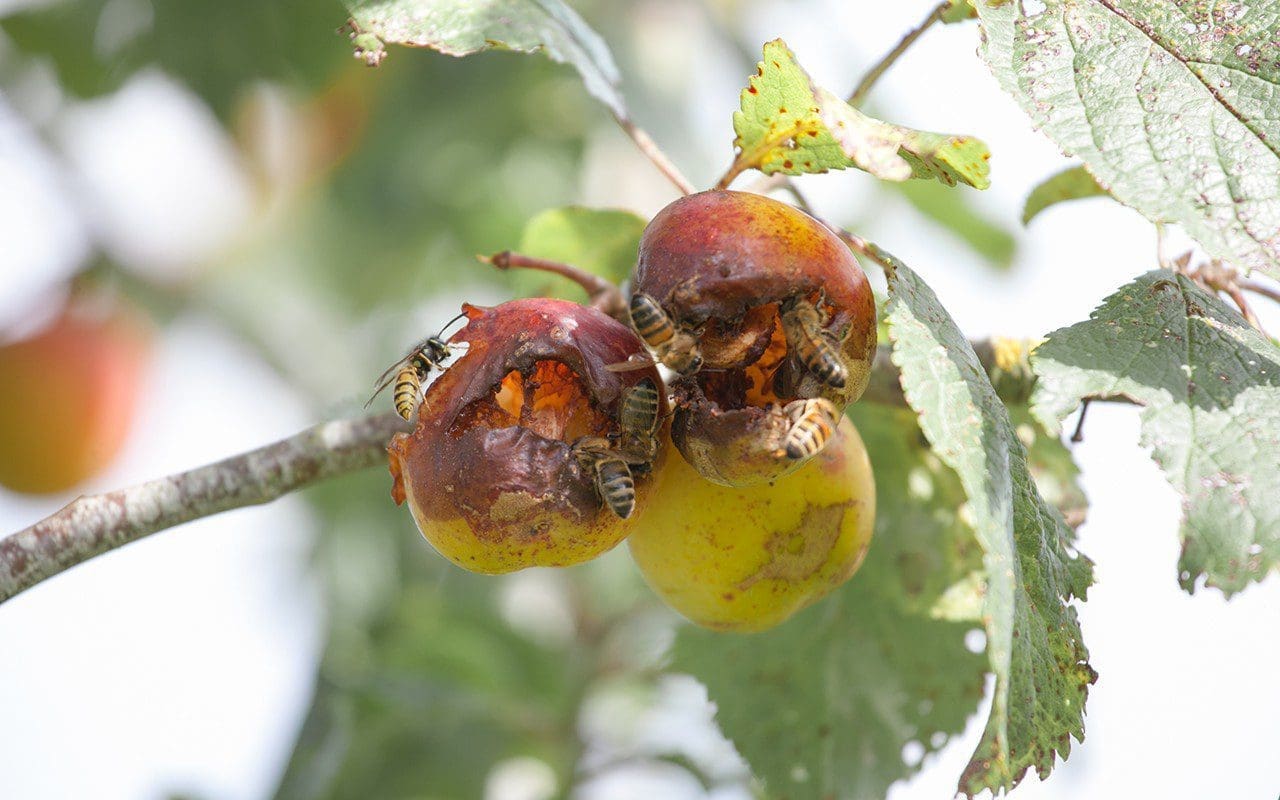
Words: Dan Pearson / Photographs: Huw Morgan
Published 26 August 2017
We are sorry but the page you are looking for does not exist. You could return to the homepage